
Select a Language
- Start a Moving Truck or Van Reservation
- All Deals & Promotions
- View/Modify/Cancel
- Get a Receipt
- One-Way Car Rentals
- Month or More Rentals®
- Cars, SUVs, Trucks, Minivans & Vans
- Moving Trucks & Vans
- Exotic Cars
- Dealership & Service Rentals
- Rent a Car After an Accident
- Payment Options
- Rental Coverage
- Solutions for Business
- Enterprise Truck Rental
- Dealership Solutions & Technology
- ARMS® Dealership
- Manage Your Fleet
- About Enterprise CarShare
- Start CarSharing
- Life at Enterprise
- Total Mobility Solutions
- Community & Sustainability
- Enterprise Mobility
- Enterprise Plus® Program
- Join Enterprise Plus®
- Complete Your Enrollment
Inspiration
- Travel & Lifestyle
- Sustainability
- Renewable Fuel Research
- Canada Car Rental Locations
- International Car Rental Locations
- Enterprise Truck Locations
- CarShare Locations
- Exotic Car Rental Locations
- Fleet Management
- Enterprise Business Rental Program
- Mileage Reimbursement Calculator
- Get Answers
Algonquin Provincial Park Inspires New Beginnings
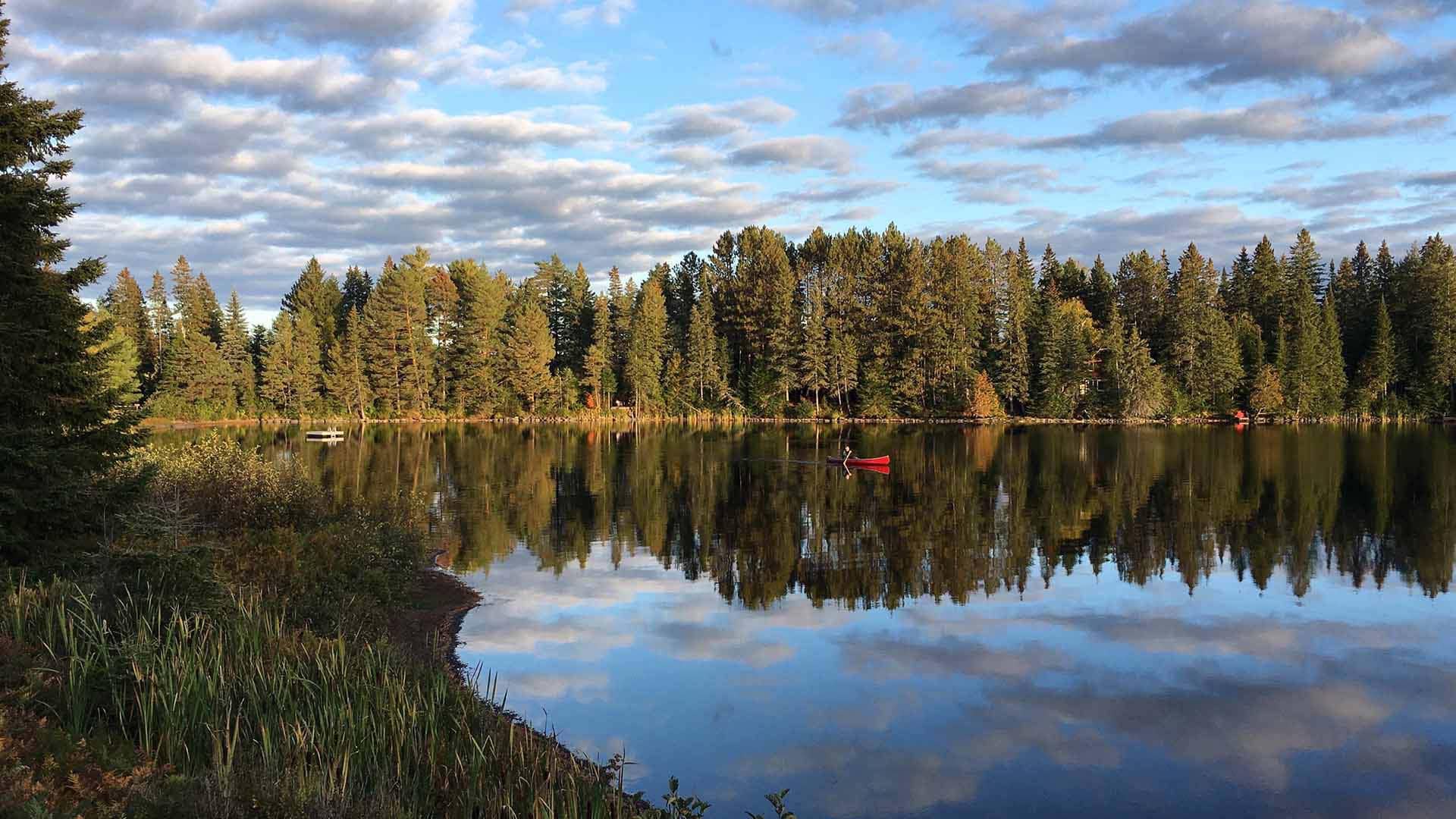
A man canoes in the Lake of Two Rivers at Algonquin Provincial Park.
Story and photos by Charles Williams
Charles is the editor for Pursuits with Enterprise. Email the author.
Ontario’s largest provincial park influenced some of Canada’s most iconic art.
Frost-tinged fall leaves. Geese flying in formation. Pine trees silhouetted against a lake. The vibrant Northern Lights. Tom Thomson’s paintings capture the essence of a place—and the soul of a country.
In the early 20th century, Thomson helped launch the first major artistic movement in Canada. He died mysteriously at age 39 on Canoe Lake in Algonquin Provincial Park , but his influence still resonates more than a century later.
I am intrigued by Thomson because I believe paintings have the power to inspire creativity, change attitudes and create artistic movements. Thirty years after completing my fine arts major, I’m still searching for my place in the art world, somewhat remorseful that I chose practical career fields over one that fed my spirit.
Great art, or a place that inspired it, makes me feel young and idealistic again. I felt that way on a recent trip to Algonquin, where Thomson’s brushstrokes captured the ruggedness of an untamed land—the frigid lakes, vivid leaf colours and tall Jack pines. It was a landscape that I wanted to experience firsthand.
I rented a car in Ottawa and drove three hours to the park’s entrance. Highway 60 cuts through Algonquin for 56 kilometres. Because the one-hour drive passes through conifer and hardwood trees, in September and October it’s one of Canada’s most spectacular road trips.
Created in 1893, Algonquin is the oldest provincial park in Canada and the largest in Ontario. An easy day’s drive from Toronto, Ottawa or Montreal, it’s also one of the most popular.
Algonquin covers 7,630 square kilometres, roughly the same size as Delaware and Rhode Island combined. Much of the park is unspoiled backcountry that contains 2,400 lakes. Canoeing to remote camping destinations, something Thomson did frequently, is still a popular activity.
The Group of Seven
Thomson first travelled to Algonquin in May 1912. He liked to paint sketches of the landscape on small birchwood panels. During winter months, which he spent in Toronto, he used the sketches to create finished paintings. “The Jack Pine” and “The West Wind” are considered some of Canada’s most iconic works.
After Thomson’s unexplained death in 1917, other Canadian artists—some of whom had visited Algonquin with him—formed the Group of Seven in 1920. The artists included Franklin Carmichael, Lawren Harris, A.Y. Jackson, Frank Johnston, Arthur Lismer, J.E.H. MacDonald and F.H. Varley. Inspired by Thomson’s work, the Group of Seven believed that a distinct Canadian art style could be developed by working among nature. They subsequently became famous for their paintings of Canadian landscapes.
Exploring Algonquin
I explored Algonquin in autumn so I could see the colourful landscapes as they appear in Thomson’s paintings. The Algonquin Visitor Centre was my first stop. Although the Group of Seven didn’t focus on wildlife, I learned that 4,000 moose, 150 Eastern wolves and 2,000 North American black bears live within the park.
A ranger recommended two trails that offer outstanding views of the changing leaves. On the eastern side of the park, the popular Lookout Trail is a 2.1-kilometre loop through the forest to the top of a high cliff. From this vantage point, I saw trees with green, red and yellow leaves surrounding three lakes.
On the western side of the park, the Hardwood Lookout Trail is a one kilometre loop and passes through forests of red sugar maple and yellow birch.
Next, I headed to the Algonquin Logging Museum , which showcases life at an early Canadian logging camp. A 1.2-kilometre hiking trail features a stop at a camboose shanty, living quarters for 52 White Pine loggers, with no shower! A steam-powered “alligator” tug boat, once used to move logs across water, rests near a lake. Thomson painted several scenes of logging structures and activities in 1916, when he worked as a fire ranger in the park. His influence also is still evident at the Algonquin Art Centre, which showcases some of Canada’s foremost wilderness and wildlife artists.
Staying in the Park
Algonquin offers 1,900 campsites and three lodges: Killarney Lodge , Arowhon Pines and Bartlett Lodge .
Killarney Lodge was built in 1935 and has been family owned ever since. The rustic lodge occupies a peninsula that juts out into the Lake of Two Rivers. Cozy lakeside cabins include free access to private canoes.
Killarney also features a romantic dining room with an original fireplace that dates back 85 years. Dinner here is an intimate experience. I devoured asparagus and Brie-stuffed chicken wrapped in bacon and covered with a chardonnay cream sauce. Delicious.
The next night, I stayed at the more remote Arowhon Pines, founded by Lillian “Granny” Kates. The feisty proprietor hired and fired four architects before choosing Charles Coleman to design the hexagonal-shaped building, which features a central stone fireplace with an iron chimney that rises more than nine metres to a cathedral ceiling.
In the 1930s, two local woodsmen built the magnificent dining room. Since 2002, chef David Cooke has been creating exceptional meals for guests, including my highly enjoyable dinner of baked halibut with a parmesan and herb crust, drizzled with chive butter sauce. A fitting—and filling—way to end the day.
Memories of Algonquin
On my final morning in Algonquin, I awoke to a peaceful stillness that filled the air. I grabbed a canoe, slipped it into the glass-like waters of Little Joe Lake and paddled slowly toward the distant shoreline. As a light breeze picked up, the water became choppy, slapping rhythmically against my canoe. I paddled harder, trying to move forward.
One hundred years has passed since Thomson and the Group of Seven captured the timeless beauty of Algonquin. I had driven through the park, hiked its trails and bedded down in its lodges. But in the canoe, out on the water, I sensed the greatest connection to the land. In that moment, I felt emboldened by Thomson’s work.
I stopped paddling, stopped fighting the current. I let myself drift quietly past red sugar maples and yellow aspens. Several loons swam nearby. Then they started to wail, a haunting call they make to re-establish contact after becoming separated.
I took that to heart and decided to reconnect with my artistic impulses, to begin laying a path toward a more purposeful life. Sometimes, you move forward by letting go.
1 / total Hardwood Lookout Trail view
2 / total Killarney Lodge
3 / total “Alligator” tug boat at Algonquin Logging Museum
4 / total Canoes at Arowhon Pines
5 / total A river near Lake Opeongo
6 / total Boats at sunset
7 / total A man canoes past Killarney Lodge.
Read more stories about Ontario, Canada.
Niagara Falls’ Spectacular Beauty is Timeless
Lovers, families and risk-takers converge at a water wonderland.
Algonquin Park Scenic Drive
Ottawa abounds with historical attractions.
Canada’s capital brims with worthwhile pursuits in a gorgeous setting.
THE 15 BEST Things to Do in Algonquin Provincial Park
Things to do in algonquin provincial park, explore popular experiences, ways to tour algonquin provincial park.

Algonquin Provincial Park Day Tour from Toronto

3 Hour VIP Electric Canoe Photography Tour (private, price is for 2 people)

Algonquin Park 4-Day Luxury Moose/Beaver/Turtle Camping & Canoeing Adventure

Smartphone Audio Driving Tour between Huntsville & Toronto

Algonquin Group Camping Adventure (3 Day)

Algonquin Park Tour with Hiking and Swimming

4-Day Canadian Camping Road Trip ("Moose On The Loose")

Smartphone Audio Driving Tour between Parry Sound & Toronto

All-Inclusive Algonquin Backcountry Canoe Experience

Algonquin Park Luxury 3-Day Camping & Canoeing: Moose/Beaver/Turtle Adventure
Hiking tours.

Top Attractions in Algonquin Provincial Park

Other Top Attractions around Algonquin Provincial Park

Nature and Wildlife Tours

Multi-day Tours

Water Tours

Private Sightseeing Tours
Private and luxury, what travellers are saying.


Guided Tours in Algonquin Park
Join our lodge naturalist on a guided tour through the past history of algonquin park, as you visualize and enjoy what the experience of being here truly means..
Ever since its inception as a Provincial Park in 1893 travellers from across the globe are drawn to Algonquin Park for its magnificent natural beauty and rich history. Home to a plethora of famous sites, take a guided tour in Algonquin park and visit locations featured in the artwork of Tom Thomson and The Group of Seven. Algonquin Park has become a world-renowned destination for those seeking to immerse themselves in rich cultural and natural heritage.

Cache Lake: Cruise & Views
Cruise around Cache Lake in a motorized and comfortable freighter canoe visiting several historic and scenic landmarks on the lake, with a short hike up the summit of Track & Tower Trail for a rewarding view.
- Private half day tour with our on-site lodge Naturalist
- Packed lunch for your outing
- Instructions on what to look for and safety
- Multiple opportunities for photographs and questions

Canoe Lake: In the Footsteps of Tom Thomson
Travel by vehicle to visit historic locations before spending the remainder of the tour cruising around Canoe Lake in a motorized and comfortable freighter canoe, visiting several historic and scenic landmarks on the lake, with some stops, short walks and many photographic opportunities.
- Private full day tour with our on-site lodge Naturalist

Algonquin Park: Sights & Heights
Travel by vehicle along the parkway corridor for a sightseeing tour with a number of points of interest, photographic opportunities, with several stops and options to venture off the beaten path to explore the sideroads and hike some fewer known trails.
- Privacy Policy
Privacy Overview
- Algonquin Park
- The Moose Trail
- Artist’s Inspiration
- Algonquin Park Packages
- GUIDED TOURS
- CORPORATE RETREATS
A First Timer’s Guide to Exploring Algonquin Park
Last Updated on November 15, 2023
Algonquin Park is the perfect place to go hiking, kayaking, swimming and more. This is your first timer’s guide to exploring Algonquin Provincial Park.
For many of us Canadians, spending time outdoors is an important staple of summer. And the wonderful thing is that it’s possible to take day and weekend trips out of most of Canada’s cities. For example, one of my favorite day trips out of Toronto was to visit an alpaca farm !
Algonquin Provincial Park is a favorite amongst Canadians and visitors from abroad for enjoying nature. The park is over 7000 kilometers squared of wilderness, and has over 1500 inland lakes.
There are 14 designated hiking trails within the park, and over 2000 canoe routes (including portaging).
Having grown up in Ottawa, Ontario, I visited Algonquin Park many times growing up. This summer, my partner and I decided it would be fun return to the park to do some hiking. Normally we are campers, but for this particular Algonquin trip, we decide to go glamping!
In this Algonquin Park guide I’m covering all the basics: How to get there, where to stay, what to see, what to do, and more. I’ll also share tips for visiting the Park (even if you don’t have a car or camping equipment!).
Brief History of Algonquin Provincial Park
Best time to visit algonquin park, how to drive to algonquin from ottawa, how to drive to algonquin from toronto, rent a car for your trip to algonquin, take the parkbus from toronto, can you day trip to algonquin park, four corners algonquin, provincial park camping, wolf den nature retreat hostel, arowhon pines, how to get your algonquin park pass, hiking in algonquin provincial park, hiking the track & tower trail, swimming in algonquin park, canoeing or kayaking in algonquin park, the algonquin visitor centre , algonquin park logging museum , algonquin park in the winter, pack several layers of clothing, prepare for the rain, pack in and pack out, stay on algonquin park’s trails, check yourself for ticks, respect algonquin park’s wildlife, algonquin park faq.
Canada’s First Nations have lived throughout the province of Ontario as far back as 9000 years ago. In 1893, the park was established as a Provincial park, and it was named after the Indigenous people who inhabited the region, the Algonquin.
It’s important to understand the darker parts of Canada’s history, especially when it comes to provincial parks. When Europeans began coming to what is now called Canada, around the 1600s, systematic colonization started to displace First Nations.
The legacy of that colonization persists today. Indigenous populations of Canada continue to experience systematic marginalization, prejudice, and racism. To understand Canada’s colonial legacy and the impact it’s having on First Nations today, you can read my blog about the lack of Indigenous representation in Canadian tourism.
- Another useful resource is 8 key issues for Indigenous Peoples in Canada .
Today, over 220,000 people in Ontario identify themselves as Ontario First Nations . There are 133 First Nation communities across Ontario and each of them has unique beliefs, language, and histories.
Algonquin Park is unceded Algonquin and Anishinaabe territory. Unceded means that the First Nations who lived in the region never relinquished ownership of the land. It was forcibly taken from them and given to settlers.
The Anishinaabe nation includes all the Algonkian/Ojibwa Nations: Ojibway, Odawa, Algonquin, Potawatomi, Nipissing, Mississaugas, Saulteau.
This depends on what you’d like to do and see in Algonquin Park. The summer months (June-August) are the warmest.
During these months, you can enjoy warm, sometimes hot temperatures that are perfect if you’re tent camping and wanting to go swimming in Algonquin’s lakes. This is the busiest time in Algonquin Park.
If you’d like to see Algonquin Park’s beautiful fall colours, head to the park between mid-September and mid-October. Fall is also a great time for hiking and portaging because the weather has cooled, and there are less bugs out.
Fall, which stretches into November, is a little less busy than summer, which means you’ll have more moments of solace while exploring the park.
Winter (December-March) is the quietest time in the park because not as many people are up to braving the cold temperatures! But if you are, winter is a magical time in Algonquin. The park becomes a winter wonderland, perfect for exploring on foot, snowshoe or cross country skis.
How to Get to Algonquin Provincial Park
Algonquin Provincial Park is about 300 km north of Toronto, Ontario and about 260 km west of Ottawa, Ontario, Canada’s capital. The easiest way to access the park is by vehicle. Not only do you need a car to reach the park, but it’s helpful for getting around the park.
Within Algonquin is the Highway 60 Corridor , a stretch of highway that passes through the southern part of the park. From this highway you can access lakes, campgrounds, hiking trails, the Algonquin Visitor’s Centre, museums, and more.
From Ottawa, the drive takes about 2.5 hours. Take the highway 417 west all the way to Renfrew, and from there switch to the 60 which takes you the rest of the way. When you pass through Whitney, Ontario, you’ll drive just 10 minutes further to enter the park.
Road tripping from Toronto it takes about 3.5 hours to reach Algonquin. Take the highway 400 north towards Barrie, and then the 11 towards Huntsville. At Huntsville, you take the 60 eastward which eventually takes you through the park corridor.
How to Get to Algonquin Provincial Park Without a Car
Don’t worry if you’re visiting from abroad, or you are Canadian but don’t own a car. There are still ways to get to Algonquin Park! You can either rent a vehicle, carpool with others, or opt to take the bus.
Renting a car in Canada is easily done as long as you are over 25 years of age and have a valid G license (for Canadians). If you are non-Canadian, you’ll need an International License to rent a car.
Parkbus is a service that connects city dwellers with nature through accessible transportation options. They operate bus services to National and Provincial Parks from major cities across Canada.
And, yes, you guessed it! They operate a bus service from downtown Toronto to various points in Algonquin Park. It’s possible to book the bus for a day trip from Toronto, but given the distance, I recommend staying a couple nights in the park. The bus trip costs around $150, and Parkbus can also help you rent camping gear if you don’t have any. You can check out Parkbus, here !
Yes, you can day trip to Algonquin Park. Day use passes are available which provide you access to the park and its facilities for a day trip.
If you’re day tripping to Algonquin, I recommend planning your day trip from a nearby destination like Muskoka, Huntsville, or Renfrew.
While it’s possible to day trip to Algonquin from Toronto or Ottawa, the drive is at minimum 3 hours each direction, depending on traffic. Especially on weekends when there’s a lot of traffic, a day trip to the park will involve many hours in the car.
Where to Stay in Algonquin Park
On our last trip to Algonquin (summer 2020), my partner and I opted to stay in a glamping site : Four Corners Algonquin. They offer affordable glamping with great access to the park.
We were glad we picked this for this particular trip because it ended up raining quite a lot! We were able to stay snug inside our big tent despite the bad weather.
Camping is my pick, but there are many options for accommodation while in Algonquin Park. Below you’ll find my personal favourites, as well as a couple options based on pricing and accommodation style.
Four Corners Algonquin is a private camping site that is just outside the east gate of Algonquin Park. We love this site because you have several options for accommodation, and all of their accommodations provide the basic things you need to camp. You can book a prospector / safari style tent (including a king size bed!), a bunkie, or even a basic pole tent (this one’s a great low budget option). There’s an option to fit every budget, and the best part is, they have a sparkly clean comfort station with bathrooms and hot showers!
Camping inside Algonquin is the classic Canadian way to visit the park! This is probably your most economical way to visit, too. Booking is done through the link above, but be warned that it’s important to book far in advance, because campsites fill up fast.
For visitors from abroad, keep in mind that you’ll need camping equipment. It’s possible to rent camping equipment in Toronto from Toronto Outdoor.
If camping isn’t your style, or you’re traveling solo and would like to connect with others, Wolf Den Nature Retreat ’s hostel is a fantastic option. They offer various types of accommodation, from hostel dorms with single beds to private rooms with shared bathrooms.
Regardless of what type of accommodation you choose, you have access to the Wolf Den’s kitchen facilities and common room. Plus, there’s a communal fire pit, sauna, and you can access swimming and hiking just outside the lodge! If hostels aren’t your thing, you can also opt to rent one of Wolf Den’s private rooms or cabins.
Arowhon Pines is your luxury option! This all-inclusive resort is found inside Algonquin Park, on the shores of a peaceful lake. Lodging, meals, and recreation are included – this means you can go canoeing, paddle boarding, hiking and more! They’ve even got tennis courts. Fancy!
Unless you are driving the Highway 60 Corridor without stopping, you have to purchase an Algonquin Park Pass. Visitors have the option to purchase a daily vehicle permit, which should be displayed in your car whenever you park within Algonquin.
If you are camping inside Algonquin, your camping fee includes your park pass. Many of the lodges and accommodations inside and nearby Algonquin also include a parking pass in their fees, but it’s good to double check.
If you need to purchase a pass, stop at the East Gate or the West Gate when you’re entering Algonquin Park. The gates are indicated really clearly by signage. As of summer 2020, the day use pass per vehicle was $18.00 CAD.
Within Algonquin Park there are 14 designated trails, all of which are accessible from the Highway 60 Corridor. The trails range quite a lot in difficulty and length, which means there’s definitely something for everyone.
My favourite short hikes are the 1-3 kilometer ones, like Whiskey Rapids Trail and The Lookout Trail. Depending on your pace, these can be accomplished in 30 minutes to 1 hour, and they reward you with beautiful (and satisfying!) views.
The Spruce Bog Boardwalk trail is another favourite of mine. This 1.5 kilometer loop is short, and the trail is flat all the way through. Thanks to the boardwalk and level ground, this one is also wheelchair accessible. The walk takes you through swamp and bog, exposing you to the ecology of Algonquin Spruce bogs.
For a moderately difficult hike, you can opt for the Bat Lake Day Trail or Booth’s Rock Day Trail. On our last visit, we opted for the Track & Tower Trail and it did not disappoint! More on that in the next section of this guide. If you’d like to do a super challenging trail, go for the Mizzy Lake Day Trail or Centennial Ridges Day Trail.
On this trip to Algonquin, my partner and I decided to do a moderate trail (although some say this one is difficult).
Track & Tower trail was the perfect pick because the trail is one of the longer ones in the park, but it rewards you with an incredible lookout view of Algonquin Park.
Track & Tower trail is a 7.5 kilometer loop. Most of the trail is flat, except for a middle portion that requires you to go uphill and climb a couple flights of wooden stairs. The uphill part is tough, but it’s worth it because that climb is what earns you the view below! This view looks out over Cache Lake.
This trail also offers the opportunity to learn some of Algonquin’s fascinating history. At the beginning of the hike, you can pick up a guide booklet that will explain all of the landmarks you encounter along the way.
Those landmarks include lakes, rivers, old railroad artifacts, and more. We finished this trail in just under three hours, but I’d budget four hours just in case you take a slower pace.
Track and Tower Trail is located at km 25.0 of Highway 60 . Latitude/Longitude: 45.559924°, -78.577561°
There are plenty of swimming options within Algonquin. Every campground and picnic area within the park has lake access for swimming. There are also many public beaches that can be accessed from Highway 60. If you’re adventurous, go for a dip in one of the lakes you encounter while hiking!
Here are some of my favorite swimming spots within Algonquin:
- Lake of Two Rivers picnic ground and beach – This publicly accessible beach has picnicking as well as beach area. It’s a great spot for swimming, lounging, cooking, and kayaking too!
- Canisbay Lake – This campground has two swimming areas. One is designated for campers, the other is for day use.
- East Beach picnic ground and beach – This spot is right off of Highway 60 and is a popular beach for picnicking and swimming.
If you don’t have your own canoe or kayak, you can easily rent one in Algonquin Park. It’s possible to rent for day use, or for several days.
There’s also the option to rent a paddle board! If you are planning on staying in a canoe-access camping site or doing portaging, you can rent your canoe long-term. These are the most convenient shops to rent your equipment from:
- Algonquin Outfitters – There are two locations of this shop that are convenient to Algonquin Park: Oxtongue Lake and Lake Opeongo.
- Opeongo Outfitters – This shop offers delivery service. They will bring your canoe or kayak to you as long as you are camping along the Highway 60 Corridor.
- Algonquin Bound Outfitters – This shop is on the east end of the park, so if you are coming from Toronto it is not convenient. This shop is convenient if traveling to the park from Ottawa.
The Algonquin Visitor Centre opened in 1993 to celebrate the 100th year since the park was officially designated. Located at kilometer 43 of the Highway 60 Corridor, the centre is an essential stop for anyone visiting the park.
The centre is open year round, and is free to visit (as long as you’ve got your Algonquin Pass)! Inside you’ll find a restaurant, as well as museum exhibits that cover the human history of the park, as well as the ecology and animals of Algonquin. You’ll also find a bookstore, gift shop, and a viewing deck.
We spent about an hour in the visitor’s centre, which felt like enough time for us, but depending on your pace in museums, you could spend up to 2.
The Algonquin Park Logging Museum is another must-do while visiting Algonquin! This museum is free to visit (as long as you’ve purchased an Algonquin Pass). It starts with a short indoor exhibit that introduces you to the history of logging in the region. You’ll also find a gift shop in this indoor part of the museum.
The rest of the museum is open air. You’ll walk an easy 1.5 kilometer loop trail that includes recreated scenes of logging life. For example, you’ll get to step back in time and experience a logger’s cabin. Exploring inside the cabin, you’ll learn what life was like for the men who spent their winters working in the park.
Algonquin Park is open year round, although hours of operation vary during the winter months. In the winter, the park is blanketed in a layer of fluffy white snow, and the days are short. It’s a wonderful time of year to experience the solitude of the park’s wilderness.
During the winter there are some recreational activities that you can do. Snowshoeing, cross-country skiing, winter trekking, and dogsledding are among my favourites.
It’s important in the winter to be careful of snowstorms, deep snow conditions, and early dusk. As long as you check weather conditions regularly, winter in Ontario is a unique time to visit Algonquin Park.
Tips for Visiting Algonquin Park
Traveling to a provincial park can take some planning, so I’m including some tips on what is useful to bring, what to look out for, and more. Beyond the tips below, remember to do your best to be a responsible tourist .
P ack layers, even in the summer. Algonquin Provincial Park can become cool in the evenings, so I always bring a sweater, leggings, and socks in case I get chilly. Sunscreen and bug spray are a good idea, too!
Especially if you’re camping, rain can make for an uncomfortable trip if you don’t have rain gear to keep you dry. Even if the forecast is looking sunny, it’s a good idea to prepare for rain. A rain jacket, waterproof footwear, and an umbrella are good to have packed in the event that some rain rolls in.
Following the rules of packing in and packing out is a great way to be a responsible tourist. This means you should avoid leaving any litter behind, even if it’s organic. When hiking, stow any waste in a reusable container and dispose of it properly when you return to your lodge or campsite.
Stay on the trails and use the outhouses and public washrooms. Leaving trails can disturb the ecology of the region and habitats of animals, and, it can cause damage to this provincial park’s topsoil.
Beware of ticks. Algonquin is very low risk for ticks carrying lyme disease, but it is still always a good idea to check your body for little ticks after a hike in the wilderness. You can also protect yourself by wearing long pants and socks when hiking.
Watch out for wildlife. It’s very possible to encounter deer, moose, bears, and other wildlife in Algonquin Park. Always be respectful of wildlife , and do your best not to disturb their habitats. If you are nervous of bears, hike with a buddy and be sure to make yourself known by actively talking and making noise. Most bears are more scared of you than you are of them!
And on that note – if you are camping, keep your food stowed in your car! Bears and other creatures might get into your food stash if you leave it out overnight.
Can you just drive through Algonquin Park?
You do not need a park pass to drive Highway 60 through Algonquin Park. A day pass is only needed if you stop to use any of the park’s facilities, like beaches, washrooms, picnic areas, or parking lots.
What is the best time to visit Algonquin Park?
The best time of year to visit Algonquin Park is during the summer and fall months. During the winter, facility dates and hours of operation vary, but it’s a wonderful time of year to do winter activities like snowshoeing in the park.
Why should I visit Algonquin Park?
Algonquin Provincial Park has a long history of being a favourite park amongst Canadians and visitors from abroad. The park is over 7000 kms squared of wilderness, and has over 1500 inland lakes. There are 14 designated hiking trails within the park, and over 2000 canoe routes (including portaging).
Looking for more inspiration for traveling near Toronto, Canada? Here’s more from Pina Travels:
Your Essential Guide to Visiting Point Pelee National Park
- First-Timer’s Guide to Hardy Lake Provincial Park
How to Go Glamping in Algonquin Provincial Park
- 18 Best Ontario Parks to Visit
Erin has been traveling for over a decade, both solo, and with her partner. She’s now traveled to countries across 6 continents, and has lived in 2 countries abroad. Erin also hosts the travel podcast, Curious Tourism , where she interviews travel industry thought leaders and experts about responsible tourism. Learn more about Erin, and get in touch with her, here .
Related Posts
Essex ontario glamping: your guide to glamping in wine country, how to visit rockwood conservation area, 15 thoughts on “a first timer’s guide to exploring algonquin park”.
I need to get my drivers license so I can explore more places like this. I looks amazing
Algonquin Provincial Park looks like such a fun place to visit. I would love to visit during the wintertime! It looks gorgeous. The logging museum also looks super cool.
Thank you for your guide to Algonquin Provincial Park. It’s really a good advice for me! I would love to visit next time!
This place is so pretty! Canada is my dream country to move to.
I would absolutely love to go canoeing or kayaking at such a gorgeous place! I’m such a water lover so I always try to do these things if I get the chance.
Canada has such gorgeous parks! We wanted to visit Algonquin Park when we were staying in Toronto, but we couldn’t get seats on the parkbus (this was before we moved to Canada, so we were a bit too nervous to drive ourselves.) Next time I will hire a car so we can visit and go hiking!
I would want to head up to the highest point, and the relax, swim and go camping. It is such a gorgeous area. 🙂
We live on the West coast, so I have still never seen a moose…I would hope to see one (from afar) sooo much! Did you ever see moose in Algonquin Park?
The parks in Canada look so incredible! I’d love to do the Track & Tower trail here for sure 🙂
Wow this is so good! Canada is like a dream country for me to visit as an outdoorsy person. But the problem would be that I would not know where to start, just try doing it all. So this guide is so helpful! Will save it for later.
The park looks so beautiful! I was hoping to go to Canada this year but had to cancel those plans, I definitely want to try to go soon!
Canada has so much natural beauty! I’ve been numerous times but have yet to visit any parks. I would love to explore Algonquin Park next time I’m in Canada!
Wow! This place is beautiful. I love the forests, like straight out of a movie. I haven’t been to Canada yet, but I am definitely excited to. I will have to add this place to my must-see list. Being from Florida, Canada always just seems so close compared to traveling internationally, but I definitely need to start exploring my own continent!
This is so comprehensive. I have driven through and yet have never once stayed in Algonquin. I really want to stay in the winter actually. I feel like it would be peaceful and cozy. This is a great guide for any season. Thanks so much.
I came across your blog when I was planning a virtual field trip to Algonquin (thanks Covid) for my students. I became so excited about the beauty of Algonquin that I decided to go for it. I booked a stay at Four Corners Algonquin to go glamping and I loved it so much I plan on going back in the fall and next summer! Thank you for these wonderful suggestions. I never went to Algonquin as a kid like many of my friends did, and I always wanted to experience this Canadian gem. Thank you.
Wow !!! very well explained information. Thanks for useful tips.
Wow, what a great write up. Thank you so much. This is going to help me plan my itinerary for sure. Thank you so very much! Great job!
Leave a Comment Cancel Reply
Your email address will not be published. Required fields are marked *
Save my name, email, and website in this browser for the next time I comment.
- Work With Us
CURRENTLY IN: Europe

Guide to Visiting Algonquin Provincial Park, Ontario
Algonquin Provincial Park is Canada’s oldest national park and one of Ontario’s most beloved. Algonquin is located in southeastern Ontario and covers an impressive 7,653 square kilometres. Within the park, you will find a plethora of outdoor activities, some wildlife, and glimpses into the logging industry.
*This post may contain affiliate links, as a result, we may receive a small commission (at no extra cost to you) on any bookings/purchases you make through the links in this post. As an Amazon Associate, we earn from qualifying purchases. Read our full disclosure
Algonquin a 4 season park that offers completely different experiences during each individual season. However, with its close proximity to Toronto and Ottawa, Algonquin park does get busy on weekends in the Summer, Spring, and Fall.
If you are looking for a quintessential Canadian camping experience, Algonquin park truly fits the bill.

Traveling Soon? Here is a list of our favourite travel providers and accessories to help get you ready for your upcoming trip! Book Your Accommodation HERE Search for Great Tours HERE Get a Car Rental HERE Buy Travel Insurance HERE See our Favourite Camera Bag HERE Grab a Reusable Water Bottle HERE or a Filtration Straw HERE Order an eSim HERE
Getting to/ around Algonquin Provincial Park, Ontario
The most popular way to get to Algonquin Park is by self-driving. Algonquin Park is 2 hours and 42 minutes west of Ottawa (243.2 kilometres) and 2 hours and 50 minutes north of Toronto (276 kilometres).
Those without a car can catch the Park Bus from downtown Toronto. Within Algonquin Provincial Park, the Park Bus stops at Lake Opeongo, Pog Lake Campground, Lake of Two Rivers, The Portage Store, West Gate access point, and Wolf Den Hostel & Nature Retreat . Unfortunately, it does not run a service to or from Ottawa at this time.
Besides the Park Bus, there is no public transportation within Algonquin Provincial Park. So we would recommend driving yourself if you can. We explored the park with our campervan, Benji! He particularly enjoyed the beautiful drives!
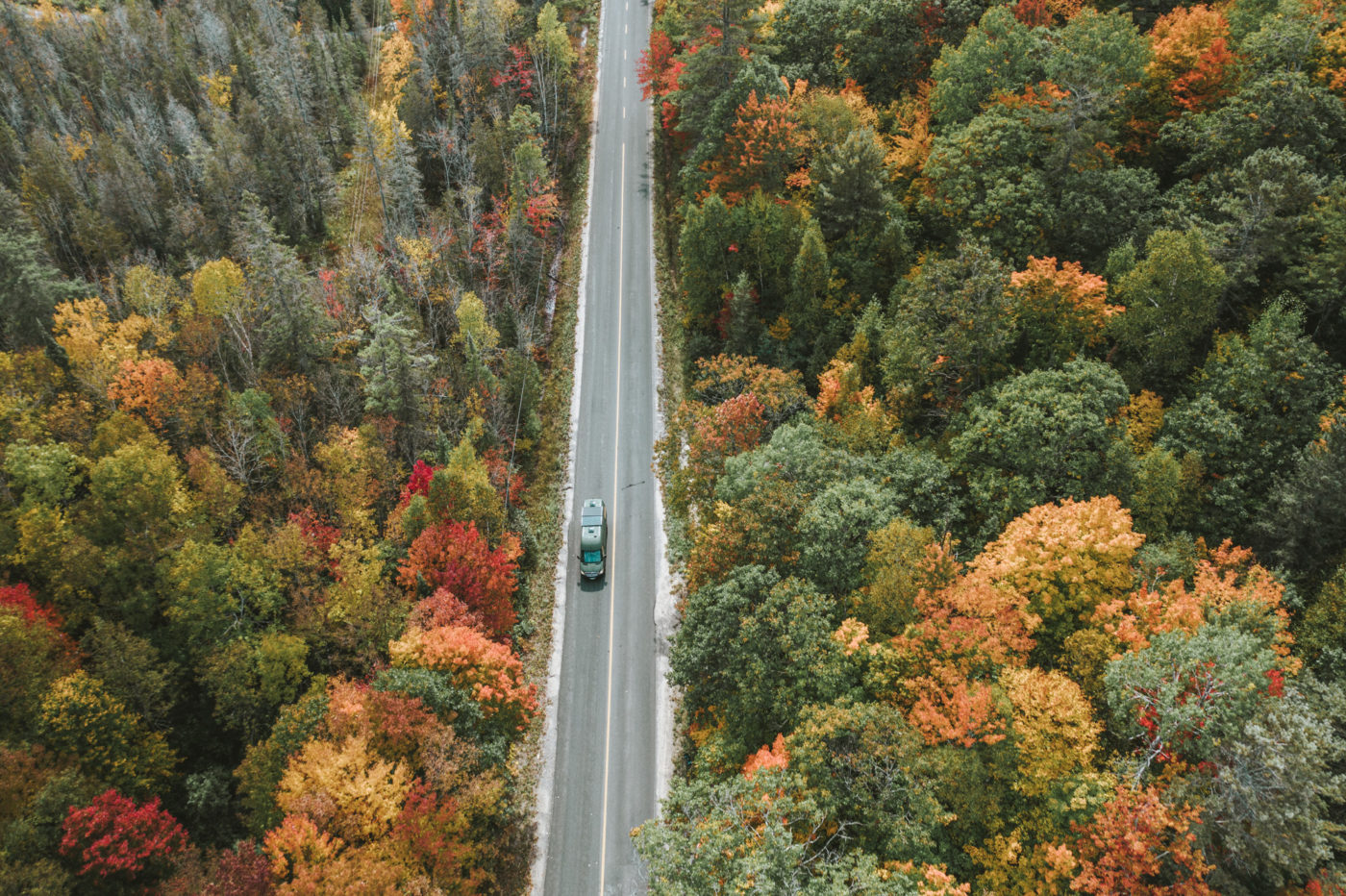
Algonquin Park Hours & Entry Fees
There are two ways to visit the park. The first is on a day-use/ daily vehicle pass and the second is with a camping permit. Anyone with an Algonquin Park camping permit has 24-hour access and does not need to pay an additional fee.
Those on a day-use or daily vehicle pass are permitted within Algonquin park from 7:00 pm to 10:00 pm each day. Day use permits can be purchased at most park facilities.
A daily vehicle permit is $18.00 per vehicle. However, they increase to $21.00 per vehicle for those exploring Highway 60 on weekends in the fall when people flock to see the changing foliage.
Don’t be caught without a ticket or you will be given a hefty fine. Ontario Parks seasonal passes also work as a day pass for park Algonquin and can be purchased in advance at most Ontario Parks offices or online.
Seasonal passes range from $85.00 for a winter pass, $125.00 for a summer pass, and $185.00 for an annual Ontario Parks pass.
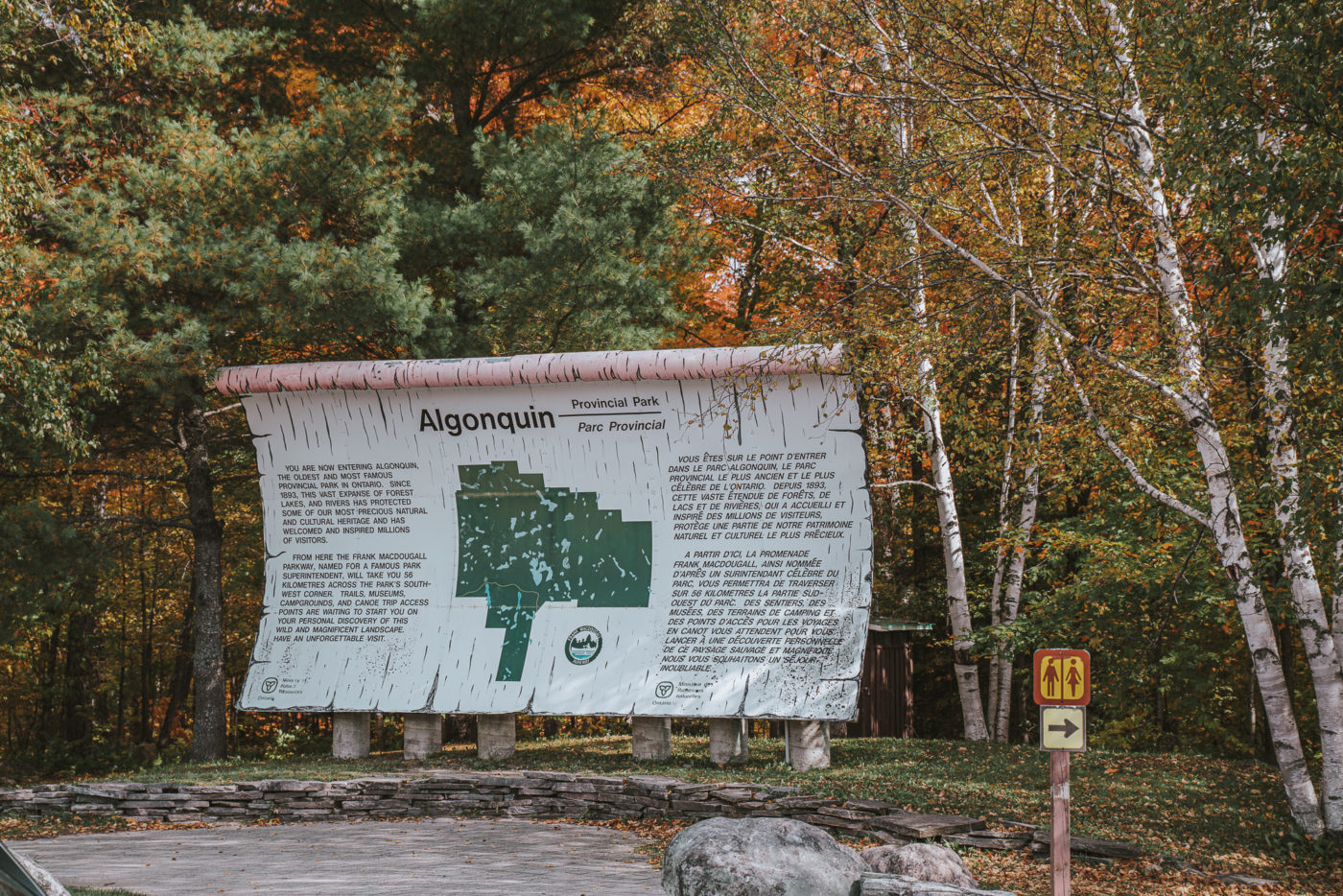
Things to Do in Algonquin Park, Ontario
No matter what time of year you plan to visit Algonquin Provincial Park, there is plenty to do once you arrive. Most visitors come to Algonquin to enjoy the beautiful scenery and to escape city life, but those that are lucky might even catch a glimpse of some of Algonquoin’s animals like the Canada loon, beaver, moose, and deer.
Hiking is by far one of the best things to do in Algonquin Park, Canada. There are over 20 well-marked Algonquin Park trails ranging from 30mins to a few hours. Most trails are about 1-2 hours. They are perfect for day-trippers and those staying at front-country campsites within the park.
Backcountry hikers will enjoy over 140 kilometres of interior park trails but they aren’t for the faint of heart. To camp and hike in the backcountry requires previous experience and lots of preparation.
Recommended Day Trails
Some of the best day hikes, at Algonquin Park, Ontario, include the following:
Lookout Trail (1.9km)
This scenic trail may only cover 1.9 kilometres but it takes approximately 1 hour to complete. You’ll climb to the top of a cliff which rewards you with panoramic views of the park. The Lookout Trail is the most popular and hence the busiest trail in Algonquin park so be prepared to share it with the crowds or plan to visit on a weekday. Bonus points if you can do it in the fall when the foliage is at its best and brightest.

Beaver Pond Trail (2kms)
This easy trail wraps around 2 beaver ponds offering an opportunity to spot these elusive animals in their natural habitat. The trail takes about 1-2 hours to complete and is an easy hike with lovely scenery.
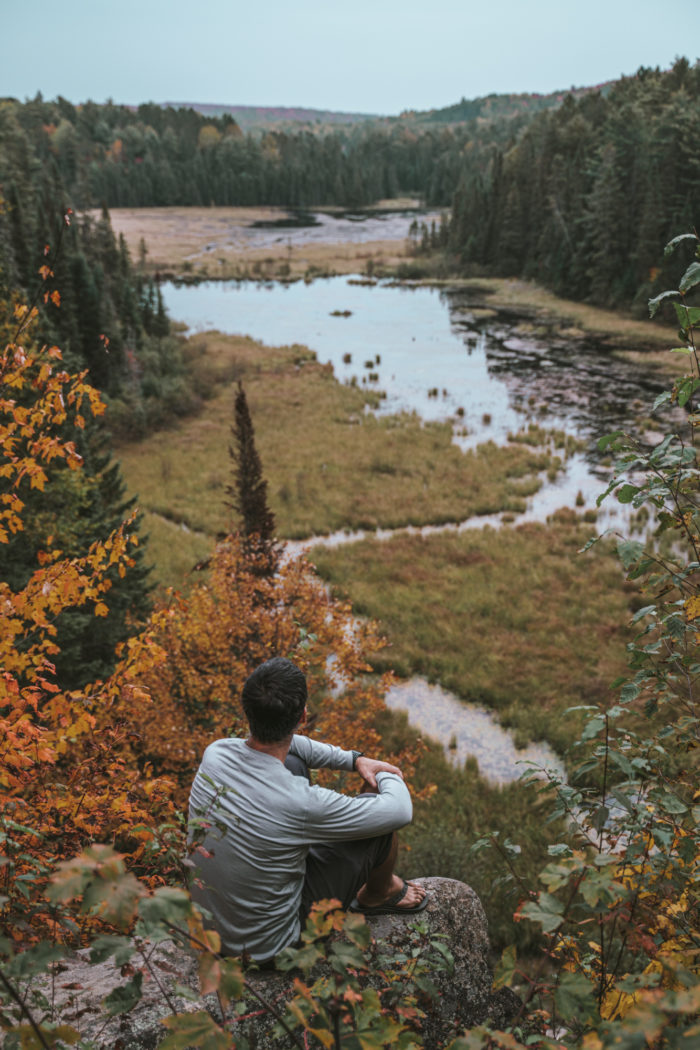
Algonquin Logging Museum Trail (1.3km)
This fascinating trail offers a glimpse into Ontario’s logging industry. It begins and ends at the Algonquin Logging Museum and along the well-trodden track you’ll pass by interpretive signage, old steam-powered train and a restructured wooden logging camp.
Stop at the museum to watch the documentary for even more information on logging in the area. The museum is managed in part by the Friends of Algonquin park program which is an NGO dedicated to furthering the educational and interpretive programs of the park.
Track & Tower Trail (7.5 km)
This rather difficult trail takes about 4 hours to complete but offers a scenic lookout and a view of an abandoned railway.
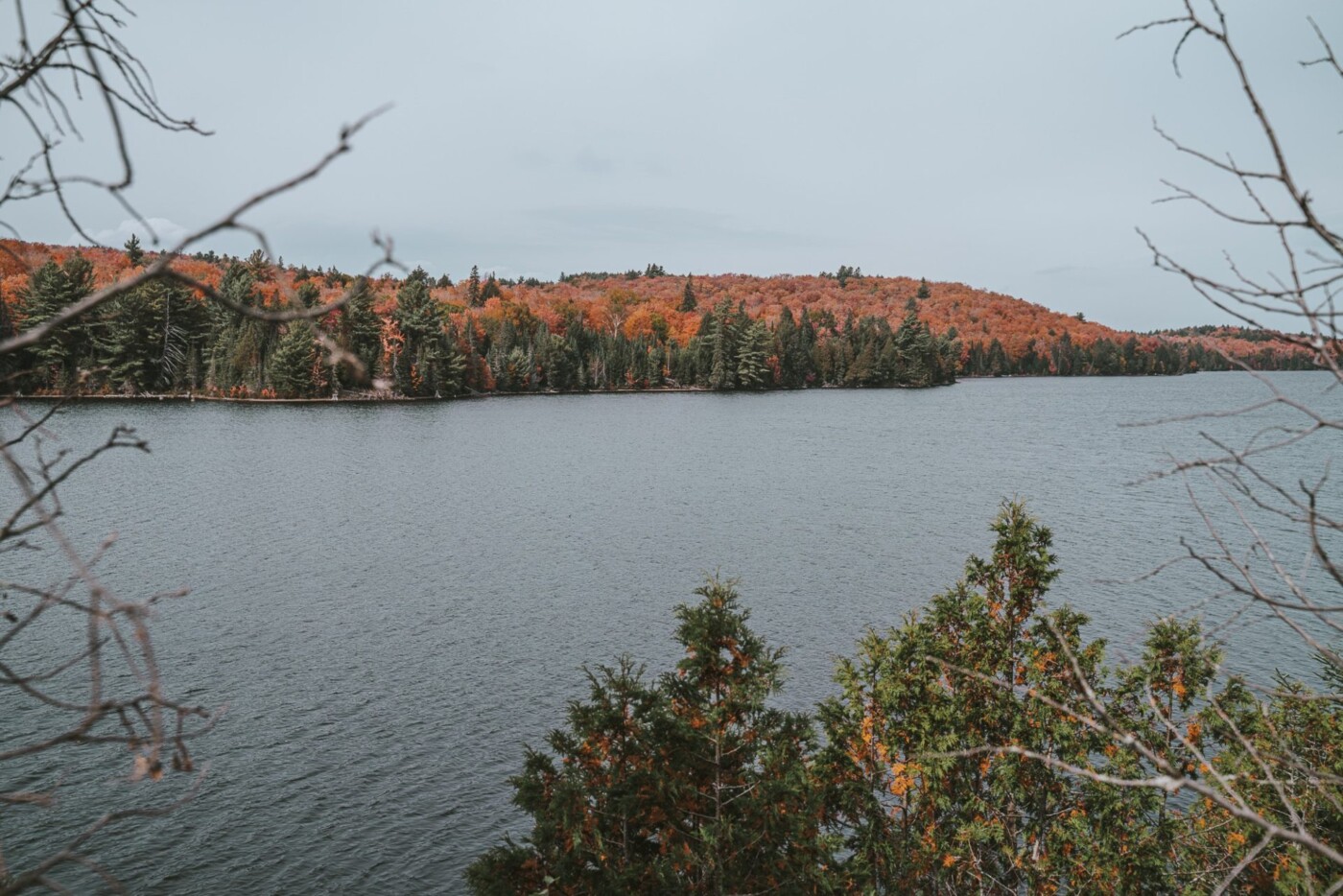
Mizzy Lake Trail (11 km)
Mizzy Lake Trail is one of the longest day trails in the park but with that comes a full immersion into nature. The trail takes about 4-5 hours to complete and takes visitors past hardwood forests, ponds, bogs, and lakes. Since the trail takes you away from busy areas, it is more common to see wildlife, like moose, turtles, and beaver along the way. The trail is fairly flat but can get muddy so we would only suggest you attempt it in the dry, summer months.

Whether you are up for a leisurely pedal or a more intense downhill mountain biking experience, there is a trail for you to discover at Algonquin Park. However, only attempt the trails when they are snow-free. If you didn’t bring your own bike you can check in with Two Rivers Store to rent.
Old Railway Bike Trail (16 kilometres)
This interesting trail is of a fairly flat grade and offers interpretive signage along the way. It is suitable for all levels and follows the path of an abandoned railway bed. It passes a series of lakes including an access point at Mew Lake, Lake of Two Rivers, Kearney Lake, Coon Lake, Pog Lake, Rock Lake.
Minnesing Mountain Bike Trail (4.7 – 23.4 kilometres)
This moderately difficult mountain bike trail passes by lakes, through hardwood forest and includes boardwalk sections. Bikers can choose their desired length based on their preference.
Byer Lake Mountain Bike Trail (13 kilometres)
The Byer Lake Trail is another moderately difficult trail. It is a convenient loop that has views of York River, Gut Rapids, and Byers Lake. There are a series of steep ascents and descents and keep in mind that the trail can get muddy at times.
Birding
Bird watchers tend to find Algonquin Park, Ontario a very special place. Over 278 birds have been recorded within the park, many of which breed or make stopovers on their migratory patterns.
The Common Loon is the most recognizable bird in the park and can be found living in most lakes. Blue Jays, Gray Jays, Black-Backed Woodpeckers and Spruce Grouse are other Canadian classics that can be seen within the park.
At certain times of the year, the Friends of Algonquin Park offer a live stream of a local bird feeder. The Wild Bird Cam is part of a Friends of Algonquin Park wildlife monitoring program.
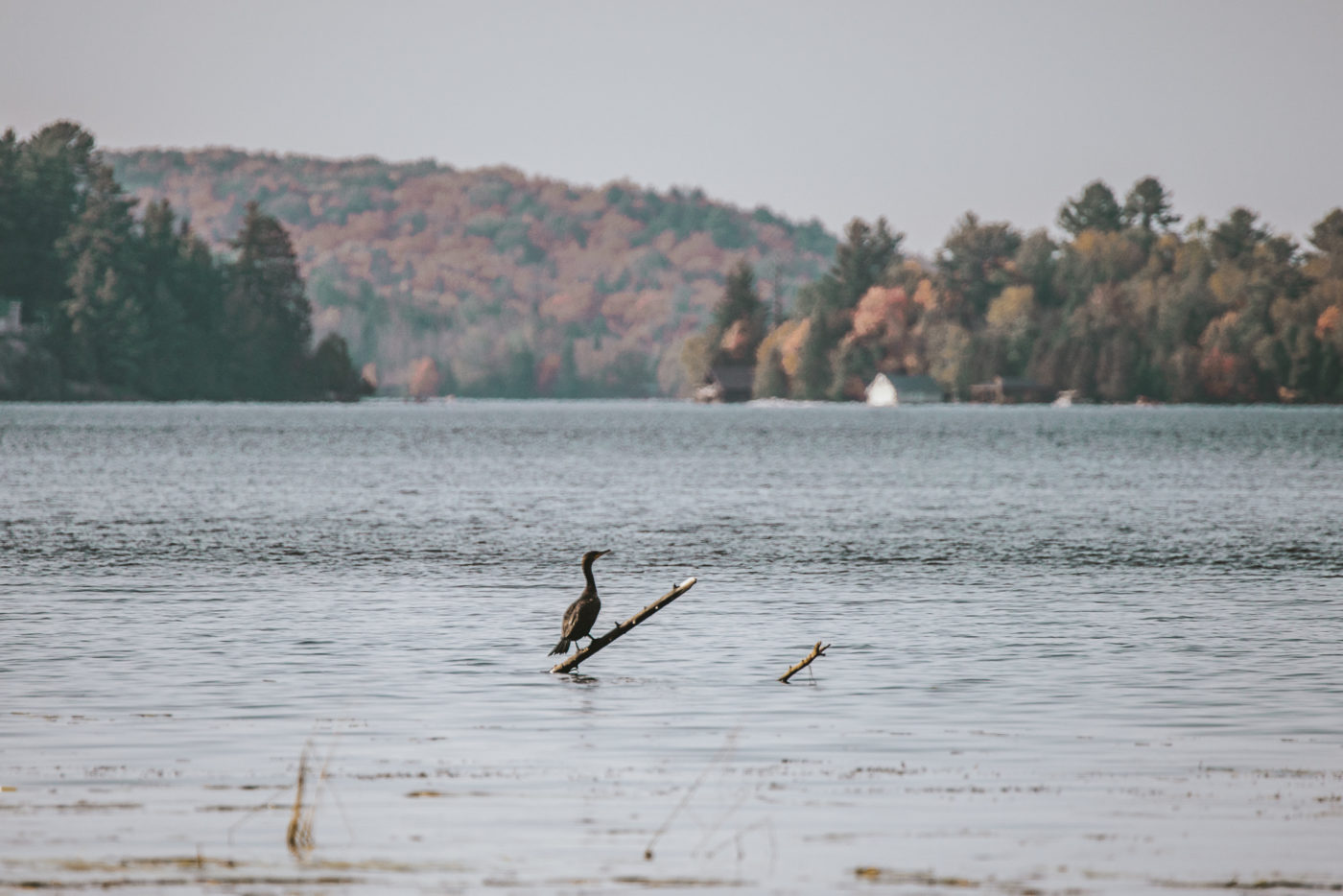
Canoeing and Boating
With the wealth of lakes in the area, you can see why canoeing and boating is one of the most popular things to do in Algonquin Park, Ontario.
To keep the peace within the park unlimited horsepower boats are only permitted on Galeairy and Opeongo Lakes. Boats with a horsepower of 20 or less, 10 or less, and 6 or less are permitted on many more.
Canoeing is much more common and is permitted everywhere in Algonquin Park, Ontario. There are over 2,100 kilometres worth of canoe trails in the Algonquin which are perfect for day paddles, backcountry exploring and portage trips.
For more information or for an Algonquin Park canoe rental, check in to Opeongo Store and Canoe Centre or Portage Store and Canoe Centre. They are both located along Highway 60.

Algonquin Park has some of the best trout fishing in Canada . Spring is the best time to fish for trout, where you can find Brook Trout and Lake Trout in hundreds of lakes within the park. Summer is more suited to Smallmouth Bass fishing.
Cross Country Skiing and Snowshoeing
In the winter months, the trails are not typically suitable for winter hiking but they offer continued enjoyment for cross country skiing and snowshoeing. There are three trail networks for cross-country skiing and snowshoeing where you will no doubt see animals tracks along the way.
Fen Lake Ski Trail
Located in the western section of the park, the Fen Lake Ski Trail network has four loops of 1.25, 5.2, 11.4 and 13 km. Each offers varying difficulty levels. All of them are groomed.
The Minnesing Trail
This ski trail offers four loops of 4.7 to 23.4 km. It is not groomed but well maintained and known for its soft snow. Perfect for snowshoeing.
Leaf Lake Ski Trail
All trails are groomed and there are toilets and cabins located along the trail. The network has tracks ranging from 5 to 51 kilometres.
Stop by the Algonquin Park Visitor Centre
Regardless of what time of year you visit, stop by the Visitor Centre to pick up an Algonquin park map and to see “What’s on”. Algonquin park holds a series of events and programs throughout the year, including interpretive walks, events at the adjacent outdoor theatre, evening programs and more. Many of which are facilitated by the Friends of Algonquin Park program. Check the schedule or talk to an Algonquin Park ranger at the Visitor Centre.
Located within the Visitor Centre is Algonquin Park’s second museum. It depicts the natural history of the park and includes an informative documentary and educational exhibits.
On the backside of the Visitor Centre is a lookout deck that offers 180-degree views of Algonquin Park. It has simply stunning views and is a great alternative to the Lookout trail for anyone with mobility issues.
Where to Stay in Algonquin Park, Ontario
You have your fair share of accommodation options and camps in Algonquin Park, Ontario. The most popular place to stay is along the Highway 60 corridor in the western section of the park. You’ll be close to Algonquin Park trails and other highlights like the Visitor Centre and Logging Museum.
It is absolutely essential to book your camp in Algonquin Park in advance . Algonquin park reservations go fast especially in the warmer months and during fall. You can book your site 5 months in advance on the Park Ontario website but keep in mind reservation holders will not be able to check in to their site before 2pm.
Algonquin Park Campgrounds
Mew lake campground.
Mew Lake Campground is located along Highway 60. It contains 131 powered and non-powered campsites suitable for reservation holders with tents and RV’s. The campground has lakefront access, a beach, toilet, shower, and laundry facilities available. It is open year-round and is connected to many hiking trails which will keep you busy before check-in.
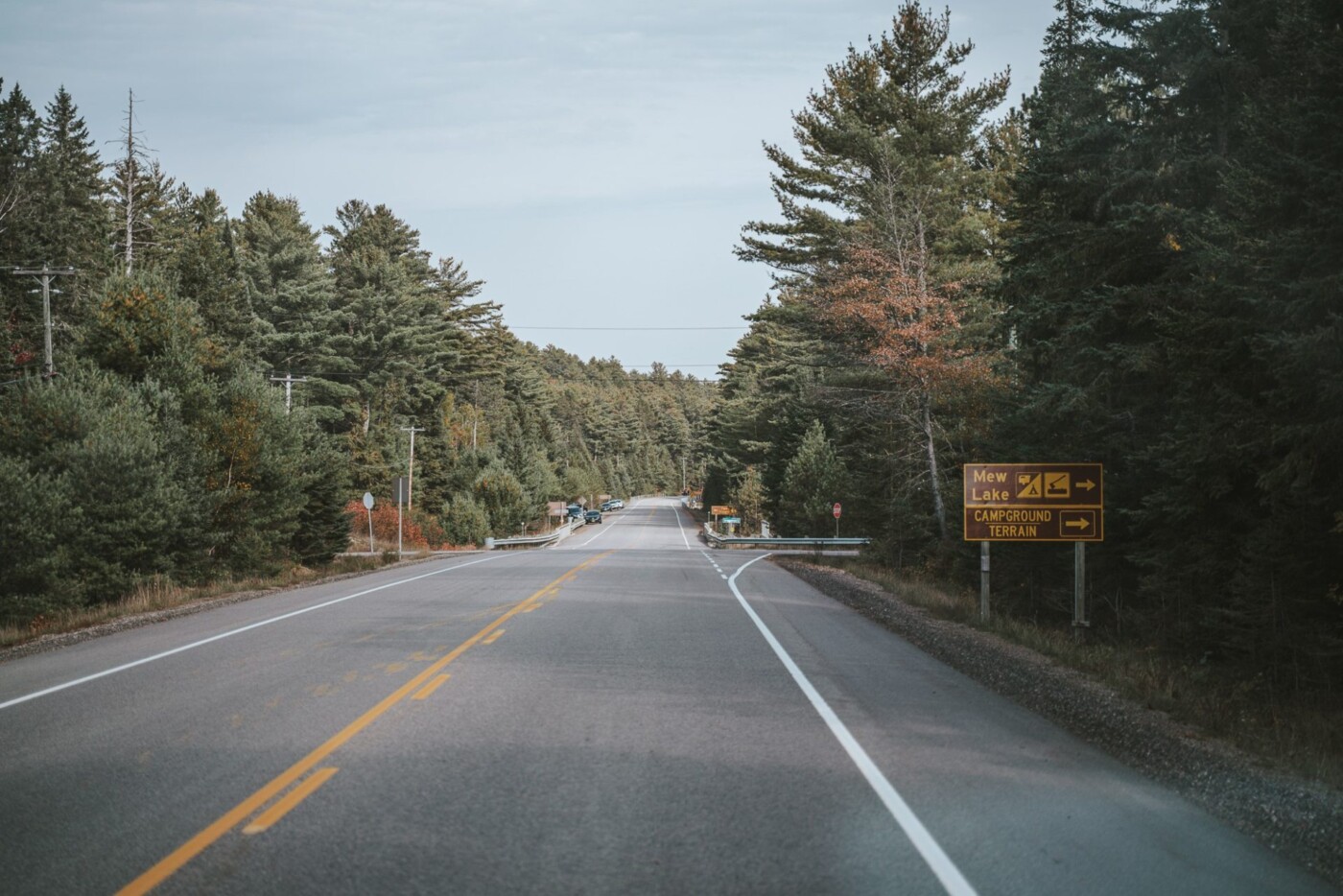
Lake of Two Rivers Campground
Lake of Two Rivers Campground is another one of the Highway 60 campsites. Algonquin permits small boats (20 horsepower or less) to explore the lake surrounding the campsite where trout can be found. There is a beach and volleyball court on-site and all the facilities you would expect from a campsite like toilets, shower, and laundry facilities. There are 241 powered and non-powered campsites suitable for tents and rental vehicles. Make sure that you check the Ontario Park’s website for the most up to date info on each campsite as some facilities, like showers and other communal areas may be closed.
The Pog Lake Campground
The layout of Pog Lake Campground maximizes waterfront real estate and individual site seclusion. You can check in with this Algonquin park camping site on the long weekend in May and then from mid-June to the Labour day weekend. There are 286 campsites, some with electrical and suited for RV’s. You can find a beach, shower facilities, and toilets on site.
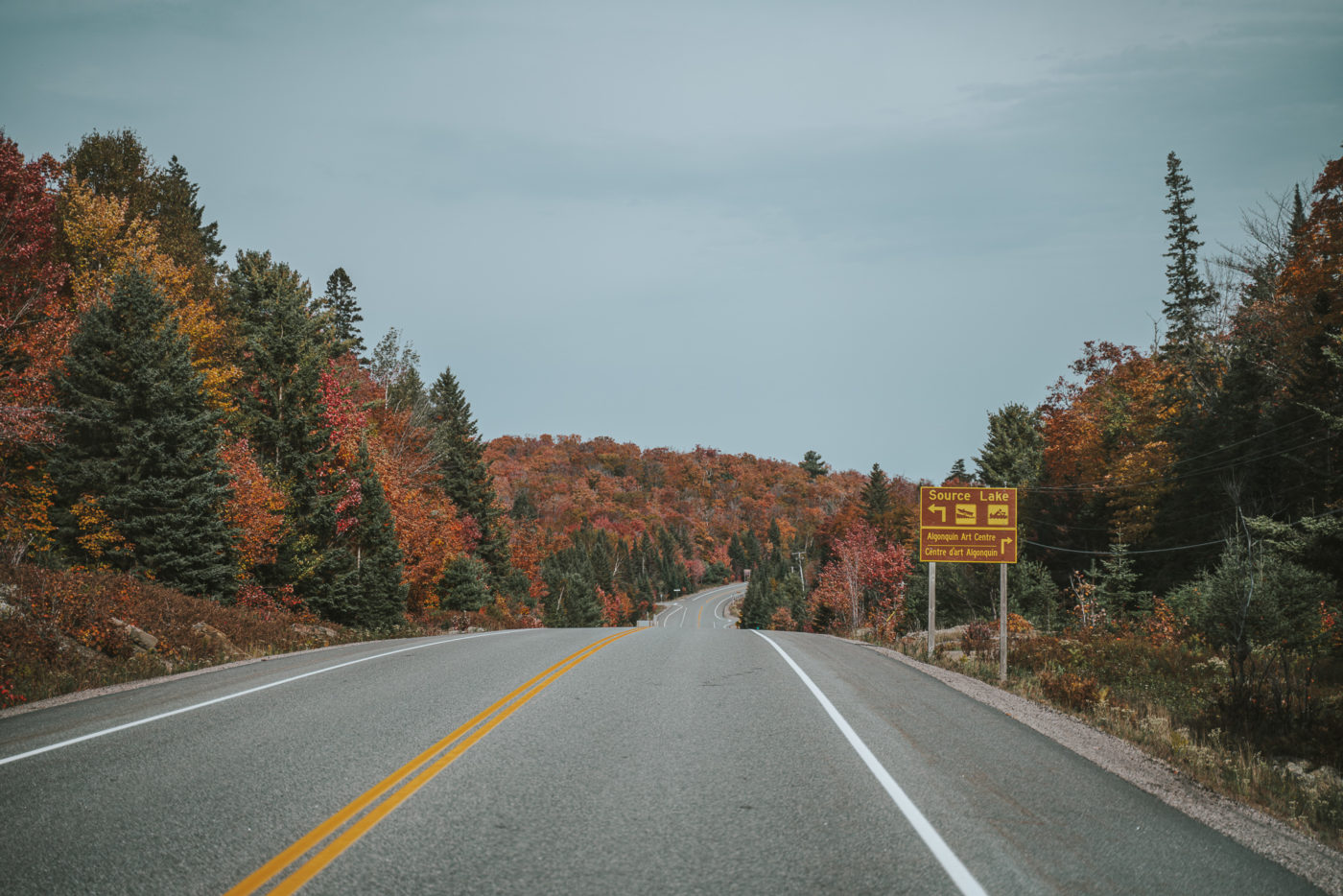
Ranger Cabins
There are 5 Ranger Cabins which visitors can drive into and many more with a backcountry access point. Most of them can be described as very basic roofed accommodations but they vary greatly from cabin to cabin.
In most cases, the cabins do not have electricity or running water. However, they tend to some sort of toilet facility, bunk beds, washbasins, and other miscellaneous amenities.
Yurts are octagonal, tent-like roofed accommodations. At Algonquin Park there at 8 yurts available for rent. 7 are located at Mew Lake Campground and 1 at Achray Campground.
Each yurt each contains bunk beds and is suitable for up to 6 people, offering fluorescent lighting, and electrical heat inside. However, you’ll need to bring your own bedding and related gear for camping at Algonquin Park.
Traveling to Algonquin Park Ontario During COVID
As domestic travel begins to open up we have to continue to be mindful to stop the spread of COVID. If you are traveling to Algonquin Park Ontario during the pandemic consider the following:
- If you have been in contact with anyone that has COVID or if you are exhibiting synonyms, do not travel
- Wear a mask when indoors or around other people
- Wash your hand or use sanitizer often.
- Maintain social distancing of at least 6 feet at all times
Algonquin has a very special place in the hearts of many Ontarians. If you are planning to check in to the park, practise leaving no trace. Dispose of your garbage at a proper access point and pack zero waste products when possible so the park is beautiful for the next reservation holders.
Have you ever visited Algonquin Provincial Park? What are some of your favourite spots in the park?
READ NEXT: Guide to National Parks, Ontario
About The Author
Oksana & Max St John
Leave a comment cancel reply.
Your email address will not be published. Required fields are marked *
This site uses Akismet to reduce spam. Learn how your comment data is processed .
Tanzania Trip Details
Enter your name and email to get our Tanzania Safari Trip brochure with more details about this trip in your inbox.
Download Japan Trip Itinerary
Enter your name and email to get our Japan Trip brochure with more details about this trip in your inbox.
Join our 2025 Group Trips Pre-sale List
Be the first to know about NEW Trips and SPECIAL Offers!
Have 5 minutes to share more info? Fill out the Pre-Sale trip survey HERE
Interested in joining us in Japan?
Love the sound of this trip? Ready to book? Have some questions?
Send an inquiry and let's chat!
Leave your details below and be the first to get updates, special deals, and connect with us directly about this trip!
Reignite the Feminine Retreat
Love the idea of a women-only retreat in September 2024?
Help me decide where we should go!
Our women-only gatherings will be limited to 8-10 people, so leave your details below to add yourself to the waitlist.
We'll email you first to share all the details of the trip.

- May 2, 2022
The Beginners Guide to Camping in Algonquin Park
Updated: Feb 29
First time heading to Algonquin Park? Ready to book your stay in Algonquin Park, but not sure where to start? Let this beginners guide to camping in Algonquin Park help you along the way!

If you’re from Canada - even if you’re not - and have an interest in camping, then you have probably heard about Algonquin Park.
Algonquin is one of the most popular and well-known public parks in Canada. In a densely forested area surrounded by Crown Land (which means it’s owned by the government and you can’t build on or develop the land) Algonquin Park is a piece of authentic Canadian wilderness that you simply have to experience for yourself.
If you’re looking for a true nature camping experience, in a hidden gem of untouched wilderness, then this is a must-see destination.
But, it can be overwhelming if you’re new to camping or new to exploring wilderness you’re unfamiliar with. So we’ve created this guide to help first-timers to Algonquin.
In this article, we’ll tell you about everything you have to look forward to when you’re camping in Algonquin Park.
Let’s jump straight in.
Table of Contents
About algonquin provincial park, camping in algonquin park.
Top Attractions In and Around Algonquin Park
The Best Hiking Trails in Algonquin Provincial Park
Best Things To Do Around Algonquin Park
Established in 1892 by an act of the Ontario Legislature, Algonquin National Park was created as “a national park, forest reservation, fish and game preserve, health resort and pleasure ground for the benefit, advantage and enjoyment of the people of the province”.
The park, which later came to be known as Algonquin Provincial Park, was intended to provide a wildlife sanctuary, and to protect the headwaters of the five major rivers that flow out of the park.

If you’re a Canadiana buff, or simply interested in art, you may know that famous artists including Tom Thomson and The Group of Seven had a particular love of Algonquin Park. Many of the pieces of artwork they created over the years were inspired by scenes in the park.
Today, the park is known as one of the most important places in Canada to conduct biological and environmental research. The park is so beloved by so many that it has an international fanbase!
For instance - did you know that there is an Algonquin Symphony? Or that landscape scenes from the Park hang in the National Gallery of Canada? This Facebook group dedicated to Algonquin Park has nearly 70,000 members all interested in and dedicated to the park.
To learn more tidbits of information on the history of the area, visit this link on the cultural history of Algonquin Park.
Also read: Ontario Camping for Beginners
If you’re a beginner in the world of camping, then there are some great campgrounds to choose from to get you started.
Ready To Camp in Algonquin | For Beginners with little to no experience
If you’re looking for a ready-to-camp option that is clean, comfortable and offers all that you need without the set-up or tear-down, you should check out glamping options.
{Want to learn way more about a ready-to-camp site close to Algonquin Park and all the benefits they offer? Read this blog }
Glamp sites are equipped with creature comforts - like beds, solid canvas tents, or four walls depending on your interests.
{For more specific details about the differences between camping and glamping, check out this link }
Four Corners Algonquin (located at the east gate of Algonquin Provincial Park on highway 60) is a ready-to-camp and glamping campground. As stress-free as camping can be, just drive in, park, and unpack. No set up, no take down.
Here's our go-to packing list for all things camping gear, clothing and equipment - but don't forget: an added benefit of Four Corners is that any equipment you left behind at home or don’t own, you can borrow from the Four Corners Quartermaster Shack! Check the store out here .
Also read : Watching the Leaves Change Colour - Enjoy the Best of Ontario's Fall Colours
Camping in Algonquin | For Beginners with the equipment
If you’re looking for a beginner’s trip to genuine camping with breathtaking views, then you want to take a look at some of the top campgrounds Algonquin Park has to offer.
If you’re looking for a campground that offers some amenities, then take a look at this companion blog to see what the Algonquin Park campgrounds have to offer in the way of resources and choose the site that suits your needs! There are so many incredible spots to check out.
Backcountry Camping | For Beginners with some experience and equipment
There are campgrounds that offer amenities and electricity - and there are those that take you completely off the grid. If that’s what you’re looking for then here are a couple of hiking backcountry camping suggestions that’ll get your adventurer’s heart thumping!
Eastern Pines Backpacking Trail
This site offers an overnight backpacking trail with 6 - 15 km loops for you to traverse.
Highland Backpacking Trail
This site offers some long loops - choose 19 or 35 kms in length - for a lengthier adventure. Keep in mind - this trail is tricky! Not for the faint of heart.
Western Upland Backpacking Trail
Looking for the next awesome story to tell your friends? Book an experience on this trail, and choose loops that are 32 - 88 kms in length.
Booking Your Visit Can Be As Tricky as These Trails
Making a reservation through Ontario Parks can be difficult as campsites sell out in seconds.
If you’re looking for campsites for your family or a group of friends, book directly through the campsite you’re interested in. You can also check out private campsites that tend to have more availability. For example, you can book your site right now at Four Corners Algonquin .

Top Attractions in and around Algonquin Park
Okay, hiking is great, and camping is fun - but what else can you do during a trip to Algonquin Park?
We’ve got you covered, whatever your interests are.
Check out the milky way, the Northern Lights, and the plain old gorgeous night sky without the glow of city light pollution fading out your view of the stars.
Take a Grand Tour of the Night Sky and visit Four Corners Algonquin’s viewing location for details on upcoming starry night events you won’t want to miss!
Fall Foliage
The trees in the fall are pretty everywhere. In Algonquin Park, there are oceans of trees in every direction, uninterrupted by development. Imagine the fall colours as far as the eye can see.
Added bonus: fall can be an off-time for bookings, which means you’ll have more luck getting a site for your family and friends when you book in the fall. This is especially true mid-week… the colours are just as beautiful on Wednesday as they are on Saturday. Plus, beat the heat and most bugs at this time of year!
Check out these details on the fall colours and get an idea of what you’ll be looking at when you book your fall trip!
You want to see the wildlife - and we assure you that you won’t be disappointed here. Watch for moose along the edges of the highway on your way into your campsite. Look for beavers when you take the Beaver Pond Trail. Keep your eyes on the bushes in search of critters during your hikes, and look for the birds in the trees.
When you’re ready to settle down for the night around a campfire, keep your ears tuned - you might just hear the wolves.
Driving Tour
Want to learn some cool Algonquin-related Canadian history when you’re on your way into the park? Who wouldn’t?
Algonquin Park has a free new driving tour experience that will fill you in on the history of the area as you drive in to your site. Check it out here!

Best Hiking Trails in Algonquin Provincial Park
There are dozens of trails that range from easy to experienced in and around Algonquin Provincial Park. Whatever your mood or comfort level, there will be a trail for you! And every hike comes equipped with breathtaking views of the natural landscapes, from forests to moving waterways to shining lakes.
Best Algonquin Park Trails for Beginners or People with Disabilities
Spruce Bog Boardwalk
Did you know that there were such things as “spruce bogs” until this moment? Well, you can see them live on this 1.5 km loop!
Logging Museum Trail
An interactive trail with old-fashioned trains, this is a hit with kids and adults alike! This 1.3 km trail is marked as easy, good for all ages and abilities.
Best Algonquin Park Trails for Intermediate Hikers
Whiskey Rapids Trail
A 2.1 km loop trail with views of the Oxtongue River and the Whiskey Rapids. With a name like that, it sounds like a party for intermediate hikers!
Beaver Pond Trail
This trail is a 2.0 km loop with views of two beaver ponds and the fascinating education on beaver pond ecology you didn’t know you needed.
Big Pines Trail
This trail is pretty level, and the loop is just under 3 kms long. See the remains of an 1880s logging camp!

Best Algonquin Park Trails for Experienced Hikers
Track and Tower Trail
This 7.5 km loop will take you upward for a gorgeous view of the park over Cache Lake. You’re heading upward, so the trail is marked as difficult.
Centennial Ridges Trail
This trail is a demanding (but worth it, if you’re looking for an adventure) 10.4 km loop that will give you views over two high ridges over the park.
Trail maps are provided when you visit the park (and online - here! ). Please make sure you check the experience level before you begin your trek - and always make sure to pack plenty of water and snacks for the trails. We recommend planning your trip so you can be off the trail at least a half hour before sunset.
Also read: The Best Hiking Trails in Algonquin Provincial Park

Best Things to Do Near Algonquin Park
Is your blood buzzing with excitement about all the things you want to do and see during your trip to Algonquin Park? Looking to bring it all together in one organized and planned out trip? Check out this 3 Day Stay Itinerary from Four Corners Algonquin to get down to all the best details when you book your stay!
Looking for even more “Algonquin” without being directly in the Park? No problem!
South Algonquin is right next door to the park, and there’s plenty to do there.
If you’re interested in a beautiful adventure in the far less busy off-season, then you’ll be happy to learn that there’s plenty to do even in the winter months. Here’s a list of the 11 Best Things To Do In South Algonquin all year long.
MySouthAlgonquin is excited to bring you more news of upcoming events, so keep an eye on their website throughout the year!
Also read: Camping in Canada - The Ultimate Guide
Book your stay today – we can’t wait to welcome you!
In today’s climate, where more people are interested in nature focused getaways, camping and glamping sites go fast. We always recommend you plan your trip ahead of time if possible. You can check availability at Four Corners here: https://www.fourcornersalgonquin.ca/book-now
If the dates you were hoping for aren’t available, we highly recommend you follow-us on social media. Whenever we have a cancellation we post it there and they are scooped up fast!
Follow us on Instagram @FourCornersAlgonquin
Follow us on Facebook: https://www.facebook.com/FourCornersAlgonquin

Common Questions
Can you camp anywhere in algonquin park.
Unfortunately no, you can’t camp “anywhere” in Algonquin Park. However, there are designated camping sites in Algonquin Park where you can camp comfortably. To camp in Algonq uin Park, you need to obtain a camping permit and these campsites are maintained by park authorities. If you are new to camping, there are places like Four Corners Algonquin that provide read-to-camp facilities.
What’s the best month to camp in Algonquin?
Summer (June-September) is the best time to camp in Algonquin, however, the fall colours are something that you cannot miss as well.
How many days is ideal for camping?
Three days are ideal for the best camping experience. It’s the right amount of time to enjoy the nature around you, keep food fresh in your cooler and relax in between set-up and teardown of your campsite. If you’re an experienced camper, five to seven days is a good time for a more immersive camping trip.
What is Accessible Camping?
Night Sky Photography in Starry South Algonquin
12 One-of-a-Kind Things to do in Canada
Comentarios
Algonquin Park Trails: Your Essential Guide to World-Class Hiking
- April 18, 2024
Explore the top Algonquin Park trails along Highway 60 with expert tips for every hiker. Discover Ontario’s stunning wilderness in this essential guide.
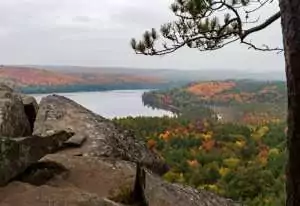
As Canada’s oldest provincial park, Algonquin Park boasts a diverse array of ecosystems, wildlife, and – most notably – an extensive network of breathtaking trails. This guide is dedicated to the adventurers and nature lovers seeking to explore the best of what Algonquin Park trails has to offer, particularly along the scenic stretch of the Highway 60 corridor!
Nestled within this vast wilderness are trails that promise an escape into nature, with each path offering its own unique journey through the park’s stunning landscapes. From tranquil lakeside walks to challenging climbs with rewarding vistas, the Algonquin Park trails along Highway 60 cater to hikers of all levels and interests.
In this ultimate guide, we will delve into each of these trails, providing you with detailed insights into their distinct features, tips for a safe and enjoyable hike, and the splendours that await you. Whether you’re a seasoned hiker or a curious first-timer, these trails offer a world of discovery. So lace up your boots, pack your sense of adventure, and join us as we uncover the best hikes along Highway 60 in Algonquin Park.
Don’t forget to check out our blog on: Winter Hiking Wonders: Unveiling Algonquin Park’s Snowy Secrets
Table of Contents
Algonquin park trails: at a glance.
- Track and Tower Trail: A 7.5 km loop that takes you through history and scenic vistas. Ideal for those looking to combine hiking with a bit of park history.
- Centennial Ridges Trail: This 10.4 km loop is a more challenging hike, known for its stunning panoramic views and ideal for experienced hikers.
- Peck Lake Trail: Perfect for a shorter, easier 1.9 km loop. It circles a beautiful lake and is great for bird-watching enthusiasts.
- Two Rivers Trail: A moderate 2.1 km loop with a mix of forest and riverside settings. It offers a wonderful mix of Algonquin’s ecosystems.
- Booth’s Rock Trail: A 5.1 km loop that provides breathtaking views of Rock Lake and the surrounding hills. Suitable for those looking for a moderate hike.
- Big Pines Trail: A 2.9 km journey that takes you through a stand of giant White Pines, offering a glimpse into the park’s logging history.
- Hemlock Bluff Trail: A 3.5 km trail leading to a stunning lookout over Jack Lake. A moderate hike that rewards with incredible views.
- Lookout Trail: A short but steep 1.9 km climb leading to one of the park’s most famous lookouts. Ideal for a quick but rewarding hike.
- Mizzy Lake Trail: One of the best for wildlife viewing, this 11 km trail is a bit more challenging but offers numerous opportunities to spot Algonquin’s diverse fauna.
- Spruce Bog Boardwalk: An easy 1.5 km boardwalk trail, accessible and perfect for families or those looking for a leisurely walk through unique bog ecosystems.
- Whiskey Rapids Trail: This 2.1 km loop trail takes you along the Oxtongue River to the picturesque Whiskey Rapids. It’s a moderate hike with a delightful mix of river scenery.
- Hardwood Lookout Trail: A short 2.1 km loop that’s steep but offers beautiful views over a mixed hardwood forest.
- Bat Lake Trail: A moderately challenging 5.8 km loop with diverse habitats including wetlands and a beautiful lakeside.
- Beaver Pond Trail: This 2 km trail provides insight into beaver habitat and offers chances to see beaver dams and lodges.
Big Pines Trail
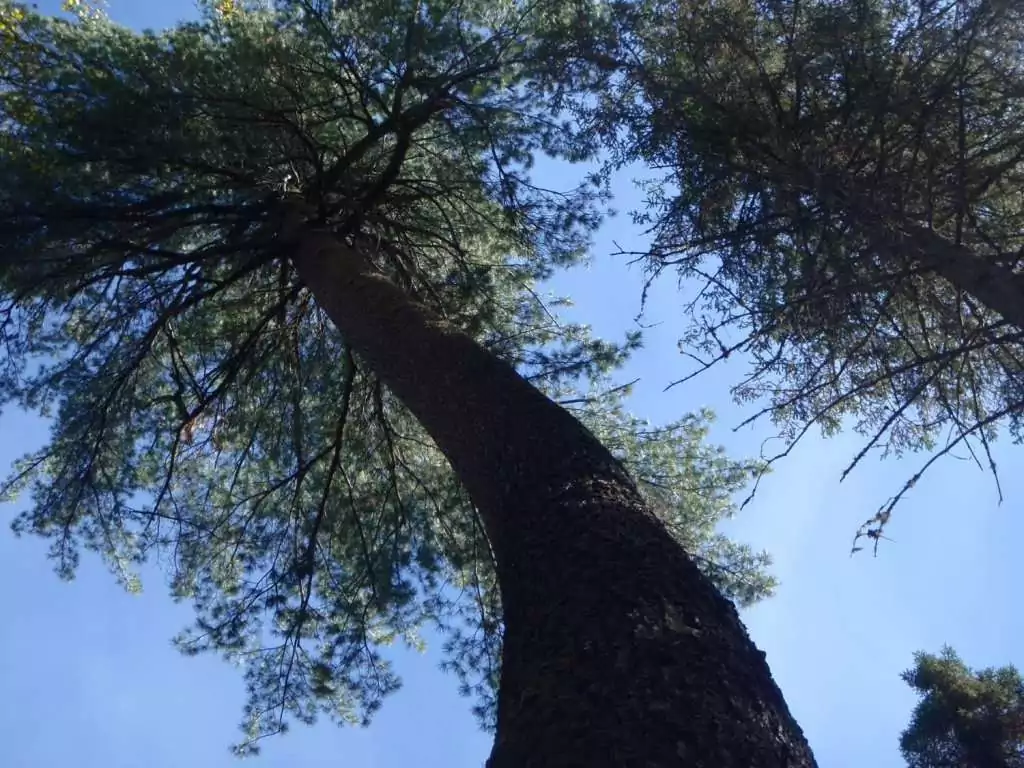
Trail Overview
Key highlights.
Length: 2.9 kilometers (loop trail)
Location: Near the Km 40 marker on Highway 60 in Algonquin Park, Ontario, Canada
Difficulty: Moderate (due to varied terrain and natural features)
Duration: Approximately 1 to 2 hours (depending on walking speed and stops for observation)
Elevation Gain: Approximately 23 meters
- Ancient White Pines, some over 200 years old
- Historical logging camp site from the 1880s
- Diverse ecology, including competing species like Sugar Maples
- Signs and remnants of historical logging activities
- Varied soil and moisture conditions affecting vegetation
- Educational posts matching trail markers explaining the ecology and history
Opportunities:
- Ecological and historical learning about White Pines and logging history
- Wildlife observation and nature photography
- Experiencing a part of a protected natural reserve
- Visiting the Algonquin Logging Museum for a deeper historical context
- Enjoying a moderately challenging hike suitable for a range of visitors
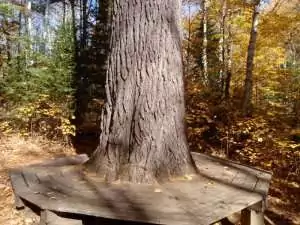
What makes this trail stand out? Let’s start with the ancient White Pines, some towering over 200 years old. These giants, reaching for the sky, are not just trees but living history. They have survived centuries, witnessing the changes around them. The trail gives you a chance to walk among these magnificent trees, feeling small yet connected to something grand. It’s like stepping into a natural cathedral, where each tree tells a story.
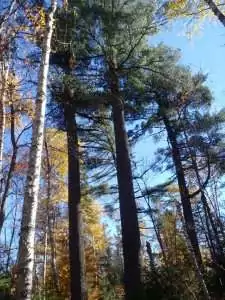
With an elevation gain of about 23 meters, the trail is moderately challenging, making it perfect for a range of hikers. Whether you’re a seasoned hiker or just starting, this trail is a great way to experience the outdoors. The hike takes about 1 to 2 hours, depending on your pace and how often you stop to soak in the views or read the educational posts along the way. These posts, matching trail markers, offer fascinating insights into the ecology of White Pines and the logging history of Algonquin Park.

As you walk the trail, it’s hard not to be amazed by the sheer size and age of the White Pines. They’re living proof of nature’s resilience and beauty. And when you learn about the loggers and their hard life, it adds a layer of respect for those who worked in these forests long ago.
In short, the Big Pines Trail is a journey through time and nature. It’s a place where you can connect with the past, learn about the environment, and enjoy a good hike. So, grab your walking shoes, a sense of adventure, and explore this amazing trail in Algonquin Park. You won’t be disappointed!
See Also: Big Pines – Best Hiking Trails Algonquin Park » Algonquin Park
Look Out Trail
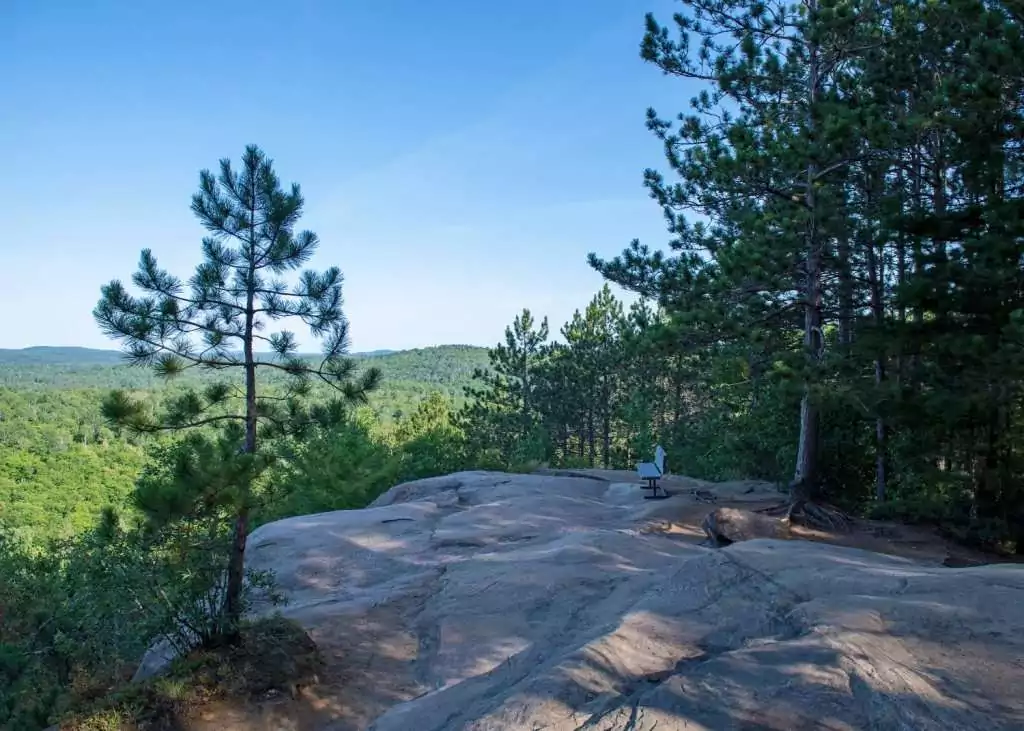
Length: The trail is a 2.1 km loop, providing a compact yet immersive nature experience.
Location: It is located at km 39.7 along Highway 60 within Algonquin Park. The specific coordinates are 45.579123°, -78.406543°, making it easily accessible for visitors.
Difficulty: The trail is rated as moderate. It includes some steep and rugged sections but is generally manageable for most hikers with a basic level of fitness.
Duration: It typically takes about 1 hour to complete the trail. This duration can vary depending on your pace and how long you spend enjoying the views.
Elevation Gain: Approximately 70 meters
- Scenic Lookout: The trail’s main highlight is its scenic lookout, providing extensive and breathtaking views over Algonquin Park. This vantage point allows you to see across several hundred square kilometers, offering a panoramic display of the park’s natural splendor.
- Ideal for Fall Visits: The beauty of this lookout is especially enhanced in the fall, where the foliage transforms into a vibrant spectrum of autumn colors, making the landscape even more spectacular.
- Bird Watching: The trail and its surroundings are a haven for various bird species, providing ample opportunities for bird watching. Nature enthusiasts can enjoy observing these birds in their natural habitat.
- Photography: With its stunning views, the lookout point is a perfect spot for photography enthusiasts. Whether you’re capturing the vast landscapes or the detailed beauty of the flora and fauna, the trail offers diverse photographic subjects.
- Perfect for Short Visits: If you are passing through the park or have limited time, the Lookout Trail is an excellent choice for a quick yet fulfilling hike. It provides a rich experience without requiring a long time commitment.

First off, let’s talk location. The Lookout Trail is nestled within the beautiful Algonquin Provincial Park, situated at km 39.7 along Highway 60. The coordinates (45.579123°, -78.406543°) lead you to a world of natural beauty that’s both accessible and awe-inspiring.

The duration of the hike is about 1 hour, making it an ideal choice for a quick nature escape. Whether you’re a local or just passing through the park, the Lookout Trail is perfect for fitting a memorable hike into a busy schedule.
Now, let’s talk about the best part – the scenic lookout. This is where the trail really shines. After a hike through the green, forested path, you’re rewarded with a stunning view that spans several hundred square kilometers of Algonquin’s wilderness. It’s an incredible sight, with lush trees stretching as far as the eye can see, making it an excellent spot for some breathtaking photos. The view is especially spectacular in the fall when the foliage turns into a vibrant tapestry of colors.
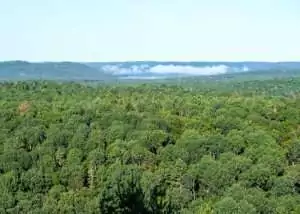
In summary, the Lookout Trail in Algonquin Provincial Park is a remarkable blend of natural beauty, physical challenge, and educational opportunity. It’s a trail that offers something for everyone – breathtaking views for the photographers, a manageable challenge for the hikers, and a rich history for the curious minds. If you’re in Algonquin Park, don’t miss the chance to experience this gem of a trail.
See Also: Look Out – Algonquin Park Hiking Trails » Algonquin Park
Beaver Pond Trail

Length: The Beaver Pond Trail is a 2-kilometer loop, offering an engaging and accessible nature experience perfect for a brief adventure.
Location: Situated at km 45.7 along Highway 60 in Algonquin Park, the trail is easy to locate for visitors. The geographical coordinates are approximately 45.584°N, -78.355°W, placing it conveniently within the park.
Difficulty: This trail is rated as moderate. It features a mix of flat and uneven terrains, including some hilly sections. It’s suitable for hikers with an average fitness level.
Duration: Completing the trail typically takes about 1 to 1.5 hours. This time can vary based on walking speed and the number of stops to observe wildlife and the environment.
Elevation Gain: Approximately 32 meters
- Beaver Habitats: The trail offers numerous opportunities to see beaver ponds, lodges, and dams. These structures are prime examples of the beaver’s impact on the ecosystem.
- Educational Posts: Along the trail, there are several educational posts providing insights into beaver behavior, their role in the ecosystem, and the environment of Algonquin Park.
- Diverse Flora and Fauna: The trail is surrounded by a rich variety of plants and wildlife, offering an immersive experience in the park’s natural biodiversity.
- Wildlife Observation: The Beaver Pond Trail is an excellent spot for observing various wildlife, especially the workings of beavers in their natural habitat.
- Photography: The trail provides numerous picturesque scenes for photography enthusiasts, from beaver ponds reflecting the sky to the lush greenery of the park.
- Family-Friendly Adventure: This trail is an ideal choice for families and those interested in learning about nature and wildlife. It’s an educational experience as much as it is a recreational one.
- Seasonal Beauty: While beautiful year-round, the trail offers a unique charm during different seasons, from the fresh green of spring to the fiery colors of autumn.

Located at km 45.7 along Highway 60, the trail is a gem within Algonquin Park, easily accessible for visitors. Its moderate difficulty level makes it perfect for teens and families. You don’t have to be a seasoned hiker to enjoy this trail – just bring your curiosity and a love for nature. While the trail can be completed in about 1 to 1.5 hours, you might find yourself spending more time, captivated by the scenery and the wildlife.
What makes the Beaver Pond Trail exceptional is its focus on the beavers of Algonquin Park. Beavers, known as nature’s engineers, have shaped the landscape in remarkable ways. As you wander along the path, you’ll come across beaver ponds, lodges, and dams. These aren’t just random structures; they are masterpieces of natural engineering, showcasing the beaver’s crucial role in the ecosystem. The trail offers a front-row seat to observe how these industrious creatures transform forests into wetlands, creating habitats for various other species.
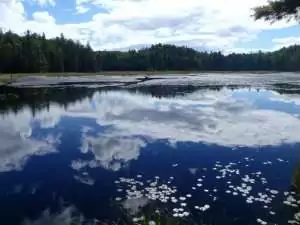
For the budding photographers, the Beaver Pond Trail is a treasure trove of scenic beauty. Whether it’s capturing the serene beaver ponds, the lush greenery, or the myriad of wildlife, every step presents a new photo opportunity. It’s also an excellent spot for wildlife observation, offering chances to see beavers at work, birds in their natural habitat, and perhaps even a glimpse of a deer or a moose.
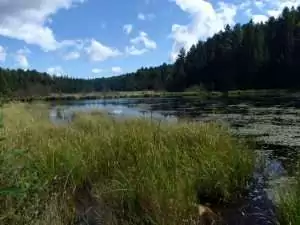
In essence, the Beaver Pond Trail is more than just a hiking path. It’s an adventure that educates, inspires, and connects you with the natural world. It’s a place where you can witness the remarkable ways in which animals like beavers shape our environment, all while enjoying the serene beauty of Algonquin Park. So lace up your hiking boots, grab your camera, and get ready to explore this little slice of Canadian wilderness magic!
See Also: Beaver Pond – Best Trails In Algonquin Park » Algonquin Park
Bat Lake Trail

Length: Bat Lake Trail spans a 5.6 km loop, ideal for a comprehensive exploration of Algonquin Park’s diverse ecosystems.
Location: Located at km 30 along Highway 60 within Algonquin Park, the trail is easily accessible with coordinates approximately at 45.590°N, -78.366°W.
Difficulty: This trail is rated as moderate, balancing gentle slopes with more rugged terrains, suitable for hikers possessing an average fitness level.
Duration: Hikers typically complete the trail in about 2 to 2.5 hours, though this can vary based on walking speed and stops for enjoying the scenery.
Elevation Gain: Approximately 65 meters
- Ecological Diversity: Showcasing coniferous and deciduous forests, as well as wetlands, the trail is a testament to the ecological variety of Algonquin Park.
- Geological Education: Along the trail, informational posts offer insights into the park’s glacial history and its influence on the current landscape and biodiversity.
- Bat Lake Viewpoint: A key highlight is the Bat Lake viewpoint, offering picturesque views of the lake and its surrounding forested areas.
- Seasonal Accessibility: The trail is accessible year-round, providing unique experiences in each season, including snowshoeing opportunities in winter.
- Wildlife Observation: Ideal for spotting a variety of wildlife, including bird species, small mammals, and occasionally larger animals like moose and deer.
- Educational Experience: The numerous informational posts along the trail make it a great educational resource for learning about local ecology and geology.
- Photography and Art: The diverse landscapes, ranging from dense forests to serene lakes, offer ample opportunities for photography and artistic endeavors.
- Seasonal Beauty: Especially striking in the fall, the trail’s foliage transforms into vibrant hues, enhancing the beauty of the landscape.

Imagine stepping onto a trail that winds through a stunning array of ecosystems. One moment you’re surrounded by towering coniferous trees like White Pines and Balsam Fir, and the next, you find yourself amidst a lush hardwood forest dominated by Sugar Maples. This isn’t just a random occurrence. The Bat Lake Trail tells a story, a story of how the last Ice Age shaped the land thousands of years ago. As you walk, you’ll learn how the soil beneath your feet influences the types of trees and plants that can grow. It’s like taking a step back in time to when glaciers carved out the landscapes we see today.

One of the trail’s highlights is the Bat Lake viewpoint. Here, you can pause and take in the serene beauty of Bat Lake, surrounded by the dense forest. This spot is especially magical during sunrise or sunset, when the sky’s colors reflect on the lake’s surface, creating a scene right out of a painting.
But there’s more to this trail than just pretty views. It’s a living classroom where you can learn about different plant species, wildlife, and the impact of environmental factors like soil type and climate. Information posts along the trail provide fascinating insights, making your hike not just a physical journey but an educational one too.
Accessibility is well thought out here. The trail is open year-round, and there’s ample parking and basic facilities at the trailhead. Remember to bring water and snacks, as there are no shops along the way.
In summary, the Bat Lake Trail is more than just a walk in the park. It’s a journey through time, a lesson in ecology, and an opportunity to connect with nature in one of its purest forms. Whether you’re looking to stretch your legs, expand your mind, or just enjoy the beauty of the Canadian wilderness, Bat Lake Trail is the perfect destination. So, lace up your hiking boots, grab your water bottle, and get ready to embark on an adventure that you’ll remember for a lifetime!
See Also: Bat Lake – Trails In Algonquin Park » Algonquin Park
Booths Rock Trail
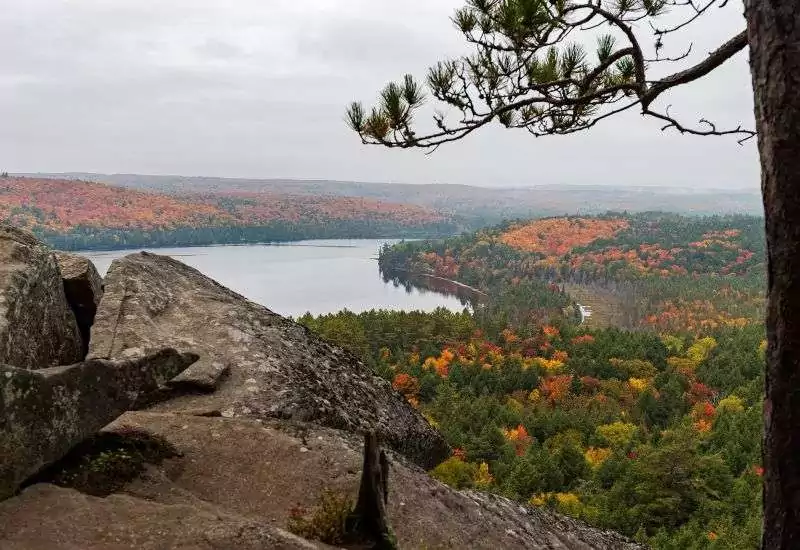
Length: The Booth’s Rock Trail is a 5.1-kilometer loop, offering a longer and more immersive hiking experience.
Location: Situated at the southern end of Algonquin Park, the trail begins approximately 1 kilometer south of the Rock Lake Campground office, easily accessible from Highway 60. The specific coordinates are 45.562183°, -78.427637°.
Difficulty: This trail is rated as moderate to challenging. While it includes some steep sections, it is generally manageable for hikers with a moderate level of fitness.
Duration: Plan for about 2 to 3 hours to complete the trail, depending on your hiking pace and the time you spend admiring the panoramic views.
Elevation Gain: Coming Soon
- Scenic Lookout: The main highlight of the Booth’s Rock Trail is its breathtaking scenic lookout. At the summit of Booth’s Rock, you’ll be rewarded with expansive views of Rock and Whitefish lakes, as well as several hundred square kilometers of Algonquin Park’s stunning wilderness.
- Ideal for Fall Visits: Like many Algonquin trails, Booth’s Rock is especially captivating during the fall. The changing foliage paints the landscape in vibrant autumn hues, enhancing the natural beauty of the park.
- Bird Watching: The trail and its surroundings provide excellent opportunities for birdwatching. Keep an eye out for various bird species as you hike through the diverse habitats of Algonquin Park, a paradise for nature enthusiasts and bird lovers alike.
- Photography: The Booth’s Rock Trail offers fantastic opportunities for photography enthusiasts. Capture the stunning panoramic views from the lookout, especially during sunrise or sunset, when the soft, warm light enhances the landscape’s beauty. You can also photograph the vibrant foliage in the fall, creating memorable images of Algonquin Park’s natural splendor.
- Wildlife Observation: Algonquin Park is home to a diverse range of wildlife, and while hiking Booth’s Rock Trail, keep your eyes peeled for opportunities to observe animals in their natural habitat. You might spot white-tailed deer, red foxes, or even the occasional black bear. Exercise caution, maintain a respectful distance, and never feed or approach wild animals.
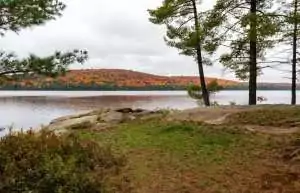
One of the trail’s standout features is its captivating scenic lookout perched atop Booth’s Rock. After a moderate hike, you’ll be rewarded with panoramic views that stretch across several hundred square kilometers. From this vantage point, you can admire the pristine waters of Rock and Whitefish lakes while being surrounded by Algonquin Park’s unspoiled wilderness. The lookout is a fantastic spot for capturing memorable photographs or simply immersing yourself in the grandeur of nature.
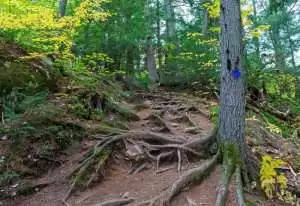
For those seeking a tranquil escape, the trail offers various serene spots and clearings, making it an ideal location for a peaceful picnic. Pack a picnic basket with your favorite snacks and refreshments to enjoy amidst the captivating beauty of Algonquin’s wilderness. The lookout point, in particular, provides a picturesque setting for an outdoor meal with family or friends.
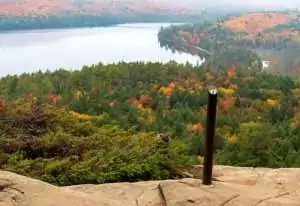
In summary, Booth’s Rock Trail is not just a hike; it’s an expedition into the heart of Algonquin Park’s extraordinary wilderness. With its breathtaking vistas, wildlife encounters, and opportunities for relaxation and wonder, this trail encapsulates the essence of Algonquin’s natural splendor. Whether you’re a passionate hiker, a nature lover, or a family in search of adventure, Booth’s Rock Trail beckons you to explore and discover the majesty of Algonquin Park.
See Also: Booths Rock – Algonquin Provincial Park Trails » Algonquin Park
Centennial Ridges Trail

Length: The Centennial Ridges Trail is a 10.4 km loop, offering an extensive and deeply immersive nature experience within Algonquin Park.
Location: This trail is situated in the heart of Algonquin Provincial Park, located at km 37.6 along Highway 60. The exact coordinates are 45.5908° N, -78.3644° W, making it a convenient destination for park visitors.
Difficulty: Rated as challenging, the Centennial Ridges Trail is known for its steep inclines and rugged terrain. It’s best suited for hikers who have a good level of fitness and some experience with more demanding trails.
Duration: Hiking the entire loop typically takes about 3 to 5 hours, depending on your pace and the amount of time spent at various lookout points to enjoy the stunning views.
Elevation Gain: Coming Soon
- Scenic Lookouts: The trail boasts multiple lookout points, each offering a unique and expansive view of Algonquin Park’s rolling hills, dense forests, and pristine lakes. These vantage points are perfect for taking in the natural beauty of the park.
- Diverse Flora and Fauna: As you trek through different habitats, you’ll encounter a variety of plant and animal life, making it a fantastic trail for wildlife enthusiasts.
- Bird Watching: The trail’s diverse ecosystems support a wide range of bird species, making it an excellent spot for bird watching.
- Photography: The panoramic views, diverse wildlife, and rich natural surroundings offer photographers countless opportunities to capture the essence of Algonquin Park’s wilderness.
- Educational Experience: Along the trail, hikers can learn about the park’s ecological features and the history of its development, making it not just a physical journey, but an educational one as well.
- Seasonal Beauty: While beautiful year-round, the trail is particularly stunning in the fall, when the foliage turns vibrant shades of red, orange, and yellow. This seasonal change adds an extra layer of beauty to the hiking experience.
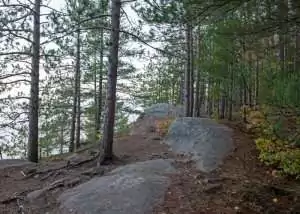
As you set foot on the Centennial Ridges Trail, prepare to be amazed by the ancient granite formations that greet you. These rocks, aged at about 1.5 billion years old, stand as silent, enduring guardians of history. They remind us that Algonquin Park, established in 1883, is just a recent chapter in the long story of this land. The park, though relatively young in geological terms, has been a witness to significant changes in our understanding and appreciation of nature.
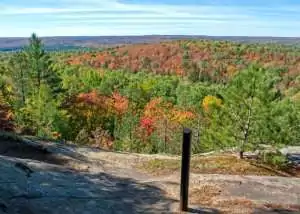
Historically, Algonquin Park has been shaped by the efforts of several notable figures. As you hike, you’ll learn about people like George W. Bartlett and Frank MacDougall, past superintendents who played pivotal roles in the development and conservation of the park. Their stories, along with those of rangers like Mark Robinson, add a human dimension to the natural beauty around you, making your hike both informative and inspiring.
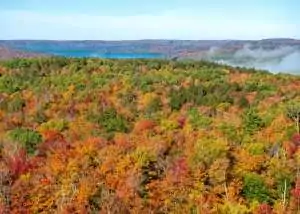
See Also: Centennial Ridges – Best Trails In Algonquin Park For Fall Colors » Algonquin Park
Hardwood Look Out Trail
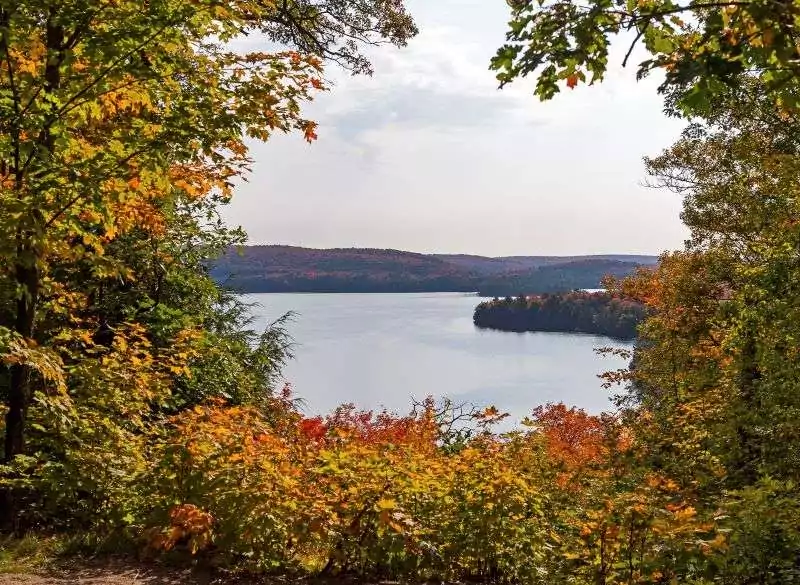
Length: The Hardwood Look Out Trail is a 2.1 km loop that offers an engaging and in-depth nature experience, perfect for those looking for a short but rewarding hike.
Location: Situated at km 39.7 on Highway 60 in the heart of Algonquin Park, the trail is easily accessible. Its precise coordinates are 45.579123°, -78.406543°, making it a convenient stop for park visitors.
Difficulty: Rated as moderate, the trail poses a fair challenge with its steep and rugged parts. It’s well-suited for hikers of average fitness, providing a balanced hiking experience.
Duration: The hike generally takes about 1 hour to complete. This can vary based on your walking speed and the time you spend soaking in the scenic views.
- Scenic Lookout: The crown jewel of the trail is its scenic lookout. This vantage point offers sweeping views of Algonquin Park’s vast wilderness, stretching across several hundred square kilometers. It’s a perfect spot to witness the park’s majestic beauty.
- Autumnal Beauty: The lookout reaches its peak splendor in fall when the leaves turn into a mesmerizing blend of reds, oranges, and yellows, creating a breathtaking panorama.
- Bird Watching: The trail and its surroundings are a paradise for bird enthusiasts. With a variety of bird species inhabiting the area, it’s an ideal spot for bird watching and appreciating wildlife in its natural habitat.
- Photography: Photographers will find the trail’s lookout point a dream location. The expansive landscapes and intricate natural details present endless opportunities for capturing stunning photographs.
- Ideal for Quick Trips: For visitors with limited time or those just passing through Algonquin Park, the Hardwood Look Out Trail is an excellent choice. It offers a condensed yet enriching experience, allowing you to immerse yourself in nature without a lengthy time commitment.

Imagine stepping into a world where the trees tell stories, and the ground beneath your feet holds secrets of an ancient land. That’s the Hardwood Look Out Trail for you. Located at km 39.7 along Highway 60, with coordinates 45.579123°, -78.406543°, it’s like stepping into a different realm, where nature is in its purest form.
Now, let’s talk about what you’ll experience on this trail. First up, it’s a moderate hike, meaning it’s not too easy but not too tough. It’s just right for someone looking for a bit of a challenge without being overwhelming. The trail has some steep parts that will get your heart pumping, but trust me, it’s worth every step. It usually takes about an hour to complete, depending on how fast you walk and how often you stop to take in the stunning views.

But the Hardwood Look Out Trail is more than just pretty views. It’s a living classroom. As you walk, you’ll pass through a hardwood forest that’s typical of Algonquin’s west side. This forest is home to the majestic Sugar Maple, a tree that’s not just on our flag but also plays a crucial role in the forest ecosystem. The Sugar Maple’s thick canopy creates a unique environment below, influencing the life of every plant and animal in the forest.

In short, the Hardwood Look Out Trail is a treasure trove of natural beauty, learning, and adventure. It’s a place where you can challenge yourself, learn about the environment, and be mesmerized by the beauty of nature. So, lace up your hiking boots, grab your camera, and get ready to explore one of Algonquin Park’s most beautiful trails.
See Also: Hardwood Lookout – Algonquin Park Best Trails » Algonquin Park
Hemlock Bluff Trail
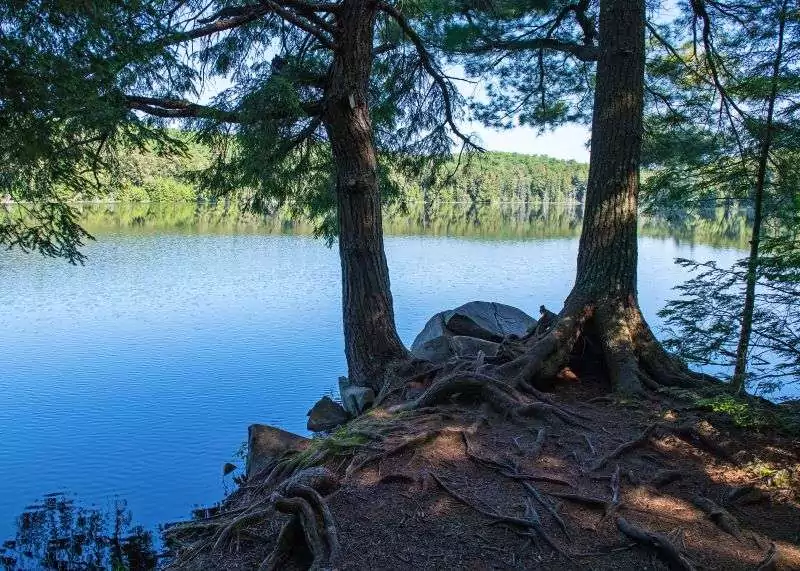
Length: The Hemlock Bluff Trail is a 3.5 km loop trail, offering an immersive experience through a typical west side Algonquin forest.
Location: Situated in Algonquin Provincial Park, this trail takes hikers through a landscape rich in natural beauty and diverse ecosystems.
Difficulty: The trail offers a moderate hiking experience, suitable for those with a basic level of fitness, featuring a blend of easy walks and more challenging sections.
Duration: Typically, the trail takes about 1.5 to 2 hours to complete, varying based on hiking pace and stops to enjoy the scenery.
- Diverse Flora: The trail is renowned for its fine stands of hemlock and a diverse array of local plant species, offering an authentic Algonquin forest experience.
- Scenic Views: A highlight of the trail is the stunning view of Jack Lake, providing a serene and picturesque setting for hikers.
- Educational Experience: The trail has numbered posts corresponding to a guide, offering insights into the research and environmental studies conducted in the park.
- Wildlife Observation: The trail’s diverse ecosystems provide habitats for various wildlife species, making it a great spot for nature enthusiasts and wildlife observers.
- Photography: With its scenic views and diverse flora and fauna, the Hemlock Bluff Trail is a perfect location for photography enthusiasts.
- Educational Value: The trail offers an educational journey through the park’s ecology and research efforts, appealing to those interested in environmental science and conservation.
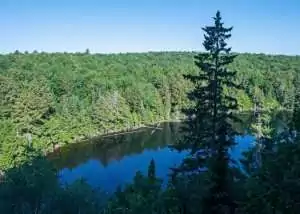
First things first, let’s talk about the view. Picture this: you’re standing on a bluff, gazing out over Jack Lake. The water stretches out below like a giant, sparkling mirror, reflecting the vast sky and lush forests. It’s so breathtaking, you’ll want to snap a bunch of photos. But hey, make sure you take a moment to just enjoy the view, too!
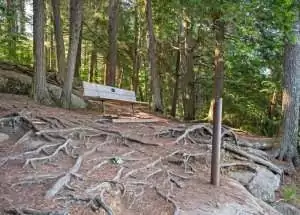
Speaking of wildlife, keep your eyes open for some furry and feathered locals. You might catch a glimpse of a deer darting through the trees, or hear the haunting call of a loon echoing across the lake. And if you’re into birds, bring your binoculars – this place is a birdwatcher’s paradise!

The best part? This trail is perfect for everyone. Whether you’re a hiking pro or just love a good walk, the Hemlock Bluff Trail has got you covered. It’s challenging enough to be exciting, but not so tough that you can’t stop and enjoy the scenery.
So, what are you waiting for? Grab your water bottle, lace up those hiking boots, and join us on this incredible trail. It’s more than just a hike; it’s an experience you’ll remember forever. Come explore the enchanting Hemlock Bluff Trail – where every step is an adventure!
See Also: Hemlock Bluff – Hiking Trails In Algonquin Park » Algonquin Park
Mizzy Lake Trail
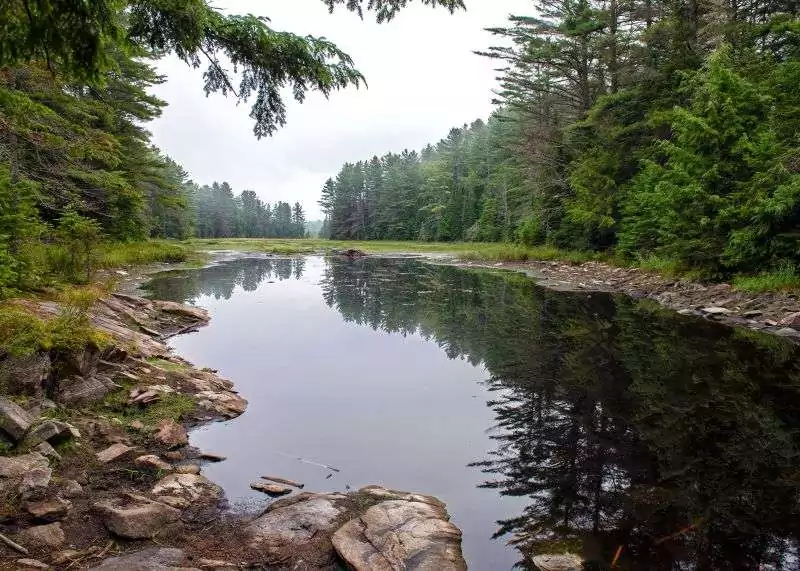
Length: Mizzy Lake Trail is a 10.8-kilometer loop trail, offering an extensive exploration of Algonquin Park’s diverse ecosystems.
Location: The trailhead is situated on Arowhon Road, just off Highway 60 at the 15.4-kilometer mark within Algonquin Park. The area is well-marked and easily accessible for park visitors.
Difficulty: Rated as challenging, the trail features varied terrain, including some uneven and wet sections, making it suitable for hikers with moderate physical fitness.
Duration: Typically, the trail takes about 6 hours to complete. This duration can vary based on hiking speed, wildlife observation stops, and weather conditions.
- Wildlife Observation: Mizzy Lake Trail is renowned for its wildlife viewing opportunities, particularly for spotting moose and beavers in their natural habitat.
- Ecological Diversity: The trail passes through different ecosystems, including wetlands, hardwood forests, and old beaver ponds, showcasing the park’s ecological diversity.
- Educational Posts: Along the trail, there are several educational posts providing insights into the wildlife, plants, and history of the park, enhancing the hiking experience.
- Bird Watching: The trail is a prime spot for birdwatching, with a chance to see a variety of bird species, especially near the lakes and ponds.
- Photography: With its diverse landscapes and wildlife, the trail offers ample photographic opportunities, from capturing intimate wildlife moments to expansive natural scenes.
- Nature Education: Ideal for those interested in learning about the natural environment, the trail offers a rich educational experience, making it perfect for families and nature enthusiasts.
- Long Hike Experience: For visitors seeking a longer, immersive experience in Algonquin Park, Mizzy Lake Trail provides a comprehensive exploration of the park’s natural beauty over several hours.
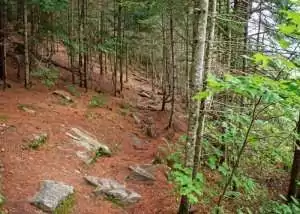
What makes Mizzy Lake Trail stand out is its incredible wildlife viewing opportunities. Imagine walking quietly and spotting a majestic moose grazing near a pond or catching a glimpse of busy beavers working on their dams. The trail is known for being one of the best spots in Algonquin Park to see these animals in their natural habitat, especially if you start early in the morning or linger in the evening. Remember, patience and silence are key to a successful wildlife encounter!

Rated as Challenging, the Mizzy Lake Trail offers just the right amount of adventure for most hikers. While some parts of the trail can be uneven or wet, they add to the sense of adventure. It’s like being a true explorer, discovering the secrets of Algonquin Park with every step. The trail takes about six hours to complete, a perfect day’s adventure for those who love to immerse themselves in nature.

In conclusion, Mizzy Lake Trail is more than just a hiking path; it’s a journey through one of Canada’s most cherished natural landscapes. It’s an adventure that educates, inspires, and connects you with the wild beauty of Algonquin Park. Whether you’re a seasoned hiker or just someone who loves to soak up nature’s wonders, Mizzy Lake Trail promises an unforgettable experience.
See Also: Mizzy Lake – Algonquin Park Walking Trails » Algonquin Park
Spruce Bog Boardwalk Trail
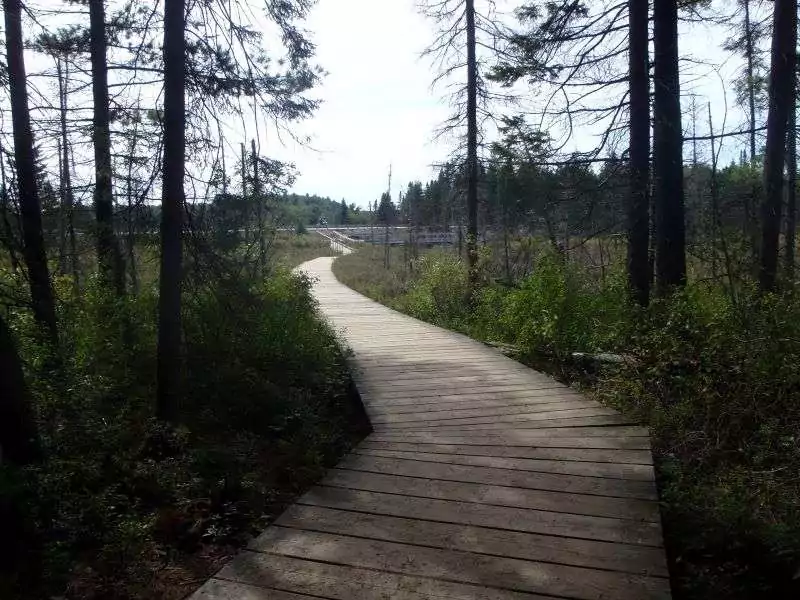
Length: The Spruce Bog Boardwalk Trail is a shorter 1.5 km loop, making it a quick and manageable hike suitable for all ages and fitness levels.
Location: Situated in the heart of Algonquin Park, the trail can be found near the Opeongo Road, providing easy access to visitors. The specific coordinates are approximately 45.607893°N, -78.508423°W.
Difficulty: This trail is rated as easy, making it accessible for beginners and families. Its flat and well-maintained boardwalk path ensures a smooth and comfortable hiking experience.
Duration: On average, hikers can complete the Spruce Bog Boardwalk Trail in about 30 minutes to an hour. However, you can take your time to explore the unique features along the way.
Elevation Gain: The trail has minimal elevation changes, as it primarily consists of a wooden boardwalk. You won’t encounter steep climbs or challenging terrain, allowing for a leisurely stroll.
- Unique Bog Ecosystem: The trail’s main highlight is its exploration of two distinct bogs – the Sunday Creek Bog and a kettle bog. These wetland ecosystems are incredibly rare and offer a glimpse into the intriguing world of acidic, low-nutrient environments.
- Educational Posts: As you walk, you’ll come across educational posts with fascinating information about the bogs, plants, and wildlife. These posts enhance the learning experience, making it both fun and educational.
- Bird Watching: The trail and its surroundings are a haven for various bird species, providing ample opportunities for bird wa Nature enthusiasts can enjoy observing these birds in their natural habitat.
- The Spruce Bog Boardwalk Trail is fully accessible, ensuring that individuals with disabilities can enjoy the natural beauty of the bogs. Its flat and well-maintained boardwalk path accommodates wheelchairs and mobility aids, providing an inclusive experience for everyone. This trail is designed to be barrier-free, allowing individuals of all abilities to explore the unique ecosystems and observe bird species like the Gray Jay and Golden-crowned Kinglet.

The boardwalk, which covers about half of the trail, is like a magic carpet, allowing you to explore this lush, water-logged world without harming it. You’ll feel like a nature detective, uncovering the secrets of this mysterious environment. The trail is equipped with numbered posts, each offering insights into the bog’s history and ecology, making it an engaging outdoor classroom.
Let’s dive into what makes this trail so special. First, the Sunday Creek Bog. It’s a sprawling arm of a larger bog, home to spindly Black Spruce trees and vibrant green carpets of moss. This bog began as a lake, left behind by melting glaciers thousands of years ago. Over time, it transformed into a forest through a natural process where plants and animals played a pivotal role. Isn’t it amazing how nature works?
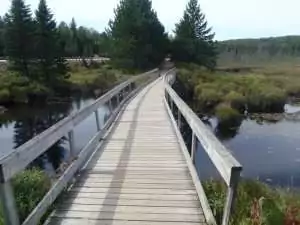
Moving on, you’ll discover the kettle bog, formed in a completely different way. It began with a stranded ice block from the last glacier, which melted to create a deep, water-filled hole. Over time, this hole transformed into the bog you see today.

Spruce Bog Boardwalk is not just a path through nature; it’s a journey through time and an exploration of a delicate and fascinating ecosystem. It’s a place where you can witness the incredible adaptability of nature and the intricate connections that sustain life. This trail is a testament to the wonders of the natural world and a reminder of the beauty and complexity of the ecosystems around us. Whether you’re a nature enthusiast or just looking for a peaceful walk, the Spruce Bog Boardwalk is a captivating experience you won’t forget.
See Also: Spruce Bog Boardwalk – Best Hiking Trails In Algonquin Park » Algonquin Park
Two Rivers Trail
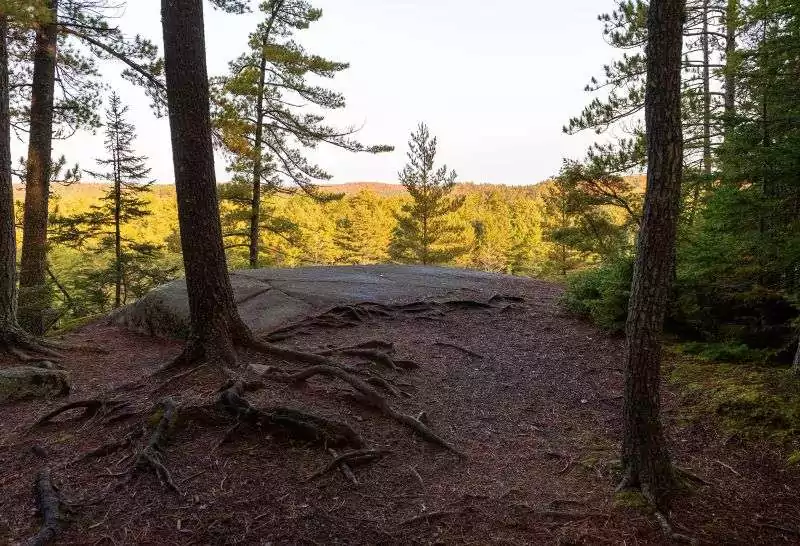
Length: The Two Rivers Trail is a 2.3-kilometer loop, offering a relatively short but engaging hike through the Algonquin Forests.
Location: Situated within Algonquin Park, the trail can be accessed at the trailhead. It’s conveniently located, making it easily reachable for park visitors.
Difficulty: The trail is rated as easy to moderate, making it accessible to a wide range of hikers. While there are some sections that might be a bit challenging, most people with basic fitness levels can enjoy it.
Duration: Typically, it takes about 1.5 to 2 hours to complete the Two Rivers Trail. However, your hiking pace and the time spent admiring the scenery can affect the overall duration.
Elevation Gain: Aproximately 30 meters
- Scenic Overlook: The main highlight of the Two Rivers Trail is the North Madawaska Lookout, located at the top of a cliff. This lookout offers stunning panoramic views of the North Madawaska River and the surrounding forest. It’s a perfect spot for taking in the natural beauty and capturing memorable photos.
- Historical Insights: As you hike along the trail, you’ll come across numbered posts that provide valuable insights into the history of Algonquin forests. These posts share the story of how human activities, such as logging and fires, have shaped the landscape over the years.
- Bird Watching: The Two Rivers Trail offers opportunities for birdwatching, allowing you to observe various bird species in their natural habitat. Keep an eye out for feathered friends like the Cape May Warbler and other forest-dwelling birds.
- Forest Ecology: Explore the ecological changes brought about by events like Spruce Budworm outbreaks and forest fires. Gain a deeper understanding of how these natural processes impact the forest ecosystem and contribute to its resilience.
- Photography: The North Madawaska Lookout provides an excellent setting for photography enthusiasts. Whether you’re capturing the river’s beauty, the forest’s changing landscape, or the remnants of historical logging, there are plenty of photographic opportunities.
- Ideal for Short Visits: If you’re short on time or passing through Algonquin Park, the Two Rivers Trail is a perfect choice. It offers a rich and educational experience without requiring an extended time commitment, making it accessible to all park visitors.

First and foremost, the Two Rivers Trail provides a unique opportunity to witness the ever-changing landscape of Algonquin forests. It’s easy to assume that these woods have been untouched for thousands of years, but the truth is quite different. The forest has been shaped by humans for centuries, and what we see today is a result of logging and fires over the past 175 years. As you hike along, you’ll come across rotting pine stumps, reminding you of the early loggers who played a significant role in altering this landscape.
One of the trail’s highlights is its vantage point at the North Madawaska Lookout, perched atop a cliff. From here, you’ll be treated to breathtaking views of the North Madawaska River, providing a perfect spot for photos and a peaceful moment of reflection. Just remember to keep children and pets under control due to the cliff’s proximity.

One surprising fact you’ll learn is that forest fires aren’t always destructive; they can be a force for renewal. Fires create favorable conditions for new growth by lowering the moisture content of the soil surface, increasing nutrients in the soil, and removing the insurmountable barrier of the duff layer. This natural process benefits many plants, animals, and birds, proving that fires are an essential part of the forest ecosystem.
The trail also showcases a fascinating generational shift in trees, from broad-leaved aspens and birches to evergreen pines, spruces, and balsams. You’ll witness the transition from one generation of trees to the next, with each having its unique appearance and impact on the environment.
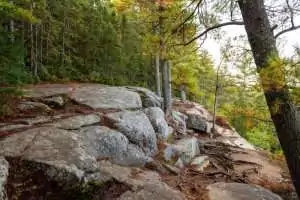
In conclusion, the Two Rivers Trail is a captivating adventure through the Algonquin Forests, where you’ll discover the intricate interplay of nature, history, and human impact. Its scenic views, educational posts, and the story of forest resilience make it a must-visit destination for anyone seeking a deeper connection with nature. So put on your hiking boots, grab your camera, and embark on an unforgettable journey through the heart of Algonquin Forests.
See Also: Two Rivers – Easy Trails In Algonquin Park » Algonquin Park
Whiskey Rapids Trail
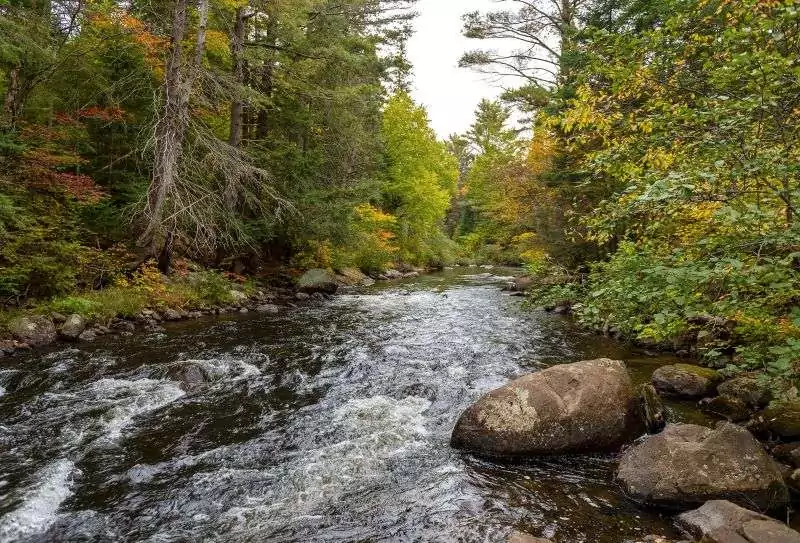
Length: Whiskey Rapids Trail is a 2.1-kilometer loop. This distance makes for an engaging walk that’s neither too short nor too long, perfect for a day’s adventure.
Location: Located within the captivating Algonquin Park, the trail starts at km 7.2 on Highway 60, near the West Gate of the park. Its exact coordinates are not specified, but its accessibility from a major highway makes it easy for visitors to locate.
Difficulty: The trail is considered moderate in difficulty. It’s suitable for most visitors who are comfortable with a bit of a physical challenge. The trail features some rugged terrain and slight elevation changes, adding to its moderate rating.
Duration: On average, the trail takes about 1 to 2 hours to complete. This can vary based on individual pace, stops for rest, or time spent admiring the natural beauty and historical markers along the way.
Elevation Gain: Aproximately 23 meters
- Historical Significance: The trail is not just a path through nature, but a journey through history. It offers insights into the glacial past of the Oxtongue River and the human history of the area, including the story behind the name ‘Whiskey Rapids’.
- Ecological Diversity: The trail allows visitors to explore diverse ecosystems along the Oxtongue River. It highlights the river’s transformation from a mighty glacial river to a serene modern-day stream, rich with wildlife and plant life.
- Riverside Walks and Views: A significant part of the trail follows alongside the Oxtongue River, culminating in views of the picturesque Whiskey Rapids. The proximity to the river provides a tranquil and scenic hiking experience.
- Educational Posts: Along the trail, numbered posts correspond to a guide that details the ecological and historical significance of the area. This feature makes the trail not only a recreational walk but also an educational experience.
- Wildlife Observation: The trail is an excellent spot for observing various wildlife, especially birds and aquatic animals. The rich biodiversity of the area makes it a great place for nature enthusiasts and wildlife photographers.
- Ideal for Varied Interests: Whether you’re a history buff, a nature lover, or a casual hiker, the trail offers something for everyone. Its blend of natural beauty, historical context, and ecological diversity makes it a well-rounded experience.
- Accessibility for Day Visitors: Whiskey Rapids Trail is an excellent choice for those who have limited time but want to experience the essence of Algonquin Park. Its moderate length and engaging content make it perfect for a short but memorable visit.
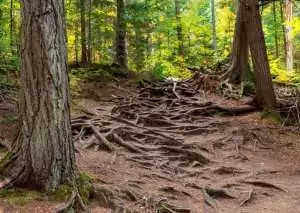
Imagine walking along a trail that’s more than just a path through the woods but a journey through time. About 11,000 years ago, the Oxtongue River, which the trail follows, was a roaring giant, bursting with glacial meltwater. Today, it’s a tranquil stream, meandering through the sandy beds left by its ancient, mightier self. This transformation is a powerful reminder of nature’s ability to change and adapt over millennia.

But what about the tiny worlds beneath the water’s surface? The Oxtongue River is teeming with life, from algae to insects, which play crucial roles in the ecosystem. These micro-habitats are not just interesting; they’re essential for the river’s health and for the animals that rely on them.
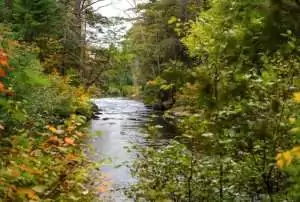
As you walk, keep your eyes peeled for the diverse wildlife. From fish like the White Sucker and Creek Chub to the Belted Kingfisher, each species has adapted uniquely to life along the river. And let’s not forget the role of the blackflies – though a nuisance to us, they’re a vital food source for other animals and play an important role in the river’s ecosystem.
Finally, the trail itself is a piece of history. It runs along an old tote road, a reminder of the days when horses and sleighs were the primary mode of transportation for loggers in the area.
In short, the Whiskey Rapids Trail is a living classroom, offering lessons in ecology, history, and the sheer beauty of nature. It’s a trail that turns a simple walk into an adventure, revealing the intricate connections between all living things and the environment they share. So, lace up your hiking boots and get ready to explore this magnificent trail!
See Also: Whiskey Rapids – Best Trails Algonquin Park » Algonquin Park
Peck Lake Trail
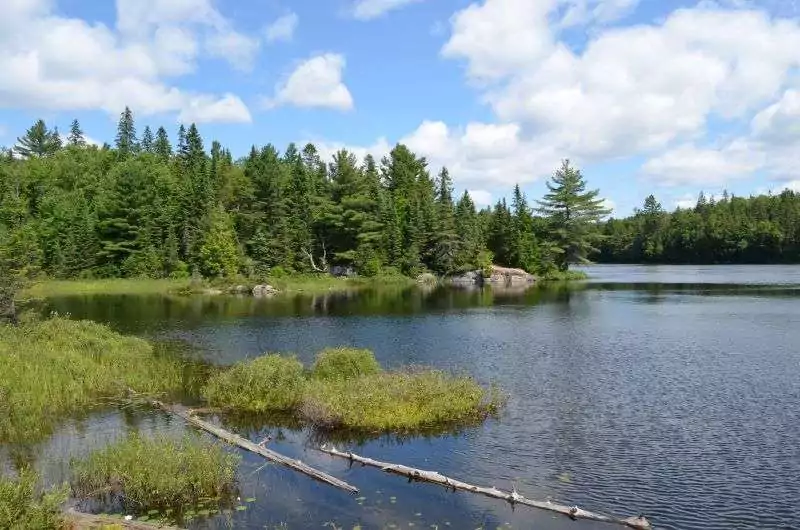
Length: The Peck Lake Trail is a 2.3-kilometer loop, striking the perfect balance between an easy walk and an immersive nature experience.
Location: This trail is situated at km 19.2 along Highway 60 in Algonquin Park. It’s conveniently accessible for park visitors, providing an excellent introduction to the park’s natural beauty.
Difficulty: Rated as moderate, the trail is well-suited for most hikers. It doesn’t feature overly steep or rugged terrain, making it approachable for people with a moderate level of fitness.
Duration: Typically, it takes around 1 to 1.5 hours to complete the trail, depending on walking pace and the time spent at various educational posts.
Elevation Loss: Aproximately 10 meters
- Educational Posts: Unique to Peck Lake Trail are the educational posts along the way. These posts provide insights into the lake’s ecosystem, explaining the fascinating underwater life and processes in an engaging manner.
- Lake Ecosystem Exploration: The trail circles Peck Lake, offering a focus on aquatic ecosystems. It’s an excellent way for visitors to understand the dynamics of a typical Algonquin lake.
- Diverse Flora and Fauna: As you walk, you’ll see a variety of plant and animal life, indicative of the rich biodiversity within Algonquin Park.
- Wildlife Observation: This trail is great for observing different species, particularly those adapted to life in and around the lake. It’s an educational experience that brings textbook ecology to life.
- Photography: The scenic beauty of Peck Lake, coupled with the rich biodiversity, makes this trail a wonderful spot for photography enthusiasts.
- Family-Friendly Education: The trail is an excellent choice for families, especially those with young nature enthusiasts. The educational posts turn a simple hike into an interactive learning experience.
- Ideal for Nature Enthusiasts: For visitors interested in ecology and environmental science, the Peck Lake Trail offers a deeper understanding of lake ecosystems and their importance.
- Seasonal Beauty: While beautiful year-round, the trail offers a special charm during different seasons, with fall colors and spring blooms adding to its appeal.

As you embark on this adventure, you’re greeted by the serene beauty of Peck Lake, a sparkling gem among Algonquin’s thousands of lakes. Its clear, beautiful water and rocky shores are just the beginning of its allure. But Peck Lake is more than just a scenic spot; it’s a living, breathing ecosystem, and the trail offers a deep dive into understanding what makes a lake tick.
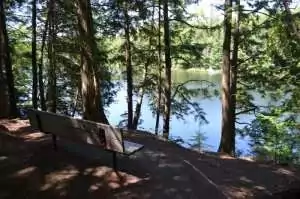
As you journey through the trail, you’ll learn about the critical role of algae, the unseen heroes of the aquatic food chain. These microscopic plants, floating freely in the lake’s upper sunlit layers, are the base of a complex food web. They feed a variety of bizarre and fascinating creatures, from rotifers to copepods, each with its unique adaptation for survival.
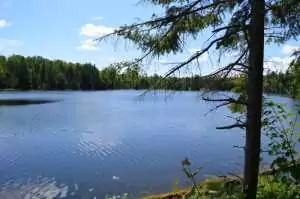
The Peck Lake Trail also delves into the darker but essential aspects of lake life. The process of bacterial decay, critical for recycling nutrients, is explained with engaging clarity. You’ll understand how the death of organisms contributes to the life cycle of the lake, ensuring the continuity of this aquatic world.
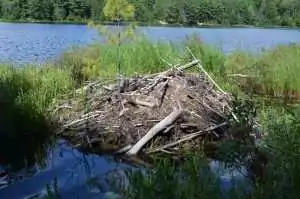
In summary, the Peck Lake Trail in Algonquin Park is more than just a scenic hike; it’s an immersive educational experience. It reveals the hidden workings of a lake ecosystem, making it a must-visit for nature lovers and aspiring ecologists alike. Whether you’re a seasoned hiker or a curious learner, this trail promises a rich blend of beauty, knowledge, and environmental awareness.
See Also: Peck Lake – Hiking Trails Algonquin Park » Algonquin Park
Track & Tower Trail
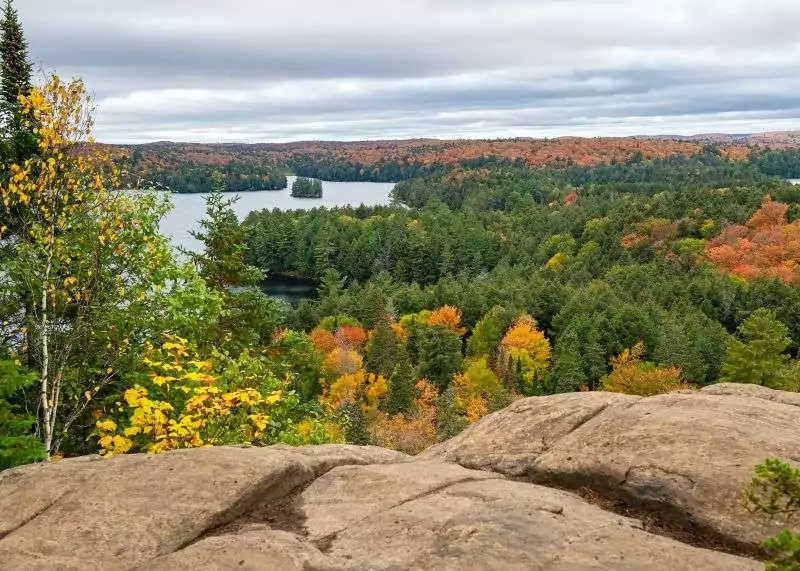
Length: The trail stretches over a 7.5 km loop, with an additional 5.5 km side trail. It’s perfect for those who love a longer hike.
Location: Located at Km 25 on Highway 60 in Algonquin Park, the trail is easily accessible and well-marked.
Difficulty: Rated as moderate, it combines flat sections with some challenging terrain, suitable for hikers with an average fitness level.
Duration: The main loop takes approximately 3 to 4 hours to complete. Adding the side trail might extend your hike by 2 hours.
Elevation Gain: Aproximately 95 meters
- Historical Sites: The trail takes you past the remnants of the Ottawa, Arnprior, and Parry Sound Railway and the Skymount fire tower, merging hiking with a lesson in Canadian history.
- Varied Landscapes: From dense forests to open meadows and rocky outcrops, the trail showcases Algonquin’s diverse ecosystems.
- Stunning Views: The trail offers spectacular views over Cache Lake and the surrounding wilderness, especially enchanting from the fire tower site.
- Wildlife Observation: Home to a variety of wildlife, the trail offers chances to spot deer, beavers, and an array of bird species.
- Photography: With its historical elements and natural beauty, the trail is a paradise for photographers.
- Learning Experience: Informational posts along the trail provide insights into the area’s history and ecology, making it a great educational hike.
- Ideal for Day Trips: Perfect for those looking to spend a day immersed in nature and history, the trail provides a full-day’s adventure.

Spanning 7.5 kilometers, the main loop of this trail is not just a path, but a time machine. It guides you through Algonquin Park’s stunning scenery, leading to the historic Skymount fire tower site. Here, once stood a watchtower, a sentinel in the forest, part of a network of towers where rangers vigilantly scanned the horizon for signs of forest fires. Imagine standing there, amidst tall spruce trees, where once rangers kept watch, safeguarding the forest. It’s like touching a piece of history!

Moreover, the trail is a kaleidoscope of natural wonders. It winds through pristine forests, alongside tranquil lakes, and over gentle hills. You’ll see diverse landscapes, from quiet beaver meadows to rocky outcrops, each telling its own story of the land’s evolution. The trail offers a mix of peaceful solitude and the lively chatter of wildlife, making it an ideal spot for nature lovers and bird watchers.
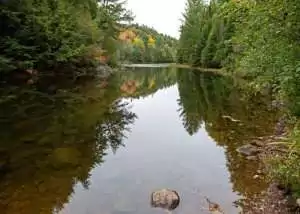
As you hike, remember this trail isn’t just a walk in the park. It’s an exploration of Canada’s natural beauty and a tribute to its historical legacy. The Track and Tower Trail is more than a hike; it’s an adventure through time and nature. So, lace up your hiking boots, grab a trail map, and embark on a journey that promises to be as educational as it is exhilarating!
See Also: Track And Tower – Hiking Trails In Algonquin Park » Algonquin Park

Visiting Algonquin Park is a delight in any season. The landscape transforms throughout the year, presenting a kaleidoscope of nature’s best, from the vibrant autumn foliage to the serene snowscapes of winter, the fresh blooms of spring, and the lush greenery of summer.
For tourists staying with Algonquin Accommodations, the adventure becomes even more accessible. With a complimentary Algonquin Park pass included in your stay, you’re free to explore these magnificent trails and immerse yourself in the natural splendor without any extra cost. This pass is your key to unlocking all the hidden gems within the park, from its diverse wildlife and flora to its stunning lakes and forests. What ever you do, don’t forget to check out the Old Rail Trail, a must see on every visit: Unleash Your Inner Adventurer on the Old Rail Trail in South Algonquin
Algonquin Park is not just a tourist destination; it’s an experience of a lifetime, a peaceful retreat into the heart of nature. It’s a place where every trail leads to new discoveries, and every step is a moment to savor. Pack your bags, prepare for an adventure, and get ready to be captivated by the timeless beauty and tranquility of Algonquin Park’s trails, all made more enjoyable with the convenience and hospitality of Algonquin Accommodations.
See Also: Unleash Your Inner Adventurer on the Old Rail Trail in South Algonquin
Where to stay
Discover a tranquil retreat at Algonquin Accommodations , where the rustic charm of reimagined roadside lodging meets the breathtaking wilderness of Algonquin Park .
Nestled along the edge of one of Canada’s most prized natural treasures, this haven offers an unmatched proximity to the park’s renowned hiking trails, including the historic Old Rail Trail in South Algonquin .
Whether you’re seeking the thrill of an outdoor adventure along the park’s vast network of trails or the serenity of a cozy getaway amidst nature’s splendor, Algonquin Accommodations is your gateway to an unforgettable experience.
Embrace the opportunity to explore the unspoiled landscapes, vibrant wildlife, and tranquil waters that make Algonquin Park a bucket-list destination for nature enthusiasts and adventurers alike.
Welcome to your home away from home, where every stay is a step into the heart of the Canadian wilderness .
More about our propertys: Properties – Algonquin Accommodations
- Dream Catcher Motel
- East Gate Motel
- Bellwood Inn
- Rolling Rapids Motel
- Wilderness Campground
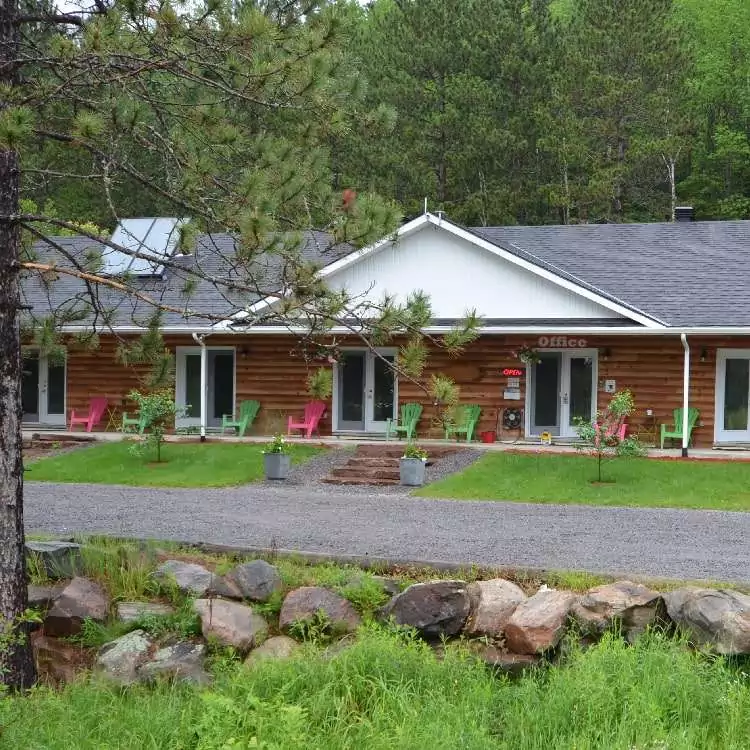
Related Articles

Explore the top Algonquin Park trails along Highway 60 with expert tips

Discover serenity: Your girls getaway weekend itinerary in rural Ontario
Unwind with our ultimate girls getaway weekend itinerary in rural Ontario, perfect
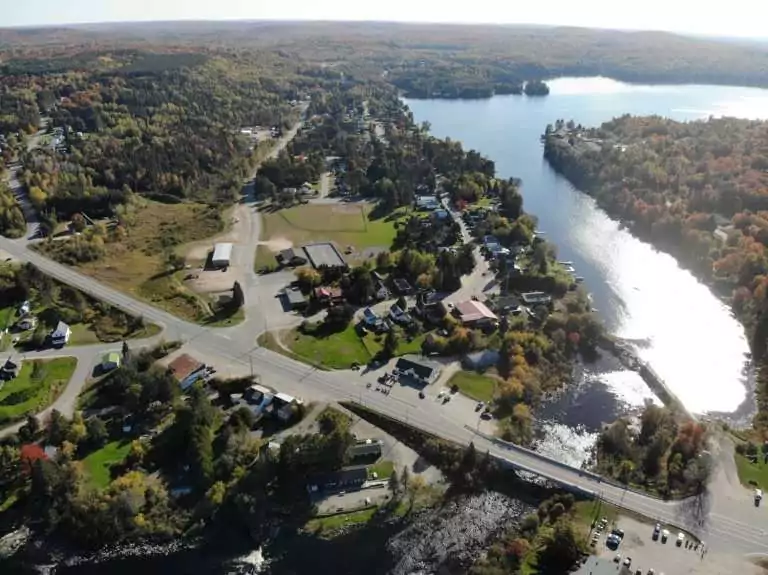
9 Hotels Near Algonquin Park and Other Places to Stay
Find the best place to stay and take advantage of the perks that different hotels near Algonquin Park have to offer.
- 29614 Highway 60, Whitney ON
- [email protected]
- 613-637-1220
- Group Login
- Cancel/Modify Reservation
- Property Policies
- Privacy Policy
- Terms of Service
- Accessibility
Newsletters
Stay in the Loop
Subscribe for exclusive content, giveaways, new products and more!

- Backpacking
- Backcountry Cooking
- Wilderness Medicine
- Destinations
- TRIP REPORTS
Toronto to Algonquin Park: How to Make the Drive Easier and More Fun

Okay, let’s be real. The worst part about a camping trip in Algonquin Park is the transportation to and from the park. Although the drive from Toronto to Algonquin Park isn’t necessarily a long drive, there can be lots of stop and go traffic. And if you do the drive regularly, it can get pretty repetitive.
So in this post I thought I’d provide some information to make the drive a little more manageable and fun. I’ll go over:
- The basics of driving to Algonquin park
- Tips for avoiding traffic between Toronto and Algonquin Park
- Alternatives to driving
- Best places to stop along the drive

This post may contain affiliate links. If you make a purchase through one of these links, I may receive a small commission at no extra cost to you. Your support is much appreciated! You can learn more by reading my full disclosure .
Driving from Toronto to Algonquin Park
Most people drive north on the 400 to Barrie and then take the exit to Highway 11 (towards Huntsville). From there you’ll drive through Gravenhurst, Bracebridge and Huntsville. At Huntsville, you take the exit to the infamous Highway 60, which goes right through Algonquin Park. Huntsville is the last sizeable town before the park and the best place to stop if you realize you’ve forgotten something.
As I said, that’s how most people do it. Depending on traffic, however, it may be smarter to adjust your route. In the section below (Tips for Avoiding Traffic), I’ve listed a few alternative routes you can consider if Google Maps says to expect delays on the usual route.
Tips for Avoiding Traffic between Toronto and Algonquin Park
Avoid the 400 Highway – I’ve found the most frustrating part of the drive to be getting onto the 400 Highway and the stretch of highway before Barrie (where Highway 11 starts). A lot of this traffic comes from people driving to their cottages in the Muskoka Lakes, not those going to Algonquin. If you’re driving on a Friday afternoon or Sunday, avoid the 400 if possible. Instead, you can take the 404 on the east side of Lake Simcoe.
Enter Algonquin through the East Gate – Highway 60 (the road that goes through Algonquin Park) can be incredibly slow, especially in the West-to-East direction. To avoid driving the 400 AND Highway 60, you can take the 407 eastbound, go by Peterborough and north to Whitney. That way, you can enter Algonquin from the east gate.
Avoid driving on Friday afternoon and Sundays – There will be SO much traffic at these times. If you can take a day off work on either side your trip, you will save a ton of time in traffic.
Don’t plan much distance for your first day – This is especially true if you’ll be driving up on a Friday and going to a paddle-in campsite. Expect that traffic will delay you, so don’t plan on covering a huge amount of distance on your first day.

Read More : Canoeing Algonquin: 7 Excellent Algonquin Canoe Routes
Alternative Transportation Options
Honestly, there aren’t a lot of options to go from Toronto to Algonquin Park without a car. There are two services that provide public transport to the general area. I’ve used them both, though I only recommend using them if you’re going to Algonquin alone. If you aren’t alone, it’s actually more economical to rent a car.
And also remember that these only get you to one part of the park – if you want to do hiking trails or go to a different lake, you’ll need a car.
ParkBus is a service that drives people from downtown and north Toronto to several stops along Highway 60 in Algonquin Park. I volunteered for ParkBus for one summer, acting as a bus monitor. It’s actually a very convenient service – they drop off at places like Canoe Lake, Lake Opeongo, Lake of Two Rivers and Pog Lake.
For adults, the return trip costs $127. So if you are going with friends, it probably makes more sense to rent a car. However if none of you can drive or you’re going solo, ParkBus is a great option.
Ontario Northland
Ontario Northland runs public coach buses between Toronto and Ontario’s Near North, and they have a route connecting Toronto to Huntsville. From here, there are a couple of outfitters who can do a shuttle from Huntsville to different Algonquin Park access points.
For example, Algonquin Bound will pick you up from the Huntsville Bus Station and bring you to their store at the West Gate. From there, they can shuttle you to whichever access point or campground you’re going to.
I did this once in university when I didn’t have a car (or any money, for that matter). It was pretty convenient, however it still took way longer than it would take to drive.

Read More : Guided Canoe Trips in Algonquin: The Perfect Introduction to Canoe Camping!
Recommended Stops between Toronto and Algonquin Park
Okay, now the good stuff (and the stuff that inspired this blog post in the first place): Here are my recommended places to stop between Toronto and Algonquin Park. Don’t try to stop at all of them on the same trip – most of them are food related and you’d be uncomfortably full afterwards!
Polar Dip Ice Cream
This is an awesome ice cream shop in Gravenhurst . During the summers when I was working near Bala, I spent a lot of days off in Gravenhurst and this was my favourite place to grab ice cream.
This is easily the most popular stop on the drive between Toronto and Algonquin / Muskoka. It’s located on Highway 11, a little north of Orillia . It’s so popular, in fact, that there’s now a bridge that goes over the highway so people can safely get to Webers from either side of the highway. They have incredible burgers, onion rings and milkshakes.
Warning: If you’re stopping here after a few days in backcountry Algonquin, be careful. The food is super filling and it’s easy to make yourself sick (speaking from experience).
Henrietta’s Pine Bakery
We stopped at Henrietta’s right before my friends and I hiked the Highland Backpacking Trail last summer. And boy oh boy, is this a great bakery. I got the most delicious butter tart, and the bread looked so good. The only regret I had was that we didn’t buy extra sweets to eat at the campsite (I’m sure we could have found room in our backpacks). There is a location in Huntsville, however the one in Dwight is more convenient if you don’t already need to make a detour into Huntsville.
Oliver’s Coffee
I can’t go more than an hour in a car without asking to stop for coffee, and I try to avoid stopping at Tim Horton’s and Starbucks unless necessary. Oliver’s Coffee is a great caffeine stop in Bracebridge with drip coffee, espresso and sandwiches.
Pie Wood Pizza
This is a great place to stop on your drive home from Algonquin. It’s a 15-minute detour off of Highway 11 (at Gravenhurst , go down Highway 169 instead of Highway 11).
Fun fact: This is the first real meal I had after returning from 24 days on the Missinaibi River. My parents drove up to meet me and I devoured a pizza is lightning speed.
Sustain Eco-Store
This is a store in Huntsville that does all natural home, health and wellness products, and they have a ton of interesting low-waste and no-waste products.
The Shipyards Muskoka Market Place
My final recommendation is yet another place in Gravenhurst . The Shipyards is a great place to find nature-inspired jewelry and knick-knacks made by local artists. I’ve found a ton of lovely items here and it’s a great way to support local artists!

Toronto to Algonquin Park: Finals Thoughts & Additional Resources
I hope you’ve found this post helpful and are looking forward to your next trip to Algonquin Park! Here are some additional resources you may find helpful for planning a trip to Algonquin Park.
- Canoeing Algonquin: 7 Excellent Algonquin Canoe Routes
- Algonquin Park Canoe Rentals: How to Choose Your Next Outfitter
- Guided Canoe Trips in Algonquin: The Perfect Introduction to Canoe Camping!
- 11 Algonquin Park Campgrounds: A Helpful Guide to Camping in Algonquin
Mikaela | Voyageur Tripper
Mikaela has been canoeing, hiking and camping for over ten years. She previously worked as a canoeing guide in Canada, and spent a season guiding hiking and kayaking tours in the high Arctic. Mikaela is a Wilderness First Responder and Whitewater Rescue Technician.
MY FAVOURITE GEAR

Fleece Sweater

Down Jacket

Hiking Boots

Hiking Shirt

Hiking Pants
6 thoughts on “ Toronto to Algonquin Park: How to Make the Drive Easier and More Fun ”
Stay in touch.
Join our community of outdoor adventurers - you'll find trip inspiration, gear discussions, route recommendations, new friends and more!
This was really useful. Thank you so much
You’re very welcome, Seun!
Any tips for an Algonquin day trip from the GTA in the winter?
Hmm – leave really early in the morning so you can avoid some traffic and maximize your time in the park. I’d recommend having snow tires and cold weather gear just in case there is a breakdown / traffic jam on the highway. Hope that helps!
Webers is actually very basic burger. There is nothing special about it and the place is charmless and ordering process is factory like. Exiting parking can actually be dangerous when there is traffic as everyone is driving fast and there is little room to get to speed if one has trailer or in motorhome. Literally, any food place is going to be better.
Agree to disagree 😉 It’s definitely become more factory-like since it exploded in popularity and the highway is a little crazy, especially on a Sunday. But I’ve been stopping there since I was a kid going to camp, so I still enjoy it (maybe nostalgia is biasing me). And they definitely don’t have basic milkshakes – those things are 10/10!
Leave a Reply Cancel reply
Your email address will not be published. Required fields are marked *
Save my name, email, and website in this browser for the next time I comment.
- Facebook Group

Guided Trips
Why go on a guided trip? Whether it lasts a few days or a week, a guided canoe trip is ideal for families or groups of friends seeking the extra level of comfort that comes with having an experienced, personable and knowledgeable guide accompanying them. A guided trip allows the first-timer to comfortably experience what can be an intimidating and easily underestimated wilderness environment. People with previous canoe-camping or wilderness travel experience find that having a guide along helps them build new skills and confidently undertake a more challenging route than they may have on their own. Families discover that having a guide to take care of the “nitty-gritty” details of the trip allows them more time to enjoy special wilderness experiences in Algonquin Park together.
Enhance your Algonquin Park experience by booking one of our outfitting packages with a skilled and knowledgeable canoe trip guide. Algonquin Outfitters offers options for both guided day trips and overnight camping experiences in the park's interior. For multi-day canoe camping trips, you can choose the guide service level that best suits your needs and budget: our exclusive "Custom Guided Trip" with our Ultimate Outfitting food and equipment package, the innovative “Guide for a Day” option or the shorter "Greenhorn Service."
Read the descriptions below and click the title or image for complete information on our guided Algonquin Park canoe trips.
Book a Reservation
- Oxtongue Lake
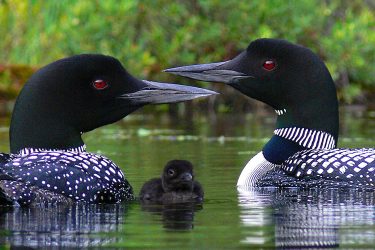
Greenhorn Service
Need a little help getting started? Add Greenhorn Service to any of our complete outfitting packages to start your trip off with a short course in the basics of camping and paddling. One of our experienced guides will go over all the gear and lead you on a “mini-trip” to cover skills like camp setup, food storage, portaging and paddling. This is a cost-effective way to start your Algonquin Park adventure off on the right foot!

Guide for a day
If you are not sure that you need a guide for the whole trip but could use some help at the beginning, this innovative program could be just the ticket. Available as an option with our Ultimate Outfitting package only, this innovative program goes beyond our standard “Greenhorn Service."

Custom Guided Trip
Each trip is custom-designed to the expectations, experience, abilities and interests of the client. A guided trip builds on our Ultimate Canoe Trip Package and allows the “first-timer” to comfortably experience what can be an intimidating and easily underestimated wilderness environment. People with previous canoe-camping or wilderness travel experience find that a guide can enhance their experience.

ALGONQUIN PARK HIKING
Connect with nature moose watching in algonquin park: a spring spectacle.
- Information
- Additional Info
- Similar Tours
- Frequently Asked Questions
What's included
- Guided Hiking
- Return transportation in 15 passenger van or minivan
- Tour guide's tip.
Group Tours Availability
Searching Availability...
Algonquin Park Hiking
Algonquin Provincial Park, known for its stunning landscapes and diverse wildlife, Algonquin Park offers a range of outdoor activities for nature enthusiasts. One of the best ways to experience the park’s natural beauty is through an Algonquin Park hiking tour. What sets Algonquin Park apart is the ever-changing scenery throughout the seasons.
Spring: Wildlife Watching and Moose Spotting
As the snow melts and nature awakens, spring is the perfect time to explore Algonquin Park’s wildlife. Keep your eyes peeled for moose, as they are known to frequent the park during this season. During winter road maintenance operations, salt is applied to Highway 60, which runs through Algonquin Park. This salt attracts moose to the roadside ditches, as they have salt-deficient diets during the winter. This natural phenomenon creates a unique opportunity for visitors to easily spot moose during a leisurely drive along the highway on a spring morning or evening. Please note, Algonquin park hiking tour DOESN’T GUARANTEE A WILDLIFE SPOTTING.
Summer: Hiking and Swimming
With its vast network of trails, Algonquin Park hiking tour offers endless opportunities for hiking enthusiasts. Whether you’re up for a challenging 11 km hike on trails like Mizzy Lake or Centennial Ridges, or prefer a shorter hike to Bat Lake, Visitor Centre, or Ragged Falls, there’s a trail for every skill level. Along the way, take a refreshing dip in one of the park’s crystal-clear lakes to cool off from the summer heat.
If you would like to try canoeing in Algonquin Park, you can join our canoeing and hiking trip from May to October.
Fall: A Spectacle of Colors
When autumn arrives, Algonquin Park transforms into a painter’s palette of vibrant colors. The changing leaves create a breathtaking display that attracts visitors from near and far. Take a leisurely stroll along one of the park’s scenic trails and immerse yourself in the beauty of the fall foliage. Don’t forget your camera, as you’ll want to capture these picturesque moments.
If you are looking for winter experience, join our snowshoeing tour in Algonquin.
Algonquin Park Hiking Trails
What to bring .
- Hand Sanitizer
- Rain Jacket
- Waterproof Shoes
Algonquin Park
- 11.30 am - 1 pm
- 1.15 pm - 1.45 pm
- 1.45 pm - 4.00 pm
- 4 pm - 4.30 pm

Second Hike
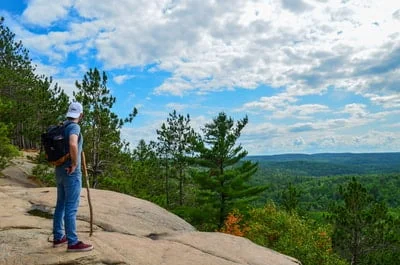
Wildlife Watching
After your last hike, you will drive back to Toronto through the park from east to west . we can often see wildlife such as moose, fox, beaver or black bear along the HWY 60. Keep your eyes open!
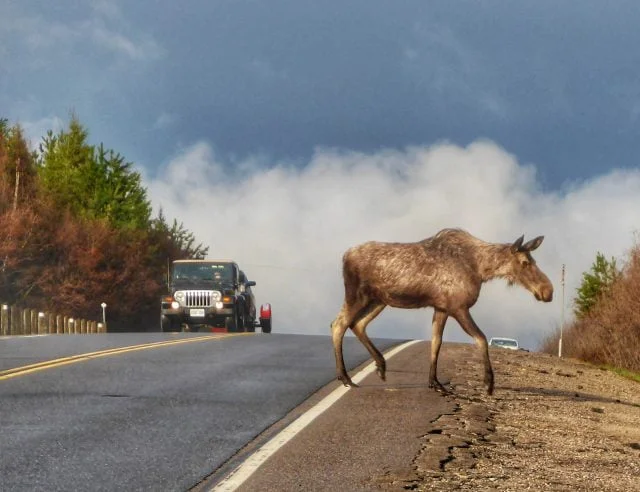
Drop off at Wilson subway station or Dufferin subway station.
More about Algonquin Provincial Park
More about this tour.
Algonquin Park Hiking Tour operates from October to May. If you are looking for summer adventure, join our hiking and canoeing day tour or if you are looking for a winter adventure, join our snowshoeing tour .

- algonquin provincial park
- moose spotting
- moose watching
- snowshoeing

- Tour Search
Get In Touch
Your message (optional)

Sorry! There are no enabled booking or enquiry forms.

- General Park Information
- Recreational Activities
- Visitor Centre, Museum and Exhibits
- Natural and Cultural History
- Park Lodges and Outfitters
- Commercial Services
Events Calendar
- Park Management
- Participate
- Become A Member
- eNews Bulletins
- Store Locations
- Find a Retailer
- Become a Retailer
- Live Algonquin Park Webcam
- Canoe Routes Map Online
- Video Gallery
- Algonquin Park Archives Online
- Submit your Algonquin Park Images
- Wild Bird Cam - Live Stream
- Accomplishments
- Memberships
- Educational Programs
- Board of Directors
- Contact The Friends
- Directions to Algonquin Park
- Algonquin Park Weather
- Algonquin Park Fees
- This Season's Activities
- Travel Trade Industry
- Contact Algonquin Park
Current Weather
Algonquin park fees & permits.
All who use Algonquin Park (or any Provincial Park) must have a valid Park Permit. Permits and applicable fee differ depending upon your use of the Park.
Permits for those visiting Algonquin Park and do not require overnight accommodation. Day use permits are valid from 7:00am to 10:00pm.
- Daily Vehicle Permit - Permit required for non-overnight use of Algonquin Park.
- Seasonal (Day Use) Permit - Permit for unlimited day use access during a season. Valid for all provincial parks in Ontario.
Permits for those staying overnight in a developed campground, backcountry campsite, yurt, ranger cabin, or similar. Visitors with a valid overnight camping permit do not require an additional day-use permit for the same period.
- Camp Cabin Fees
- Ranger Cabin Fees
- Whitefish Group Campground Fees
Related Information
- Frequently Asked Questions (FAQs)
Make A Reservation

Reserve your developed or backcountry campsite for your next visit.
Support Your Park!

Share your passion for Algonquin Park by becoming a member or donor.
No Live Baitfish

Special regulations for Algonquin's special fishery.
Discover Muskoka: Plan Your Trip

- Co-working Spaces
- Music Venues
- Professional Services
- Bracebridge
- Georgian Bay
- Gravenhurst
- Lake of Bays
- Muskoka Lakes
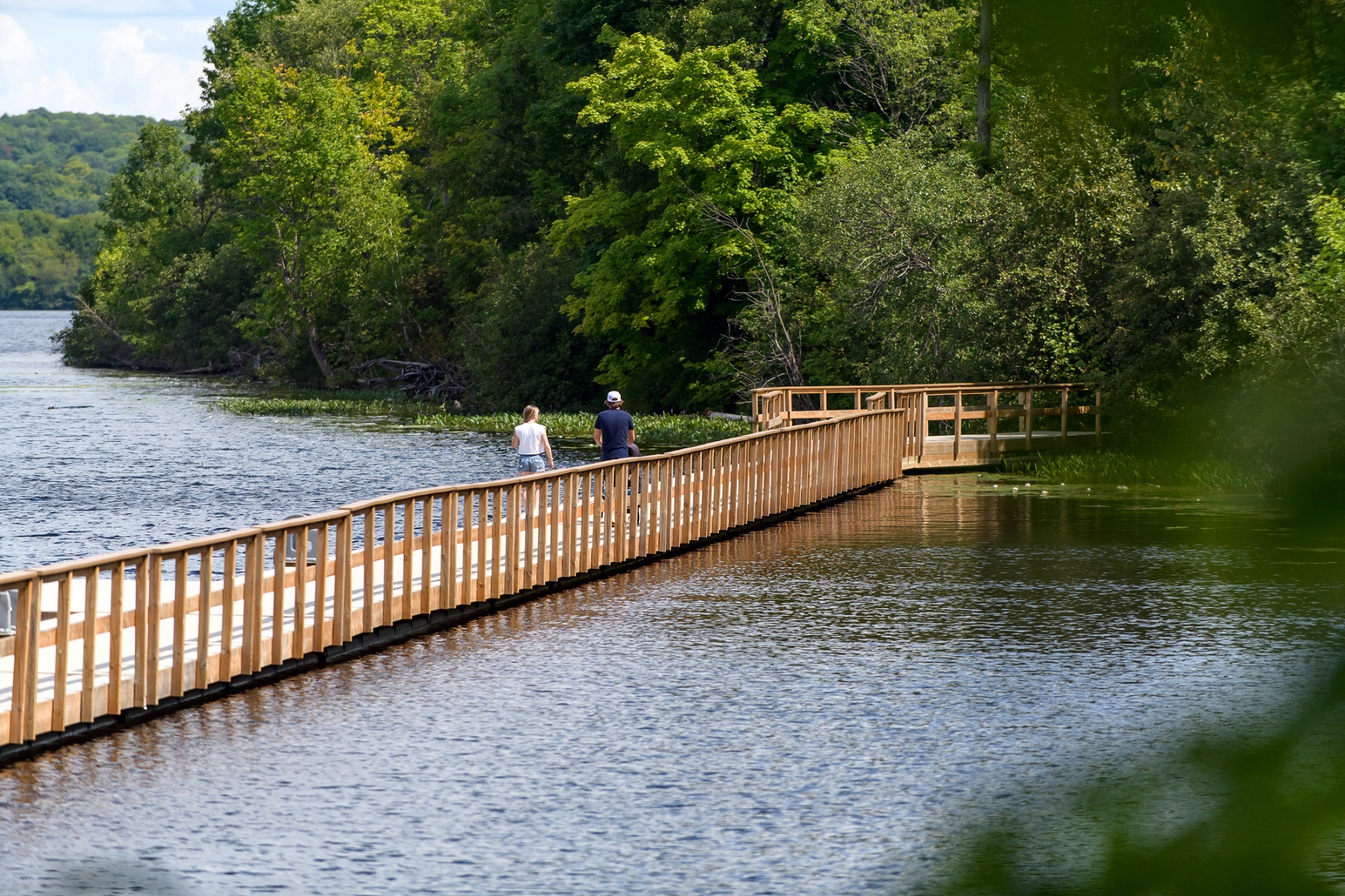
- Arts, Entertainment & Culture
- Boat Cruises
- Craft Breweries & Wineries
- Cycling & Mountain Biking
- Driving Tours
- Family Attractions
- Farmers' Markets
- Hiking Trails & Parks
- Water Adventures
- Winter Activities
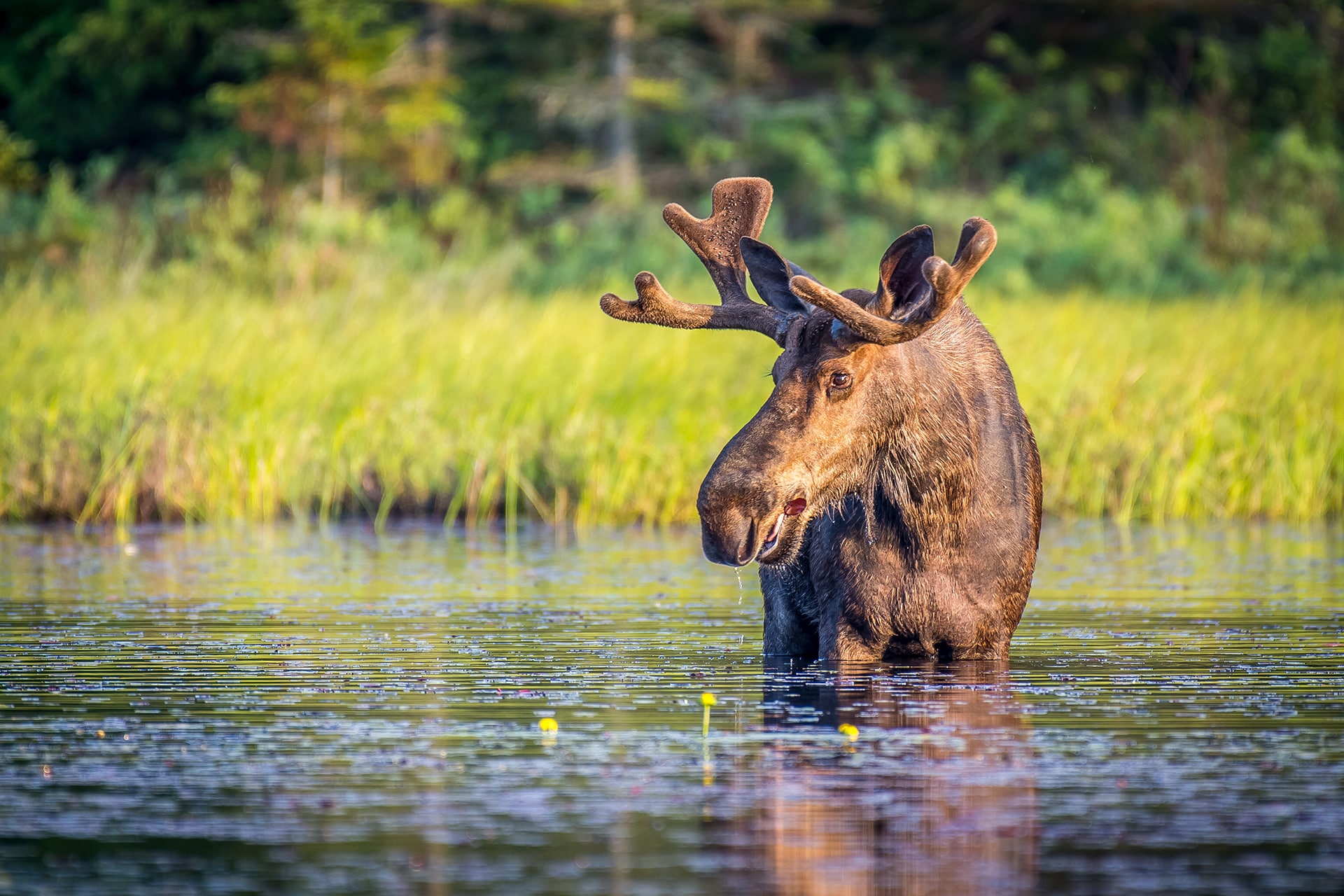
- Inns, Hotels & Motels
- Bed & Breakfasts
- Cottage Rentals & Agencies
- Camping, Glamping & RV Parks
- Cottage Resorts & Lodges
- Family Reunions
- Restaurants
- Bakeries & Snacks
- Last Minute Getaways
- Victoria Day Weekend
- Summer Vacations
- Golf Getaways
- Spring Jaunts
- Romantic Getaways
- Spa Getaways
- Culinary Escapes
- June Events
- July Events
- August Events
- Festivals & Events
- Art Exhibitions
- Sign Up For Our Newsletter
Round Algonquin Park Tour
Ride the rap tour.
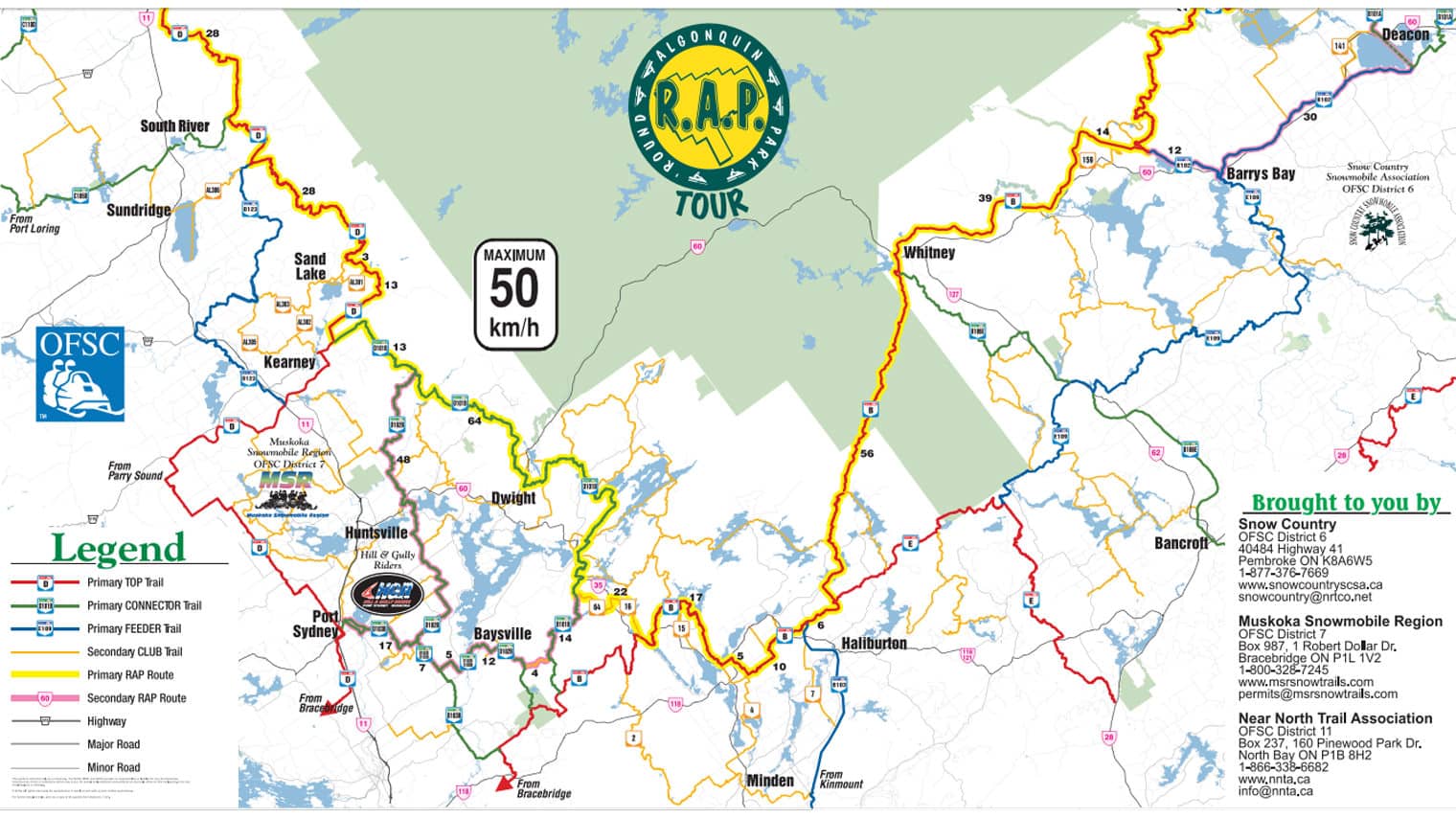
Click here to download a PDF of the full RAP Tour . You can also access the route digitally on the OFSC website. Visit their Interactive Trail Guide , and in the top right corner select the Snow Tours drop-down. Choose Eastern Ontario > R.A.P.
Known as the grand daddy of sled tours, this 850km loop of World famous Algonquin Park is a must-do tour for sledders in Ontario. By far the most popular loop in Ontario, many return year after year to get their fix. Over the 850km stretch sledders get to experience a diverse set of terrain and riding, winding through thick maple forest , across wide open straightaway corridors, past scenic vistas, rolling hills, granite rock outcroppings, snow-covered evergreen pines, and maybe even some wildlife. The tour can be done in 3 days of ‘hard’ snowmobile riding, but many prefer to stretch it out into a more leisurely 4-5 full days, averaging about 200km a day, riding about 6 – 9 hours each day. The great thing about the RAP tour is the people you will meet along the way. Accommodations, restaurants, gas stations and local businesses love sledders and make you feel comfortable and welcome every step of the way. This loop has been called on of the best snowmobiling tours in Ontario, but it also might just be friendliest as well!
Park and Fly in Muskoka
The closest starting point from Toronto for the Round Algonquin Park Tour is Muskoka. Here’s a list of accommodations that welcome sledders, and are near the Round Algonquin Park Tour trails. If you spend the first night and the last night of your trip at these accommodations, you are more than welcome to leave your sled trailer parked on their premises for the duration of your trip. Make sure to make arrangements with accommodations for this during time of your booking.
- Tally Ho Inn located right on Trail #77 on beautiful Penn Lake, halfway between Huntsville and Dwight. Rates start at $93 per cottage midweek. Watch your favorite sports on Shaw Satellite in each cottage.
- Deerhurst Resort in Huntsville has accommodations ranging from hotel style rooms to 3 bedroom condos, as well as on-site restaurants, weekend entertainment, fuel, pool and hot tub.
- Bondi Village Cottage Resort offers comfortable cottage style accommodations with their own cozy wood burning fireplace. Ask about their 15% sledders’ discount
- Blue Spruce Resort offers comfortable cottage or suite accommodation, with ample parking for trailers and trucks
Suggested Round Algonquin Park Tour Itinerary
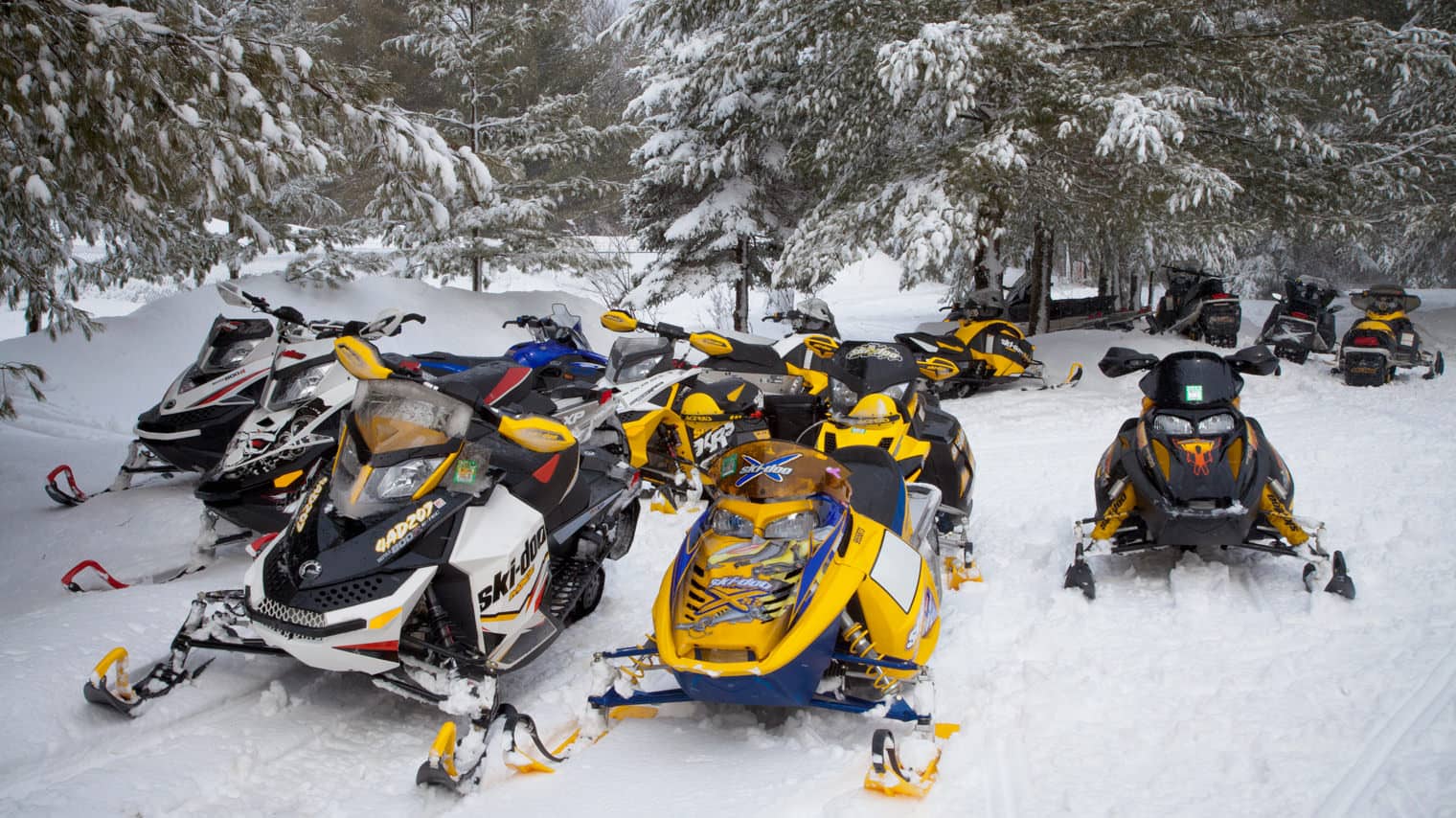
Day 1. Head to Muskoka. Arrive at your Muskoka accommodation for check-in. Complete any last minute errands before your tour. Grab a bite to eat at your hotel’s on-site restaurant, or one of the great establishments in town. Muskoka is a world class desination, and has many great accommodations and restaurants to choose from.
Day 2. Hit the trails bright and early, heading counter clockwise. Wind your way through the rolling hills and valleys of the Muskoka forest, and finish the day with a 37km stretch through the only snowmobile trail in Algonqin Park. End the day in Whitney, a popular sledder’s stayover. Couples Resort and Adventure Lodge are both sled friendly, and offer top notch dinners and breakfasts as part of their packages. Depending on where you stayed the first night, today’s ride will be anywhere from 135km to 180km.
Day 3. The day is yours to enjoy on the trails. The countryside changes from the dense Algonquin forest to the scenic rolling hills of Madawaska Valley. Stay overnight in Pembroke at the Best Western or Holiday Inn Express , both of which are right on the trails and across the street from an Irving Truck Stop Restaurant and gas station. Today’s ride is roughly 150km. If you want to cut down on tomorrow’s ride, stretch out today’s ride to Deep River, and stay at the Bear’s Den Lounge & Motel .
Day 4. You are going to want to get an early start for this one! This is a great stretch, with some wide open trail systems that will let you tack on a few extra clicks. A portion of the trails on this stretch are groomed double wide, as well as some long stretches of forest trail and a number of scenic lookouts. This will definately be your longest stretch on the trails, but you will be rewarded at the end of the day with hot food and accommodation in North Bay at the Best Western . They have a snowmobiler’s rate, restaurant on-site, and secure lock-up for your sleds. Today’s ride will clock in at 277km (230km from Deep River).
Day 5. The home stretch! Sleep in a bit today, you earned it! Wake up to a hot breakfast and get ready for your last day on the trails. This is a more technical section of the RAP Tour, with more turns and bends in the trail. Depending on where you stayed the first night, today’s ride will be anywhere from 135km to 180km. Stay overnight in Muskoka at the same property you stayed at your first night. Eat, drink, and be merry!
Join our newsletter
We'll send you a nice letter once in a while. no spam., in partnership with:.


Algonquin Provincial Park
Park features on this map are representative only and may not accurately depict regulated park boundaries. For official map representation of provincial parks, visit Ontario's Crown Land Use Policy Atlas .
Gatehouse - East Gate
Latitude: 45.536921
Longitude: -78.265419
Achray Campground - From Sand Lake Gate, follow Barron Canyon Road for 19.2 km, then turn left onto Achray Road. Proceed 4.8 km to the access point and Achray Campground. Please note: Achray Campground may only be accessed using the Barron Canyon Road through Sand Lake Gate.
Latitude: 45.86837755341280
Longitude: -77.7566385269165
Brent - Brent Campground
Latitude: 46.0262899719346
Longitude: -78.48864555358890
Canisbay Lake - Canisbay Lake Campground
Latitude: 45.563650787746000
Longitude: -78.59218955039980
Raccoon Lake - Raccoon Lake Campground
Latitude: 45.538553
Longitude: -78.405518
Kearney Lake - Kearney Lake Campground
Latitude: 45.572390
Longitude: -78.439884
Kiosk - Kiosk Campground
Latitude: 46.090852848331100
Longitude: -78.88372421264650
Lake of Two Rivers - Lake of Two Rivers Campground
Latitude: 45.580182
Longitude: -78.502312
Mew Lake - Mew Lake Campground
Latitude: 45.576174
Longitude: -78.516218
Pog Lake - Pog Lake Campground
Latitude: 45.571191
Longitude: -78.450255
Rock Lake - Rock Lake Campground
Latitude: 45.526070
Longitude: -78.409959
Tea Lake - Tea Lake Campground
Latitude: 45.513898
Longitude: -78.720045
Whitefish Lake - Whitefish Lake Group Campground
Latitude: 45.563290
Longitude: -78.437862
Trailhead - Bat Lake Trail
Latitude: 45.577008
Longitude: -78.521885
Trailhead - Booth's Rock Trail
Latitude: 45.518071
Longitude: -78.399392
Trailhead - Leaf Lake Ski Trails
Latitude: 45.551148
Longitude: -78.268995
Trailhead - Peck Lake Trail
Latitude: 45.547449
Longitude: -78.648729
Trailhead - Two Rivers Trail
Latitude: 45.579677
Longitude: -78.512986
Trailhead - Big Pines Trail
Latitude: 45.580421
Longitude: -78.399346
Trailhead - Hardwood Lookout Trail
Latitude: 45.528702
Longitude: -78.705949
Trailhead - Highland Backpacking Trail
Latitude: 45.572650
Longitude: -78.525139
Trailhead - Track & Tower Trail
Latitude: 45.560240
Longitude: -78.577272
Trailhead - Fen Lake Ski Trail
Latitude: 45.441590
Longitude: -78.819791
Trailhead - Spruce Bog Boardwalk
Latitude: 45.587075
Longitude: -78.373091
Trailhead - Hemlock Bluff Trail
Latitude: 45.564846
Longitude: -78.551855
Trailhead - Lookout Trail
Latitude: 45.578876
Longitude: -78.406621
Trailhead - Mizzy Lake Trail
Latitude: 45.542422
Longitude: -78.695316
Trailhead - Minnesing Mountain Bike Trail
Latitude: 45.555980
Longitude: -78.602760
Trailhead - Western Uplands Backpacking Trail
Latitude: 45.463207
Longitude: -78.797998
Trailhead - Barron Canyon Trail - Sand Lake Gate, follow Barron Canyon Road west for approximately 10km. Turn left into the parking lot.
Latitude: 45.889200
Longitude: -77.634579
Commercial Lodging - Bartlett Lodge
Latitude: 45.551166
Longitude: -78.598545
Trailhead - Beaver Pond
Latitude: 45.592226
Longitude: -78.340170
Museum - Logging Museum
Latitude: 45.543765
Longitude: -78.263225
Gatehouse - West Gate
Latitude: 45.442046
Longitude: -78.820583
Commercial Lodging - Arowhon Pines Lodge
Latitude: 45.598076
Longitude: -78.694416
Day Use - Lake of Two Rivers Picnic Ground and Beach
Latitude: 45.585549
Longitude: -78.479076
Day Use - Oxtongue River Picnic Ground
Latitude: 45.463135
Longitude: -78.797742
Backcountry Access Point - Opeongo Access Point
Latitude: 45.635598
Longitude: -78.360905
Day Use - Canisbay Lake Picnic Ground
Latitude: 45.56630977275030
Longitude: -78.59184622764590
Art Gallery - Art Centre
Latitude: 45.550827
Longitude: -78.639287
Commercial Lodging - Killarney Lodge
Latitude: 45.585614
Longitude: -78.486111
Day Use - Tea Lake Dam Picnic Ground
Latitude: 45.492167
Longitude: -78.748502
Point of Interest - Whitefish Pow Wow Site
Latitude: 45.550654
Longitude: -78.417990
Day Use - Costello Creek Picnic Grounds
Latitude: 45.599155
Longitude: -78.330431
Beach - East Beach
Latitude: 45.577125
Longitude: -78.460048
Outfitter - Portage Store & Canoe Centre
Latitude: 45.53498735530520
Longitude: -78.70766401290890
Outfitter - Two Rivers Store
Latitude: 45.579616
Longitude: -78.506865
Trailhead - Whiskey Rapids
Latitude: 45.485398
Longitude: -78.756271
Outfitters - Opeongo Store & Canoe Centre
Latitude: 45.635540
Longitude: -78.360318
Visitor Centre - Visitor Centre
Latitude: 45.584135
Longitude: -78.359589
Kawawaymog (Round) Lake - In South River on Hwy 11, turn east at Ottawa Avenue. Follow this road (paved for 15 km, then gravel) for 21.6 km to the Access Point Office.
Latitude: 45.922976
Longitude: -79.184990
Tim River - At Emsdale on Hwy 11, turn east and follow Hwy 518 for 8 km to Kearney. The Park Office can be found in the town of Kearney at 1734 Highway 518. Then continue on Hwy 518 for 14.4 km and turn right onto the Forestry Tower Road. Follow it for 19 km to the access point on the Tim River. Tim Lake, inside Algonquin Provincial Park, is 2 km downstream (east).
Latitude: 45.740064
Longitude: -79.060106
Magnetawan Lake - At Emsdale on Hwy 11, turn east and follow Hwy 518 for 8 km to Kearney. The Park Office can be found in the town of Kearney at 1734 Highway 518. Then continue on Hwy 518 for 14.4 km to the Forestry Tower Road and follow it for another 24.2 km to the access point.
Latitude: 45.668067
Longitude: -78.986728
Rain Lake - At Emsdale on Hwy 11, turn east and follow Hwy 518 for 8 km to Kearney. The Park Office can be found in the town of Kearney at 1734 Highway 518. Turn south at this corner onto Main Street and follow it across the bridge for 0.5 km. Turn east onto Rain Lake Rd. and follow this road (paved at first, then gravel) for 24.5 km straight through to the access point.
Latitude: 45.603500
Longitude: -78.952518
Canoe Lake - At km 14.1, a short road leads north to the Access Point Office.
Latitude: 45.535032
Longitude: -78.706570
Smoke Lake - At km 14.1, a short road leads south to the access point. Information is available at the Access Point Office on Canoe Lake (#5).
Latitude: 45.533032
Longitude: -78.701837
Source Lake - At km 20.1, follow a gravel road north for 1.6 km to the access point. Information is available at the West and East Gates, and the Access Point Office on Canoe Lake (#5).
Latitude: 45.564304
Longitude: -78.63224
Cache Lake - At km 23.5, follow a gravel road south for 200 metres to the access point. Information is available at the West and East Gates, and the Access Point Office on Canoe Lake (#5).
Latitude: 45.551819
Longitude: -78.593209
Rock Lake - At km 40.3, follow the Rock Lake Road (gravel) south for 8 km to the Rock Lake Office for information. Continue 150 metres to the access point.
Latitude: 45.525077
Longitude: -78.413210
Sunday Creek - At km 42.5, Hwy 60 crosses Sunday Creek, providing an access point. Parking is available at the nearby Spruce Bog Boardwalk trail entrance. Information is available at the West and East Gates.
Latitude: 45.587205
Longitude: -78.373677
Lake Opeongo - At km 46.3, follow the Opeongo Road north for 6.2 km to the Access Point Office.
Latitude: 45.635804
Longitude: -78.360447
Galeairy Lake - At Whitney, 5.6 km east of the East Gate on Hwy 60, turn south on Ottawa Street and continue 0.7 km to Second Avenue, turn right and follow a short gravel road to the public boat launch. Overnight parking available at 41 Hay Creek Road in Whitney. Information is available at the East Gate.
Latitude: 45.489075
Longitude: -78.242151
Hollow River-Dividing Lake - From Hwy 35, 1.1 km north of the village of Dorset, turn east onto County Road 8 (Kawagama Lake Road). Follow this road 0.8 km to the intersection with County Road 12 (Livingstone Lake Road). Follow County Road 12 for 23.1 km to the landing/parking area. Information is available by contacting the Park at 613-637-2780 ext. 229 or at the West Gate.
Latitude: 45.370117
Longitude: -78.722191
Kingscote Lake - From Hwy 648, 1.6 km east of the village of Harcourt, follow the Elephant Lake Road north for 12.3 km. Turn left onto the Kingscote Lake Road and follow it for 7 km. Keep right to the access point. Information is available by contacting the Park at 613-637-2780 ext. 229.
Latitude: 45.188173
Longitude: -78.232629
Hay Lake - From Hwy 127, 9.9 km south of Hwy 60, follow the McRae-Hay Lake Road west for 4.6 km, keeping to the left, to the public boat launch. A 4 km paddle takes you to the boundary of Algonquin. Information is available at the East Gate.
Latitude: 45.383236
Longitude: -78.164693
Shall Lake - From the village of Madawaska on Hwy 60, follow the Major Lake Road (paved, then gravel) NW for 26.2 km (crossing the hydroelectric transmission corridor) to the Access Point Office.
Latitude: 45.649107
Longitude: -78.099287
Aylen Lake - From Hwy 60, 11.8 km east of the village of Madawaska, follow the Aylen Lake Road north for 7.8 km, turn left crossing over a dam and continue 0.4 km, turn left onto North Aylen Lake Road (gravel) and continue for 9km to the access point parking lot. From the parking lot you portage 4km into Wilkins Lake on the cart trail. Information available by contacting the Park at 613-637-2780 ext. 229.
Latitude: 45.651084
Longitude: -77.918515
Basin Lake - From a point on Hwy 58, 7.3 km north of Round Lake Centre, travel to Bonnechere Provincial Park for permits and information for the Basin Lake area. Proceed to Turner’s Road/Basin Depot Lake Road (opposite the Bonnechere Park entrance) and travel 16 km (on pavement, then gravel) to the Park boundary which provides access to Basin Lake (at km 14.3), Foys Lake (at km 23.6), and to the Bonnechere River at the hydroelectric transmission corridor (at km 35).
Latitude: 45.657499
Longitude: -77.580225
Mallard/Sec Lakes - From the Sand Lake Gate, go back 2.5 km east, turn right, and proceed 2 km to the lake. Updates of permit information and the purchase of Additional Vehicle Permits can be done at Sand Lake Gate.
Latitude: 45.830102
Longitude: -77.542750
McManus Lake - At a point 6.4 km beyond the Sand Lake Gate, turn right (north) and proceed 8.3 km to the south end of McManus Lake. Note that travel below McManus Lake on the Petawawa River is prohibited because of the military artillery range, and travel upstream is difficult beyond Whitson Lake. This access point serves chiefly as a pick-up spot for canoeists descending the Petawawa River from Lake Travers.
Latitude: 45.9446
Longitude: -77.6078
Grand Lake-Achray - At a point 19.2 km west of the Sand Lake Gate, turn left and proceed 4.8 km to the access point and Achray Campground.
Latitude: 45.8671
Longitude: -77.7582
Lake Travers - Continue on the main road past the Sand Lake Gate for 54.4 km before reaching the access point at the mouth of the Petawawa River at the SW tip of Lake Travers. Please note: this area of the park may only be accessed via Barron Canyon/Lake Travers roads through Sand Lake Gate.
Latitude: 45.960188
Longitude: -78.062545
Bissett Creek Road - From Pembroke, travel west on Hwy 17 for 93.6 km, then go south for 18 km on Bissett Creek Road (gravel) to the access point at the park boundary. Information is available at the Brent Access Point Office on Brent Road.
Latitude: 46.200121
Longitude: -77.881774
Wendigo Lake - Just west of Deux Rivières on Hwy 17, turn south on Brent Road (gravel) and travel 0.5 km to the Access Point Office. Continue 16 km and turn left onto the Wendigo Lake access road, 1.9 km to the access point.
Latitude: 46.132946
Longitude: -78.295508
North River Lake - Just west of Deux Rivières on Hwy 17, turn south on Brent Road (gravel) and travel 0.5 km to the Access Point Office. Then travel 26.4 km on the Brent Road to the access point on the North River.
Latitude: 46.098940
Longitude: -78.423090
Cedar Lake-Brent - Just west of Deux Rivières on Hwy 17, turn south on Brent Road (gravel) and travel 0.5 km to the Access Point Office. Then continue on the Brent Road for 40 km to the access point and Brent Campground.
Latitude: 46.025477
Longitude: -78.486176
Brain Lake - From a point on Hwy 17, 10.7 km west of Mattawa, turn south on the Calvin Township Road (gravel). Follow this road for 2.1 km then turn right and travel for another 2.1 km; turn left and proceed for 4.2 km, past the first intersection. At the second intersection, turn right and follow this road for 20.1 km to the access point on the SW shore of Brain Lake.
Latitude: 46.10612
Longitude: -78.689065
Kioshkokwi Lake-Kiosk - From Hwy 17, 17.6 km west of Mattawa, follow Hwy 630 south for 30.4 km to the Access Point Office.
Latitude: 46.090153
Longitude: -78.881519
Western Uplands Backpacking Trail Via Rain Lake - At Emsdale on Hwy 11, turn east and follow Hwy 518 for 8 km to Kearney. The Park Office can be found in the town of Kearney at 1734 Highway 518. Turn south at this corner onto Main Street and follow it across the bridge for 0.5 km. Turn east onto Rain Lake Rd. and follow this road (paved at first, then gravel) for 24.5 km straight through to the access point.
Highland Backpacking Trail - At km 29.7 on Hwy 60, a short gravel road leads south to a parking lot and the entrance to the trail on the shore of Pewee Lake. Information is available by contacting the Park or by visiting the Mew Lake Campground from late April through October.
Latitude: 45.573014
Longitude: -78.525263
Eastern Pines Backpacking Trail - Trail via Sand Lake Gate/Achray. See Access Point #22 (Grand Lake-Achray).
Latitude: 45.8674
Longitude: -77.7560
Canisbay Lake Paddle-In Campsites - At km 23.1 on Hwy 60, a paved road leads north for 1 km to the Canisbay Lake Campground Office for information, and the Canisbay Lake day-use area provides parking for, and access to, the paddle-in sites.
Latitude: 45.566
Longitude: -78.601
Barron River / Squirrel Rapids Parking Lot - From Sand Lake Gate, continue west on Barron Canyon Road for approximately 2km. Turn left into the parking lot.
Latitude: 45.87175
Longitude: -77.55992
Brigham Lake Parking Lot - From Sand Lake Gate, continue west on Barron Canyon Road for approximately 15km. Turn left into the parking lot.
Latitude: 45.889778
Longitude: -77.681359
Sand Lake Gate - Barron Canyon Road to Grand Lake and Lake Travers. On the Hwy 17 bypass 3.5 km west of the Forest Lea Road (approx. 9 km west of Pembroke), turn south on County Road 26 (Doran Road). Travel 300 m, then turn right onto County Road 28 (Barron Canyon Road) and travel 26 km (on pavement, then gravel) to the Sand Lake Gate at the Park boundary. Please note: Sand Lake Gate is the only entrance to Algonquin East Access Points: 20 - Mallard/Sec, 21 - McManus Lake, 22 – Grand Lake/Achray 23 - Lake Travers, and 33 - Eastern Pines Backpacking Trail. These Access Points must be accessed via Barron Canyon Road through Sand Lake Gate.
Latitude: 45.854863
Longitude: -77.545536
Park Maps (pdf)

2025 COMMUNITY PROJECT FUNDING REQUESTS
Congressman Krishnamoorthi has submitted funding requests for important community projects for Illinois’ 8th Congressional District to the House Appropriations Committee.
Under guidelines issued by the Appropriations Committee, each Representative may request funding for projects in their community for fiscal year 2025 – although only a handful may actually be funded. Projects are restricted to a limited number of federal funding streams, and only state and local governments and eligible non-profit entities are permitted to receive funding.
In compliance with House Rules and Committee requirements, Rep. Krishnamoorthi has certified that he, his spouse, and his immediate family have no financial interest in any of the projects he has requested funding for. Projects below are listed alphabetically.
Project Name: Algonquin Road Grade Separation Project
- Proposed Recipient: City of Des Plaines
- Recipient Address: 195 E Algonquin Rd, Des Plaines, IL 60016
- Project Location: Algonquin Road to Mt. Prospect Rd, Des Plaines, IL 60016
- Amount Requested: $1,800,000
- Description of Request: The funding would be used for the construction of an overpass on Algonquin Road from Mt. Prospect Road to Wolf Road and over the Union Pacific railroad tracks. The overpass would significantly reduce emergency response times for first responders, increase safety, improve air quality, increase overall transportation efficiency, and create a more seamless and reliable transportation network for the community.
The financial disclosure document for this project is linked here .
Project Name: Batavia Fox River Bike Path
- Proposed Recipient: City of Batavia
- Recipient Address: 100 N Island Avenue, Batavia, IL 60510-1930
- Project Location: West bank of the Fox River at approximately 400 Shumway Ave, Batavia, IL 60510
- Amount Requested: $8,166,000
- Description of Request: This project includes construction of a new segment of the Fox River Regional Trail in Batavia. The proposed segment will be located along the west side of the Fox River between the river and the City of Batavia’s WWTF. The proposed segment will improve connectivity along the multi-use Fox River Trail, as well as add new safety and guidance features for pedestrians and cyclists. Its location will also enhance views of the river and activate the resident connection to our most cherished community asset. The Fox River Trail is a regional, multi-use system that extends from Oswego to Algonquin and provides alternative modes of transportation to over 100,000 residents in the Fox Valley. The specific section of the path in Batavia was significantly disturbed by an expansion of the WWTF to meet new federal regulations on phosphorus and end of life concerns. Therefore, the older existing trail would likely still be there if the WWTF was not required to be updated both due to federal regulations and end of life concerns. Even prior to these changes, path routing was not ideal as it took residents off a dedicated bike and pedestrian path and put them on the side of the road.
Project Name: Brantwood Avenue Water Main Lining Project
- Proposed Recipient: Elk Grove Village
- Recipient Address: 901 Wellington Ave, Elk Grove Village, IL 60007
- Project Location: Brantwood Avenue and Arlington Heights Road, Elk Grove Village, IL 60007
- Amount Requested: $800,000
- Description of Request: The funding would be used to rehabilitate a Village distribution water main, preventing contamination caused by leaks and breaks of the pipe. This section of water main is on the Village’s high priority list due to its age and propensity for water main breaks. There have been a total of 55 breaks of this main, with 14 of those happening over the past 5 years, with one of the breaks turning into a catastrophic event that included six chain-reaction breaks on the main, leaving property owners without water for an extended timeframe.
The financial disclosure document for this project is linked here .
Project Name: DuPage Water Commission Regional Source Water Project
- Proposed Recipient: DuPage Water Commission
- Recipient Address: 600 East Butterfield Road, Elmhurst, Illinois 60126
- Project Location: 600 East Butterfield Road, Elmhurst, Illinois, 60126
- Amount Requested: $1,000,000
- Description of Request: The funding would be used to conduct a Phase 1 engineering study for the Regional Source Water Project. The project consists of replacing aging infrastructure that is nearing the end of its useful life and addressing emerging contaminants to help meet Safe Drinking Water Act standards. It will include the construction of a new Lake Michigan raw water intake, a new regional drinking water treatment plant, and distribution infrastructure including tunnels, pipelines, and pumping stations. The project will provide a stable, predictable, and reliable drinking water supply that will support growth and attract business investment in Northeastern Illinois. It is expected to benefit up to 2 million residents in DuPage and Cook counties.
Project Name: Elgin Community College Advanced Manufacturing Training Equipment
- Proposed Recipient: Elgin Community College
- Recipient Address: 1700 Spartan Drive, Elgin, IL 61023-7193
- Project Location: 1700 Spartan Drive, Elgin, IL 61023-7193
- Amount Requested: $2,385,000
- Description of Request: The funding would be used to acquire advanced manufacturing training equipment that will support programming for a 150,000 square foot Manufacturing and Technology Center. The project will support manufacturing in Chicago’s far northwest suburbs, as well as fill a critical gap in the local economy by educating and training the region’s most under-resourced residents.
Project Name: Fox River Water Reclamation District: Construction + Installation of Debris Filtering Water Screens
- Proposed Recipient: Fox River Water Reclamation District
- Recipient Address: 1957 N La Fox St, South Elgin, IL 60177
- Project Location: 1957 N La Fox St, South Elgin, IL 60177
- Description of Request: The funding would be used to construct and install bar screens at the major influent pump station to the Albin D. Pagorski Water Reclamation Facility, to remove large debris, protect downstream equipment and processes, and to enhance the facility's efficiency and environmental impact. The project will remove large debris and solid materials from the wastewater stream, prevent sewage overflows, protect aquatic habitats, and achieve and maintain clean and healthy water resources that comply with Clean Water Act standards.
Project Name: Hammond Drive at Algonquin Road Intersection Improvements
- Proposed Recipient: Village of Schaumburg
- Recipient Address: 101 Schaumburg Court, Schaumburg, IL 60193
- Project Location: Intersection of Hammond Drive and Algonquin Road, Schaumburg, IL 60173
- Amount Requested: $1,152,000
- Description of Request: The funding would be used to enhance the intersection of Hammond Drive and Algonquin road by widening the radius to accommodate large trucks and prevent curb encroachment, and implement more road signage and lighting to facilitate pedestrian crossings. The project will increase public safety and accessibility for residents and pedestrians accessing businesses on the south side of the intersection.
Project Name: Harper College Quantum Workforce Education and Training Network
- Proposed Recipient: Harper College
- Recipient Address: 1200 Algonquin Road, Palatine, IL 60067
- Project Location: 1200 Algonquin Road, Palatine, IL 60067
- Description of Request: The funding would be used to establish a training center for students across the region to access education for high-quality good-paying jobs in Illinois. Furthermore, it would enable the College to create resources to develop curriculum to be implemented at all community colleges across the state.
Project Name: Itasca Community Recreation Center Improvements
- Proposed Recipient: Itasca Park District
- Recipient Address: 550 W Irving Park Road, Itasca, IL 60143
- Project Location: 350 E Irving Park Road, Itasca, IL 60143
- Description of Request: The funding would be used to construct a 6,200 square foot addition to provide additional space for youth and senior programs such as before-and-after-school care, dance, youth basketball, and joint programs for the elderly and those with mental and physical disabilities. The project will provide and expand a multipurpose community recreation center, with an emphasis on youth, seniors and those with mental/physical disabilities within the community and the surrounding Northeast DuPage/Suburban Cook County area.
Project Name: Kane County State Attorney’s Office Technology Upgrades
- Proposed Recipient: Kane County State Attorney’s Office
- Recipient Address: 37W777 Route 38, Suite 300, St. Charles, IL 60175
- Project Location: 37W777 Route 38, Suite 300, St. Charles, IL 60175
- Amount Requested: $475,000
- Description of Request: The funding would be used for the addition of new computer equipment, new case management systems, software, hard drives, laptops, office furniture, and more for the prosecutorial office’s Criminal and Civil Divisions, Criminal and Juvenile Divisions, and Digital Forensics Child Exploitation Unit.
Project Name: Mt. Prospect/Elk Grove Rural Fire Protection District Service Enhancements
- Proposed Recipient: Mt. Prospect/Elk Grove Rural Fire Protection District
- Recipient Address: 50 S Emerson Street, Mount Prospect, IL 60056
- Project Location: 1415 Algonquin Road, Mount Prospect, IL 60065
- Amount Requested: $1,735,000
- Description of Request: The funding would be used to construct and install bar screens at the major influent pump station to the Albin D. Pagorski Water Reclamation Facility, to remove large debris, protect downstream equipment and processes, and to enhance the facility's efficiency and environmental impact. The project is an appropriate use of taxpayer funds because it will remove large debris and solid materials from the wastewater stream, prevent sewage overflows, protect aquatic habitats, and achieve and maintain clean and healthy water resources that comply with Clean Water Act standards.
Project Name: Pace River Division Hydrogen Fuel Cell Bus Project
- Proposed Recipient: Pace River Division
- Recipient Address: 975 S State St, South Elgin, IL 60177
- Project Location: 975 S State St, South Elgin, IL 60177
- Amount Requested: $3,520,000
- Description of Request: The funding would be used for the purchase of a bus powered by a hydrogen fuel cell, as well as the refueling station needed to refuel the bus at the garage. Pace is committed to converting its entire bus fleet to a zero-emission fleet by 2040. Illinois District 8 transit riders would benefit from a more modern, comfortable bus and the entire community would benefit from cleaner air and pollution reduction.
The financial disclosure document for this project is linked here .
Project Name: Route 25 and West Bartlett Road Intersection Improvements
- Proposed Recipient: Village of Bartlett
- Recipient Address: IL-25 & West Bartlett Road, Bartlett, IL 60103
- Project Location: 228 S. Main Street, Bartlett, IL 60103
- Amount Requested: $1,500,000
- Description of Request: The funding would be used to add dedicated turn lanes for each direction and a pedestrian crossing to increase safety.
Project Name: Newton St. & Second Avenue Flood Reduction
- Proposed Recipient: DuPage County (Glen Ellyn)
- Recipient Address: 412 N County Road, Wheaton, IL 60187
- Project Location: Intersection of Newton Avenue and Second St, Glen Ellyn, IL 60137-3403
- Amount Requested: $300,000
- Description of Request: The funding would be used to excavate a local detention/retention pond, and install a new storm sewer to transport floodwater to the pond, outlet improvements, and downstream main lines. In addition, native wetland enhancements will be incorporated to improve water quality and habitat. The existing storm sewer system cannot handle the flows and properly prevent flooding, which damages residential properties and creates road closures, limiting emergency vehicle access.
Project Name: Village of Hampshire - Sustainable EV Ready Public Works Facility
- Proposed Recipient: Village of Hampshire
- Recipient Address: 234 S. State Street, Hampshire, IL, 60140
- Project Location: T own Place Road, Hampshire, IL 60140
- Amount Requested: $2,000,000
- Description of Request: The funding would be used to construct a new public works facility that will allow the Village to store millions of dollars worth of vehicles indoors and out of the natural elements that have caused vehicles to deteriorate. This will diminish the need to constantly use public funds to repair vehicles. The proposed facility will be one of the most energy efficient and one of the first EV-ready public works facilities in Kane County.
The financial disclosure document for this project is linked here . To contact our office regarding community project funding, please email Brandon Manbahal at [email protected] .
You are using an outdated browser. Please upgrade your browser or activate Google Chrome Frame to improve your experience.

Surry debuts driving tour highlighting Black, indigenous history
Published 4:14 pm Thursday, May 16, 2024
By Stephen Faleski

Quiyoughcohannock Indian Tribe Principal Chief Rosa Holmes Turner, at left, shows state Sen. Lashrecse Aird, D-Petersburg, a warrior lance at a kickoff ceremony to celebrate the launch of Surry County's cultural trail highlighting Black and indigenous history. (Photos by Stephen Faleski | The Smithfield Times)

Former Bacon’s Castle District Supervisor and VA250 Committee member Judy Lyttle delivers remarks.
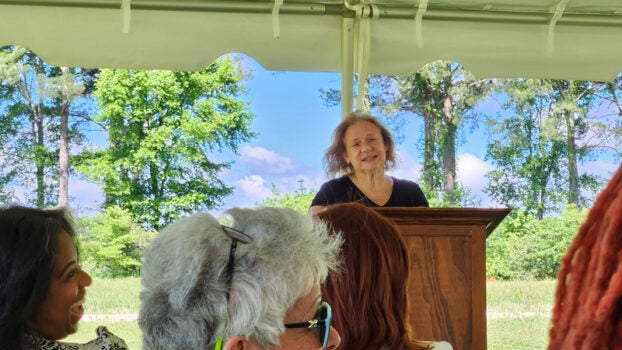
Pat Bernhausen, Surry County tourism coordinator and chairwoman of the county’s VA250 Committee, delivers remarks.

Virginia Tourism Corporation President and CEO Rita McClenny delivers remarks.

Kickoff attendees board a tour bus to view the Surry County cultural trail.
In 1860, a year before the start of the Civil War, over a third of Surry County’s African American population had already been freed from slavery under a 78-year-old, circa-1782 Virginia General Assembly law.
It’s not something Bacon’s Castle District Supervisor Walter Hardy Jr. learned from a textbook as a product of the county’s public school system. He stumbled across the information years later from Preservation Virginia, the nonprofit organization that owns and maintains the circa-1665 Bacon’s Castle homestead.
Hardy was one of several speakers at the May 16 launch of Surry’s cultural trail, a driving tour of 29 historic sites throughout the county that aims to highlight overlooked stories of Black and indigenous county residents.
Subscribe to our free email newsletter
Get the latest news sent to your inbox
The trail is the brainchild of Surry’s VA250 Committee, a 16-member chapter of the Virginia American Revolution 250 Commission. The statewide body formed in 2020 to plan Virginia’s 2025 commemoration of the 250th anniversary of the Revolutionary War, which began on April 19, 1775, with an exchange of gunfire between American colonists and British troops in Massachusetts.
“The first colonists arrived in Virginia,” states VA250’s website. “The first encounters with indigenous peoples occurred here. The first ships carrying the enslaved landed here. The first representative government was formed here. The famous speeches, critical debates and major events that led to the movement for independence and sparked a revolution happened here.”
“You can’t change history,” but “sometimes people don’t say everything that should be said about history,” said Surry VA250 Committee member Gloria Howell Mason.
The trail includes new perspectives on well-known historic sites like Chippokes State Park, whose history dates back centuries before the circa-1854 Jones-Stewart antebellum plantation mansion. Chippokes is, in fact, named for Choapoke, an Algonquin chief. According to its trail listing, Chippokes was home for hundreds of years to the Quiyoughcohannock tribe prior to 1619.
Also on the list is Mount Nebo Baptist Church, an active congregation that traces its roots to 1865 when the Freedmen’s Bureau in Philadelphia, Pennsylvania, sent Amelia Howard to establish churches and schools for newly emancipated Blacks.
The driving tour can be accessed via the “Visit Surry County, VA” app, available for download on Google Play for Android or the App Store for iPhone. The stories shared on the app include oral histories told to the Surry VA250 Committee by Ernest Poole of Poole’s Funeral Home, the oldest continuously operating business in the county; David Burnell and his late father, James Pleasant Burrell, who are descendants of Surry’s pre-Civil War free Black population; and several other interviews.
These are the stories that “some maybe try to take out of the textbook,” said Rita McClenny, president and CEO of the Virginia Tourism Corp.
“It is all about telling a complete story,” McClenny said.
State Sen. Lashrecse Aird, D-Petersburg, whose legislative district includes Surry, also spoke at the kickoff ceremony of what she described as a “concerted effort” across Virginia to dictate “what is to be shared and what is not to be” when it comes to Black history.
Gov. Glenn Youngkin’s Executive Order No. 1, which Aird didn’t refer to by name, sparked controversy in 2022 by mandating an end to what it termed “inherently divisive concepts” in schools. The controversy has largely spared Surry though neighboring Isle of Wight County’s School Board last year barred teaching on “systemic racism” in a policy asserting “there is no systemic racism or bigotry perpetuated by the United States or any governmental entity.”
The kickoff concluded with a bus tour of the trail.
Featured Local Savings

Special education needs rising in Isle of Wight

Smithfield VA Events donates over $236,000 for 2023-24 season

Surry schools superintendent to retire
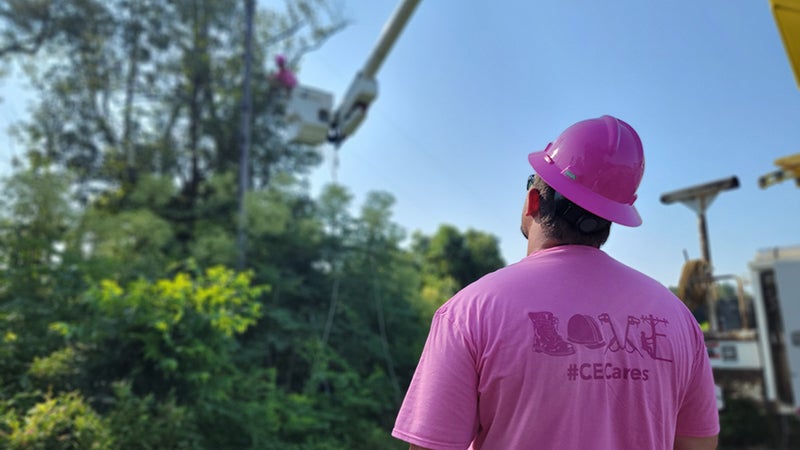
Community Electric technicians to fly drones at utility worker competition
Special sections.
- Small Business
- © 2024, Smithfield Times

IMAGES
VIDEO
COMMENTS
Algonquin Adventure Tours features over a dozen different guided experiences in Algonquin Park. Welcoming guests from all over Canada and all around the world, their guided tours reach all levels of desired adventure. From their 5-day canoe safaris (90% likelihood of seeing a moose) to their 3 hour Algonquin motor canoe trip, or their 3 hour ...
Algonquin driving and bus tours. An Algonquin Park bus tour or driving tour can be a great introduction to the park for first-time visitors. Highway 60 traverses Algonquin from east to west, a twisting two-lane road that winds through nearly 60 km of amazing scenery, past sparkling lakes and vibrant forest.
The Algonquin Park Driving Tour is a kind of digital storytelling. It makes use of some pretty fancy technology to share stories using audio, text, visual, hyper linked resources and so on. Specifically, it's a type of digital readers' theatre, where actors present dramatic readings of written texts, in this case news articles published ...
4. 3 Hour VIP Electric Canoe Photography Tour (private, price is for 2 people) 25. Private and Luxury. 3 hours. A VIP private wildlife and landscape photography canoe tour. The history of Algonquin Park, Canoe Lake and Tom Thomson is…. Recommended by 96% of travellers. from. C$299.
Algonquin Park driving and bus tours. An Algonquin Park bus tour or driving tour can be a great introduction to the park for first-time visitors. Highway 60 traverses Algonquin from east to west, a twisting two-lane road that winds through nearly 60 kilometres of amazing scenery, past sparkling lakes and vibrant forest. ...
Created in 1893, Algonquin is the oldest provincial park in Canada and the largest in Ontario. An easy day's drive from Toronto, Ottawa or Montreal, it's also one of the most popular. Algonquin covers 7,630 square kilometres, roughly the same size as Delaware and Rhode Island combined. Much of the park is unspoiled backcountry that contains ...
Welcome to Algonquin Adventure Tours, the #1 rated Algonquin Park educational guide service & tour company. Since 1996, we have provided all inclusive guided multiday canoe tripping safaris, canoe day trips, and a variety of educational day tours, in Algonquin Provincial Park. ... An easy drive from Montreal, Toronto, Ottawa or Muskoka ...
Top Things to Do in Algonquin Provincial Park, Ontario: See Tripadvisor's 5,742 traveller reviews and photos of Algonquin Provincial Park tourist attractions. Find what to do today, this weekend, or in May. ... Smartphone Audio Driving Tour between Parry Sound & Toronto. 1. Historical Tours. from . C$7. per group (up to 15) Smartphone Audio ...
INCLUDES: PRICE $199.00 PER PERSON. TO BOOK YOUR TOUR PLEASE CALL: 1 (866) 614-5355 or email us at: [email protected]. Join our Lodge Naturalist on a private guided tour of Algonquin Park and visit famous sites featured in the artwork of Tom Thomson.
Take a break from the bustle of Toronto and head into nature for a day. Visit Canada's oldest provincial park on a guided excursion. Get picked up from the meeting point and drive to Algonquin. Spend an enriching 6 hours at the park snowshoeing, hiking, spotting wildlife, canoeing, and swimming. Whether you visit in spring, summer, fall, or ...
Algonquin Provincial Park is a favorite amongst Canadians and visitors from abroad for enjoying nature. The park is over 7000 kilometers squared of wilderness, and has over 1500 inland lakes. There are 14 designated hiking trails within the park, and over 2000 canoe routes (including portaging).
Getting to/ around Algonquin Provincial Park, Ontario. The most popular way to get to Algonquin Park is by self-driving. Algonquin Park is 2 hours and 42 minutes west of Ottawa (243.2 kilometres) and 2 hours and 50 minutes north of Toronto (276 kilometres). Those without a car can catch the Park Bus from downtown Toronto.
Algonquin Park has a free new driving tour experience that will fill you in on the history of the area as you drive in to your site. Check it out here! Best Hiking Trails in Algonquin Provincial Park . There are dozens of trails that range from easy to experienced in and around Algonquin Provincial Park. Whatever your mood or comfort level ...
Track and Tower Trail: A 7.5 km loop that takes you through history and scenic vistas. Ideal for those looking to combine hiking with a bit of park history. Centennial Ridges Trail: This 10.4 km loop is a more challenging hike, known for its stunning panoramic views and ideal for experienced hikers. Peck Lake Trail: Perfect for a shorter, easier 1.9 km loop.
Algonquin Park Adventure Tours, Algonquin Park, Ontario. 3,197 likes · 4 talking about this · 326 were here. Guided multiday Algonquin Provincial Park canoe trips, and Glamping camping, for...
Program Details This Algonquin Park guided group canoe day trip is the perfect way to experience 'canoe tripping' without having to sleep in a tent.Your 6 hour adventure navigates into secluded corners of Algonquin Provincial Park. We paddle across historic Canoe Lake, carry over an easy 300m portage and enjoy a lakeside meal (Henrietta's meat or veggie sandwich & granola bar) on all tours.
Instead, you can take the 404 on the east side of Lake Simcoe. Enter Algonquin through the East Gate - Highway 60 (the road that goes through Algonquin Park) can be incredibly slow, especially in the West-to-East direction. To avoid driving the 400 AND Highway 60, you can take the 407 eastbound, go by Peterborough and north to Whitney.
Algonquin Outfitters offers options for both guided day trips and overnight camping experiences in the park's interior. For multi-day canoe camping trips, you can choose the guide service level that best suits your needs and budget: our exclusive "Custom Guided Trip" with our Ultimate Outfitting food and equipment package, the innovative ...
7.40 am - Dufferin Mall, 904 Dufferin street Toronto, meeting is in front of the Beer Store 8.00 am - Ripley's Aquarium, 288 Bremner Blvd, Toronto. Return Location. Wilson subway station or Dufferin subway station. Tour Start Date & Time. May 5, 2024 8:00 am View other Times.
Day Use. Permits for those visiting Algonquin Park and do not require overnight accommodation. Day use permits are valid from 7:00am to 10:00pm. Daily Vehicle Permit - Permit required for non-overnight use of Algonquin Park. Seasonal (Day Use) Permit - Permit for unlimited day use access during a season. Valid for all provincial parks in Ontario.
Visit their Interactive Trail Guide, and in the top right corner select the Snow Tours drop-down. Choose Eastern Ontario > R.A.P. Known as the grand daddy of sled tours, this 850km loop of World famous Algonquin Park is a must-do tour for sledders in Ontario. By far the most popular loop in Ontario, many return year after year to get their fix.
For official map representation of provincial parks, visit Ontario's Crown Land Use Policy Atlas. Algonquin. Gatehouse - East Gate. Latitude: 45.536921. Longitude: -78.265419. Algonquin. Achray Campground - From Sand Lake Gate, follow Barron Canyon Road for 19.2 km, then turn left onto Achray Road. Proceed 4.8 km to the access point and Achray ...
Niagara Falls Day Tour From Toronto with Fast track Niagara Cruise. 46. from $140.87. Toronto, Ontario. Niagara Falls Day and Evening Tour With Boat Cruise & Dinner (optional) 559. from $155.78. Toronto, Ontario. Niagara Falls Day Tour with Hornblower Cruise from Toronto.
Proposed Recipient: City of Batavia. Recipient Address: 100 N Island Avenue, Batavia, IL 60510-1930. Project Location: West bank of the Fox River at approximately 400 Shumway Ave, Batavia, IL 60510. Amount Requested: $8,166,000. Description of Request: This project includes construction of a new segment of the Fox River Regional Trail in Batavia.
Surry debuts driving tour highlighting Black, indigenous history. Published 4:14 pm Thursday, May 16, 2024 ... The trail includes new perspectives on well-known historic sites like Chippokes State Park, whose history dates back centuries before the circa-1854 Jones-Stewart antebellum plantation mansion. ... an Algonquin chief. According to its ...